Nokia Solutions and Networks PCS002 User Manual IMN BTSE BS11
Nokia Solutions and Networks IMN BTSE BS11
Contents
- 1. User manuals index
- 2. BS11 Introduction
- 3. BS11 Installation
- 4. BS11 Installation test
BS11 Installation

Installation
Base Transceiver Station Equipment
IMN:BTSE BS11 DRAFT
A30808-X3247-B359-2-7631

CAUTION
Note: This equipment has been tested and found to comply with the
limits for a Class A digital device, pursuant to part 15 of the FCC
Rules. These limits are designed to provide reasonable protection
against harmful interference when the equipment is operated in a
commercial environment. This equipment generates, uses, and can
radiate radio frequency energy and, if not installed and used in
accordance with the instruction manual, may cause harmful
interference to radio communications. Operation of this equipment in a
residential area is likely to cause harmful interference in which case
the user will be required to correct the interference at his own
expense.

Siemens AG 1998
Issued by the Public Communication Networks Group
Hofmannstraße 51, D-81359 München
Technical modifications possible
Technical specifications and features are binding only
insofar as they are specifically and expressly agreed
upon in a written contract.
2

Installation Base Transceiver
IMN:BTSE BS11 Station Equipment
A30808-X3247-B359-2-7631 3
Issues
Note on the change indication:
The change indications for a title marked as issue 1 refer to the previous version.
The change indications for a title with an issue greater than 1 refer to the
preceding issue.
Change indications (Ind.):
N = new G = modified; 0 = deleted;
Document Title Page(s) Issue/Ind.
Register
IMN/ITMN:BTSE IS 1...87 2 N
This document consists of a total of 87 pages.

Base Transceiver Installation
Station Equipment IMN:BTSE BS11
4A30808-X3247-B359-2-7631

Installation Base Transceiver
IMN:BTSE BS11 Station Equipment
A30808-X3247-B359-2-7631 5
Contents
1. General...........................................................................................9
1.1. Purpose of the Manual ....................................................................9
1.2. Overview Base Transceiver Station.................................................9
1.2.1. Main Tasks .....................................................................................9
1.2.2. Standard Technical Features ........................................................10
2. BS-11i Installation .........................................................................11
2.1. Site Requirements.........................................................................11
2.2. Site Configuration..........................................................................12
2.3. Construction View of the BTSE .....................................................13
2.4. Equipment Delivery .......................................................................14
2.4.1. Preliminary Checks .......................................................................14
2.4.2. BTSE Unpacking...........................................................................14
2.4.3. Installation Kit Unpacking ..............................................................15
2.4.4. Spare parts for field maintenance..................................................15
2.5. Wall Mounting of the BTSE ...........................................................16
2.5.1. Installation Tools...........................................................................16
2.5.2. Ancillary Material...........................................................................16
2.5.3. BTSE Installation Procedure .........................................................16
2.5.4. Antenna mounting.........................................................................19
2.5.5. Solar shield mounting....................................................................19
2.6. Pole Mounting of the BTSE...........................................................22
2.6.1. Installation Tools...........................................................................22
2.6.2. Ancillary Material...........................................................................22
2.6.3. BTSE Installation Procedure .........................................................22
2.6.4. Antenna mounting.........................................................................28
2.6.5. Solar shield mounting....................................................................28
2.7. External Cabling Activities.............................................................28
2.7.1. Ground and Power Supply Connections ........................................30
2.7.2. Abis Interface - PCM 30 Link Equipment .......................................32
2.7.3. Connection to the J01 connector...................................................36
2.8. Post Installation Notes ..................................................................36
3. BS-11e Installation........................................................................39
3.1. Site Requirements.........................................................................39
3.2. Site Configuration..........................................................................40
3.3. Construction View of the BTSE .....................................................41
3.4. Equipment Delivery .......................................................................42
3.4.1. Preliminary Checks .......................................................................43
3.4.2. BTSE Unpacking...........................................................................43
3.4.3. Installation Kit Unpacking ..............................................................43
3.4.4. Spare parts for field maintenance..................................................44
3.5. Wall Mounting of the BTSE ...........................................................44
3.5.1. Installation Tools...........................................................................44
3.5.2. Ancillary Material...........................................................................45
3.5.3. BTSE Installation Procedure .........................................................45
3.5.4. Dummy panel mounting ................................................................47
3.5.5. Solar shield mounting....................................................................47
3.6. Pole Mounting of the BTSE...........................................................49
3.6.1. Installation Tools...........................................................................49
3.6.2. Ancillary Material...........................................................................49

Base Transceiver Installation
Station Equipment IMN:BTSE BS11
6A30808-X3247-B359-2-7631
3.6.3. BTSE Installation Procedure .........................................................49
3.6.4. Solar shield mounting....................................................................55
3.7. External Cabling Activities.............................................................55
3.7.1. Ground and Power Supply Connections ........................................57
3.7.2. Abis Interface - PCM 30 Link Equipment .......................................59
3.7.3. Connection to the J01 connector...................................................63
3.8. Antenna Connections....................................................................63
3.8.1. Antenna System Fulmination Protection........................................65
3.8.2. Antivandalism Protection...............................................................65
3.8.3. Cable Down-Leads........................................................................65
3.8.4. Interconnection Plate ....................................................................65
3.9. Post Installation Notes ..................................................................67
4. Appendix.......................................................................................69
4.1. AC Main Connector.......................................................................69
4.1.1. Connector type..............................................................................69
4.1.2. General view.................................................................................69
4.1.3. Dimensions (mm)..........................................................................69
4.1.4. Technical characteristics ...............................................................69
4.1.5. Materials.......................................................................................70
4.1.6. Pinning of Power Supply Socket....................................................70
4.1.7. Mounting of the cable-Movable socket...........................................70
4.2. PCM Connector ............................................................................71
4.2.1. Straight connector type .................................................................71
4.2.2. General view.................................................................................71
4.2.3. Dimensions (mm)..........................................................................72
4.2.4. General view.................................................................................72
4.2.5. Mounting of cable on connector.....................................................72
4.2.6. Connections..................................................................................73
4.3. RF Connector Type N N15015 C4 GN-1 .......................................74
4.3.1. Connector type..............................................................................74
4.3.2. General view.................................................................................75
4.3.3. Dimensions (mm)..........................................................................75
4.3.4. Technical characteristics ...............................................................75
4.3.5. Materials.......................................................................................76
4.4. RF Connector Type N N15022 C4 G-1..........................................76
4.4.1. Connector type..............................................................................76
4.4.2. General view.................................................................................76
4.4.3. Dimensions (mm)..........................................................................76
4.4.4. Technical characteristics ...............................................................77
4.4.5. Materials.......................................................................................77
4.5. RF Connector Type N for ½” cable................................................77
4.5.1. Connector type..............................................................................77
4.5.2. General view.................................................................................78
4.5.3. Dimensions (mm)..........................................................................78
4.5.4. Technical characteristics ...............................................................78
4.5.5. Materials.......................................................................................79
4.6. Alarm Connector ...........................................................................79
4.6.1. Connector type..............................................................................79
4.6.2. General view.................................................................................79
4.6.3. Pinning of J01 connector...............................................................80
4.6.4. Mounting of the straight cable socket ............................................80
4.7. Coaxial Cables..............................................................................81
4.7.1. ½” cable (OTE code: 22580000175)..............................................81

Installation Base Transceiver
IMN:BTSE BS11 Station Equipment
A30808-X3247-B359-2-7631 7
4.7.2. Cable RT 5020..............................................................................81
4.8. Alarm Cable (OTE Code 22401200528)........................................82
4.9. Radio Frequency Cables Assembly...............................................83
4.9.1 ½” Cable Assembly to type “N” connectors (dimensions in mm)....83
4.9.2 RT 5020 Cable Assembly..............................................................84
4.10. LMT Cable for BTSE.....................................................................85
4.10.1. Composition of LMT Cable............................................................85
4.10.2. General view.................................................................................86
5. Abbreviations................................................................................87

Base Transceiver Installation
Station Equipment IMN:BTSE BS11
8A30808-X3247-B359-2-7631
Illustrations
Fig. 1.1. BTSE in the SBS architecture .......................................................10
Fig. 2.1. Site Configuration..........................................................................12
Fig. 2.2. BTSE: Location of boards and modules (BiTRX) ...........................13
Fig. 2.3. Holes for wall mounting .................................................................17
Fig. 2.4. BTSE: Wall mounting frame..........................................................18
Fig. 2.6. Connector panel cover ..................................................................21
Fig. 2.7. Antenna connections (BiTRX internall antenna).............................21
Fig. 2.8. BTSE: Pole mounting frame without tilting mechanism ..................24
Fig. 2.9. Buckle slided on band ...................................................................25
Fig. 2.10. Band around pole..........................................................................25
Fig. 2.11. Apply tension ................................................................................26
Fig. 2.12. Tightening.....................................................................................26
Fig. 2.13. Rolling tool ....................................................................................27
Fig. 2.14. Cutting the band............................................................................27
Fig. 2.15. Removing tool...............................................................................27
Fig. 2.16. Hammering buckle ears ................................................................28
Fig. 2.17. Connection panel ..........................................................................30
Fig. 2.18. Ground and power supply connections (example) .........................32
Fig. 2.19. STAR/MULTIDROP Configuration.................................................33
Fig. 2.20. Multidrop configuration Functions of Y01 ÷ Y04 connectors...........34
Fig. 2.21. Star configuration Functions of Y01 ÷ Y04 connectors ..................35
Fig. 2.22. Connection Panel..........................................................................35
Fig. 2.23. Y01 ÷ Y04, J01 and J02 connectors..............................................36
Fig. 3.1. Site Configuration..........................................................................41
Fig. 3.2. BTSE: Location of boards and modules (BiTRX) ...........................42
Fig. 3.3. Holes for wall mounting .................................................................46
Fig. 3.4. BTSE: Wall mounting frame..........................................................47
Fig. 3.5. Solar shield mounting....................................................................48
Fig. 3.6. BTSE: Pole mounting frame..........................................................51
Fig. 3.7. Buckle slided on band ...................................................................52
Fig. 3.8. Band around pole..........................................................................52
Fig. 3.9. Apply tension ................................................................................53
Fig. 3.10. Tightening.....................................................................................53
Fig. 3.11. Rolling tool ....................................................................................54
Fig. 3.12. Cutting the band............................................................................54
Fig. 3.13. Removing tool...............................................................................54
Fig. 3.14. Hammering buckle ears ................................................................55
Fig. 3.15. Connection panel ..........................................................................57
Fig. 3.16. Ground and power supply connections (example) .........................59
Fig. 3.17. STAR/MULTIDROP Configuration.................................................60
Fig. 3.18. Multidrop configuration Functions of Y01 ÷ Y04 connectors...........61
Fig. 3.19. Star configuration Functions of Y01 ÷ Y04 connectors ..................62
Fig. 3.20. Connection Panel..........................................................................62
Fig. 3.21. Y01 ÷ Y04, J01 and J02 connectors..............................................63
Fig. 3.22. Antenna Cabling............................................................................64
Fig. 3.23. Cable Pass Plate ..........................................................................66
Fig. 3.24. Interconnection Plate ....................................................................67

Installation Base Transceiver
IMN:BTSE BS11 Station Equipment
A30808-X3247-B359-2-7631 9
1. General
The CE declaration of conformity for the product will be fulfilled if the setup and
cabling is undertaken in accordance with the specification in the manual and the
documentation listed there, such as mounting instructions, cable lists etc. Where
necessary, account should be taken of project-specific documentation.
Deviations from the specifications or independent changes during setup, such as
use of cable types with lower screening values, for example, can lead to the CE
requirements being violated. In such cases the CE declaration of conformity is
invalidated and the responsibility passes to the person who has caused the
deviations.
1.1. Purpose of the Manual
This document is intended to give information necessary to the installation of the
BTSE for the SBS Base Station System (BSS).
It contains the description of all steps to install the BTSE on site and the
integration into the required infrastructure:
- Power supply.
- PCM30 - Network.
- Grounding.
- Receive / transmit antenna system.
- Alarm connections.
1.2. Overview Base Transceiver Station
1.2.1. Main Tasks
The BTSE performs the following main tasks in accordance with the GSM-
requirement (D900):
- Provides the RF-link connection to the mobile stations (MS).
- Supports various cell types (omni cells).
- Provides the 2Mbit PCM30 link connection to the Base Station Controller
(BSC) via a terrestrial line (in this case symmetric pair or coax cable is used).
- Submultiplexing on the Abis-interface.
- Multidrop loop and star PCM 30 link connection.
The BTSE is preset to send the four alarm signals detected by it according to the
closed contact logic: alarm transmission, open contact: no alarm.
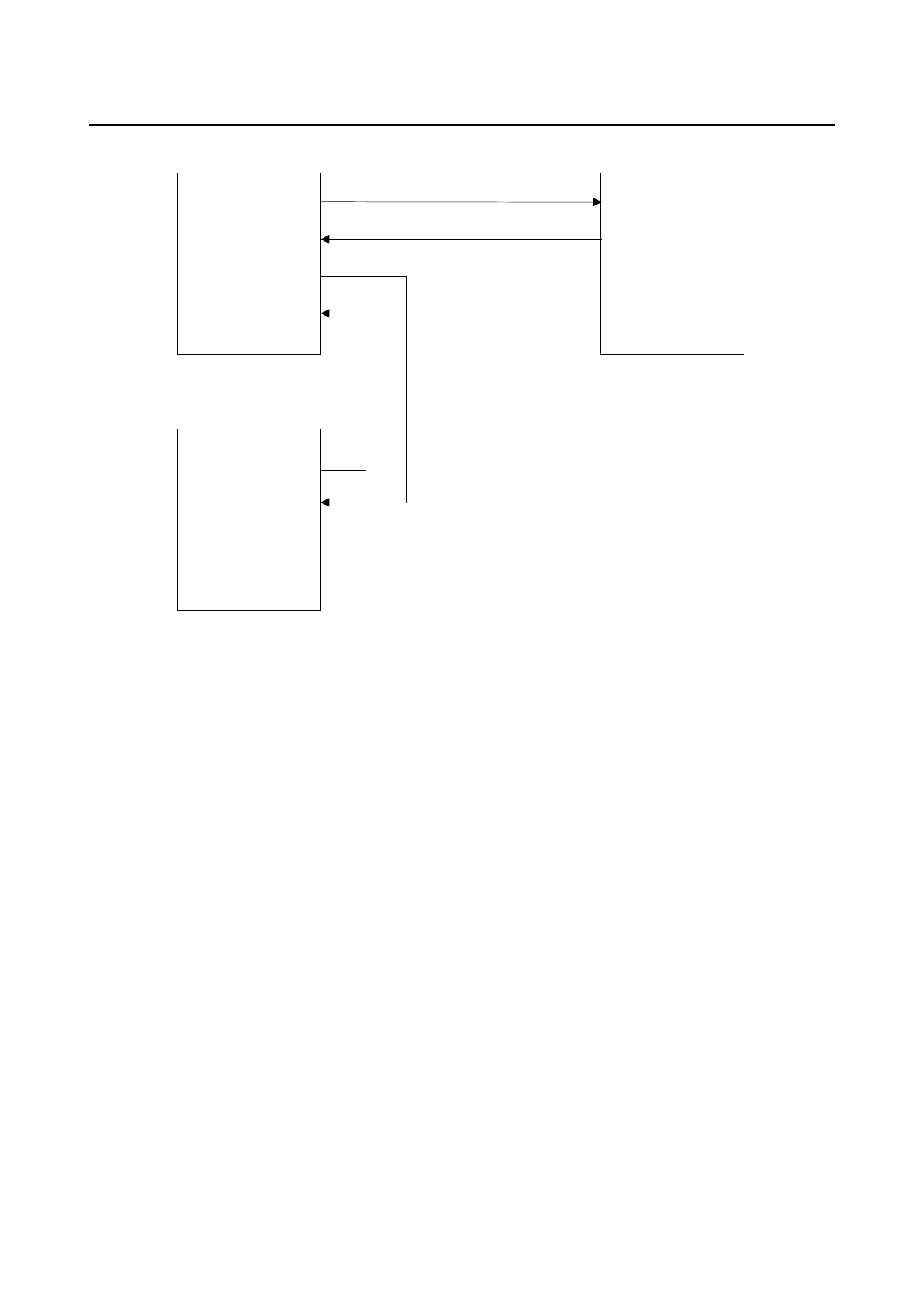
Base Transceiver Installation
Station Equipment IMN:BTSE BS11
10 A30808-X3247-B359-2-7631
YØ2
BSC
YØ4
YØ3
Tx
Rx
Tx
Rx
BTSE
BTSE
YØ1
YØ2
YØ1
Fig. 1.1. BTSE in the SBS architecture
The Micro-Base Transceiver Stations are a modular family of BTS-products:
with internal antenna and 1 TRX: BS-11i/900.1 BS-11i/1800.1
with external antenna and 1 TRX: BS-11e/900.1 BS-11e/1800.1
with internal antenna and 2 TRX: BS-11i/900.2 BS-11i/1800.2
with external antenna and 2 TRX: BS-11e/900.2 BS-11e/1800.2
1.2.2. Standard Technical Features
- BS11/900 GSM 900 including Extended GSM
Frequency Band (880-915 Mhz, 925-960 MHz).
- BS11/1800 DCS 1800, Frequency Band: 1710-1785 MHz, 1805-1880 MHz.
- Hardware for 8/16 Kb/s sub-multiplexing on Abis interface.
- BS11/900 M1, M2, M3 and 2 Watt GSM Power
Classes.
- BS11/1800 M1, M2, M3 and 3 Watt DCS Power Classes.
- Two receiving chains for diversity.
- Hardware for realization of star and multidrop connection.
- Wall and pole mount kit.

Installation Base Transceiver
IMN:BTSE BS11 Station Equipment
A30808-X3247-B359-2-7631 11
2. BS-11i Installation (Internal antenna)
2.1. Site Requirements
The BS-11i (i is intended for internal antenna), called BTSE, is suitable for indoor-
and outdoor operation.
The BTSE is protected from dust, rain and other external factors. The protection
facilities are the following:
- IP 54.
- Burglar proof cabinet.
- Lightning arrestors on power supply and PCM 30 input.
- Connector protection cover supplied with wrenches and anti-intrusion
microswitch.
Prior to the commencement of the installation, the site must have been prepared
as follows:
- A wall of min. 1,50 kN/m² load-carrying capacity is required for wall mounting
or, for pole mounting the pole dimensions must be sufficient to support the
weight of the BTSE. For a maximum wind speed of 160 km/h, the BTSE
produces a 400 kg load.
- The installation area should be clear of standing water, fallen leaves, mud
and building debris.
- Necessary precautions should be taken against unauthorized access during
the
installation works.
- The lightning and grounding systems must be completed and tested.
- All installation works of 230 V AC or 110 V AC power supply must be
finished.
- The PCM30 cables must have been installed.
- The cables of the alarm signals must have been preset to be – if necessary –
connected to the BTSE later on.
- All the cables must be brought into the immediate vicinity of the BTSE,
leaving 30 cm for the following operation of abutment of the cables to the
BTSE connectors.
Whenever the Client considers it necessary, for the purpose of protecting the
cables from attacks of vandalism, it is advisable to pass the cables through steel
or galvanized iron tubes raceways.
It is advisable to make the 220 Vac power supply cables pass through a tube or
raceway different from those used for the signal cables. Alternatively, it is
possible to make all the cables pass through the same raceway, separating,
however, the signal cables from the power supply cables by means of an
insulating partition placed inside the raceway.
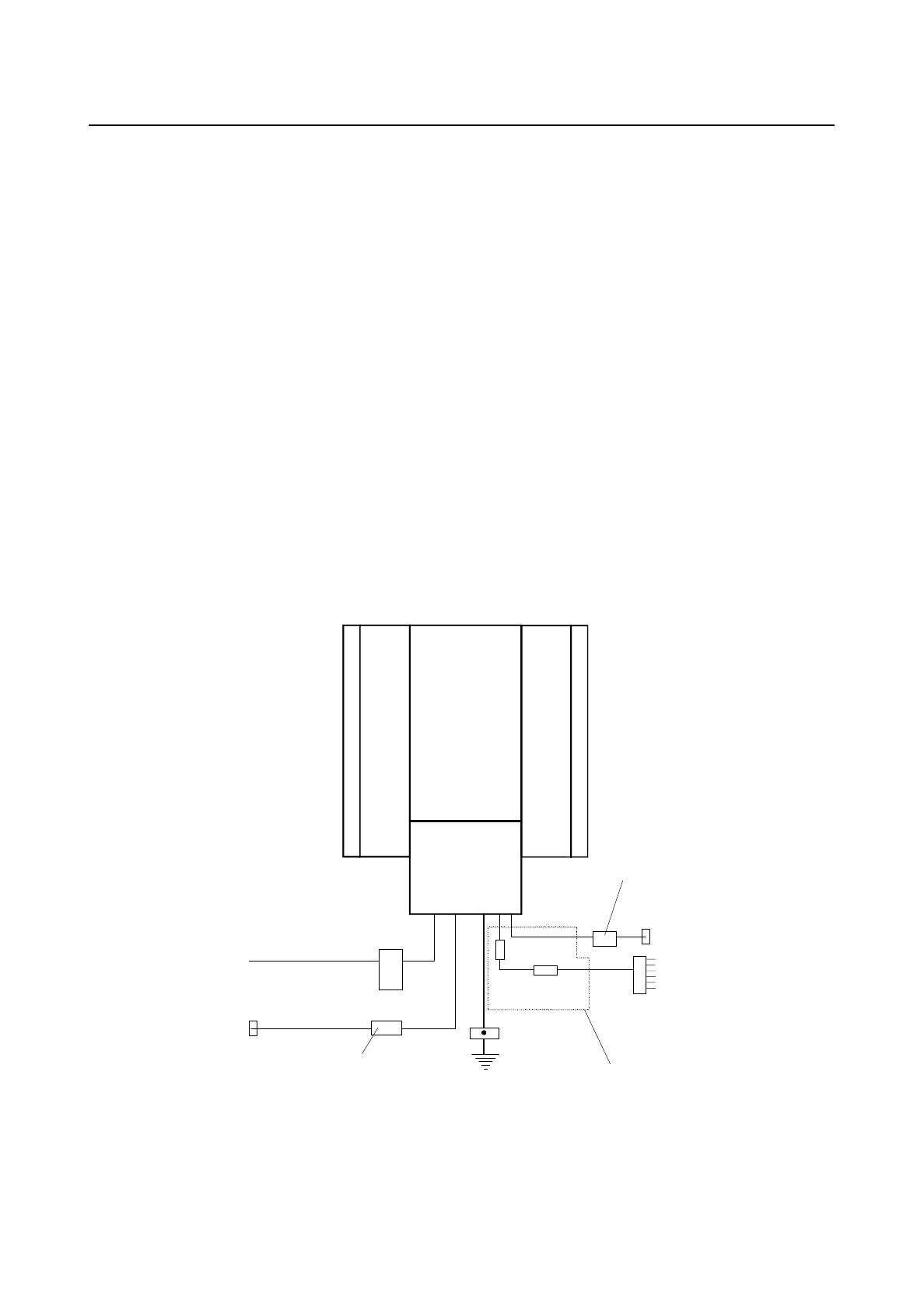
Base Transceiver Installation
Station Equipment IMN:BTSE BS11
12 A30808-X3247-B359-2-7631
As detailed in para. 2.7.1., the BTSE can accept power supply voltage from 88 V
AC to 265 V AC with frequency from 45 Hz to 65 Hz.
Power consuption:
Mono TRX = 100 W + 120 W with heather sistem inserted from –45 to –20
degrees external temperature.
Bi TRX = 200 W + 120 W with heater system inserted from –45 to –20
degrees external temperature.
2.2. Site Configuration
The installation site configuration is shown in Fig. 2.1. With regard to the alarm
signal cables laid inside the buildings, it is necessary to insert some optoinsulator
devices on their line.
It is necessary to insert overvoltage protections on the alarm signal cables line
laid outside buildings. With regard to the PCM30 cables, if considered necessary,
a sectioning block can be inserted with the terminations.
Mains (230 Vac/50 Hz)
Main breaker
PCM 30 link
Mains (230 Vac/50 Hz)
on next
BTSE ground tag
lightning
protection signalling
link terminal
to the next
BTSE
external
alarms
BTSE
PCM 30 link
optoisolator
optional
Permutator with line
terminators and
disconnecting switches
(optional)
Permutator with line
terminators and
disconnecting switches
Fig. 2.1. Site Configuration
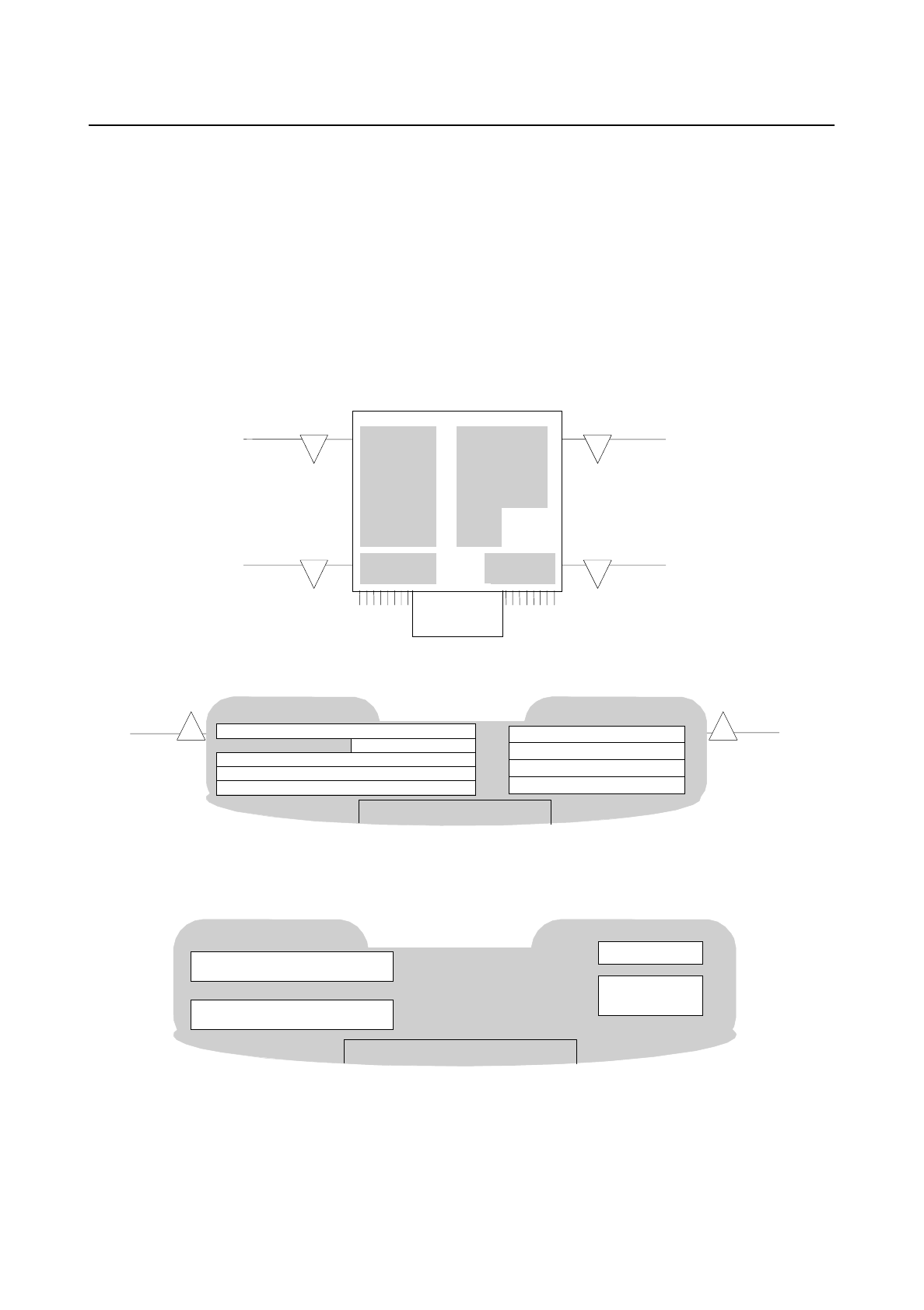
Installation Base Transceiver
IMN:BTSE BS11 Station Equipment
A30808-X3247-B359-2-7631 13
2.3. Construction View of the BTSE
The BTSE is housed in the shelter with dimensions 541 mm x 460 mm x 163 mm
(HxWxD). The integrated climate control system guarantees proper outdoor
operation (temp. range: -45° C ÷ +45° C).
The plug-in unit ACMDC (AC multiple DC converter) converts the primary input
voltage into all needed DC voltages.
A
B
A
B
PSU
PA
SECTION C-C
CC
RF-TX0
RF-RX0
SECTION A-A
SECTION B-B
PA0
FILTERS
LNA
TX
SMU
MBBCU0
ANTENNA
ANTENNA
FILTERS
PSU
PA1
MBBCU1
RF-TX1
RF-RX1
Fig. 2.2. BTSE: Location of boards and modules (BiTRX)

Base Transceiver Installation
Station Equipment IMN:BTSE BS11
14 A30808-X3247-B359-2-7631
2.4. Equipment Delivery
The rack is shipped in a carton with the dimensions 60 x 50 x 20 cm (HxWxD).
The crate can weight up to approx. 27 kg.
The packing consists of two cartons having identical dimensions (600x750x350
m) containing, respectively:
- BTSE with support for fastening and antenna (weight 35 kg BiTRX; 31 Kg
MonoTRX);
- Movable parts for fastening to pole/wall and solar shield (weight 12 kg).
Handle each carton containing installation material with extreme caution to avoid
tipping.
The crate has the following information printed on them for identification of
delivery:
- Trade mark.
- Customer order number.
- Serial number of rack or other supplied equipment.
- Destination.
- Gross and net weight.
- Overall dimensions (cm).
- Symbol or inprint to identify the “Top” and the “Bottom”.
2.4.1. Preliminary Checks
Check that the cartons are not damaged. In case of evident damage due to
transport, unpack the equipment in presence of an insurance company
representative and promptly claim any damage and inform the shipper for
specifying the damage.
Check whether the package is actually addressed to the site and complete.
Open it and take the contents out carefully.
After having removed all contents from the packing material, check for
deformation to the devices, of torn or unwelded wiring, of oxidized connectors, as
well as deformed front sides of the units, loose screws, damage to paint work etc.
2.4.2. BTSE Unpacking
During the unpacking steps great care must be taken to ensure that the BTSE is
not scratched or damaged in any way. Proceed as follows:
- Cut the straps and remove the container cover.
- Take out the BTSE from the cardboard box.
- Open the tubular PE shrink-wrap protecting the BTSE and take it out.
- Remove the dehydrating material bags fixed with the adhesive tape.
- Remove the protection to the head and to the base of the BTSE.

Installation Base Transceiver
IMN:BTSE BS11 Station Equipment
A30808-X3247-B359-2-7631 15
- Lift the BTSE in vertical position.
- Remove the profiles protecting the BTSE edges.
2.4.3. Installation Kit Unpacking
Proceed as follows:
- Open the PVC wrap protecting the carton and withdraw it.
- Remove the dehydrating material bag from the box.
- Cut with a suitable knife the adhesive tape sealing the box.
- Take the installation kit.
- Open the PVC wrap protecting the device/board and withdraw it.
The packing material should be preserved for possible future re-packing. For this
purpose, reverse the procedure described above, taking into account the
warnings specified for the packing.
Installation is facilitated by the use of the handle with which the BTSE is
equipped.
2.4.4. Spare parts for field maintenance
Suggested spare parts for field maintenance are:
Description Part Number
Sun Shield Reddish color 332-0443/02
Green solar shields 332-0443/03
Beige solar shields 332-0443/04
Neutral solar shields 332-0443/01
Internal Antenna system 131-9222/01
Wall/Pole mechanical fitting 131-9221/01
Line protection module 130-3679/01
Power supply protection module 130-3680/01
Bottom covers for connectors 350-1339/01
Fuses 2622210252
Socket head Screw 15059000039
Look Key 10350000063
As facilities for field mainenance can be used
BS 11 local maintenance terminall interface kit 131-9441/01

Base Transceiver Installation
Station Equipment IMN:BTSE BS11
16 A30808-X3247-B359-2-7631
2.5. Wall Mounting of the BTSE
2.5.1. Installation Tools
The correct rack installation is carried out with the aid of the following tools:
- Standard toolkit for BTSE installation.
- Spirit level.
- Plumb bob.
- Saw with shavings exhauster filter (for elevated floor only).
- Hammer drill.
- Drill widia
- Hammer.
- Screw driver for cross-slotted screw.
For installation of power distribution panels, cable ducts, antenna, cableways and
other infrastructure equipment, additional tools could be necessary.
2.5.2. Ancillary Material
The following ancilliary materials are needed:
- Plumb line.
- Colophony.
- Adhesive tape (yellow/green) for labelling.
- Cable fasteners.
2.5.3. BTSE Installation Procedure
Prior to the commencement of BTSE installation, consult the site documentation
to locate the installation point of the BTSE, the PCM 30 network termination, the
connection point for AC mains and the nearest ground tag.
Necessary installation material (for fixing the wall mounting frame to the wall and
for fixing the base plate to the wall) and washers for correct adjustment come with
the delivery.
Proceed in steps as follows:
- Make six holes in the wall corresponding to the holes located on bracket (Fig.
2.3.).
- Insert in the wall six wallplugs (The wallplugs are not included in the
installation kit because these wallplugs must be chosen in relation to the wall.
The wallplug must receive at least a diameter 8 mm screw.
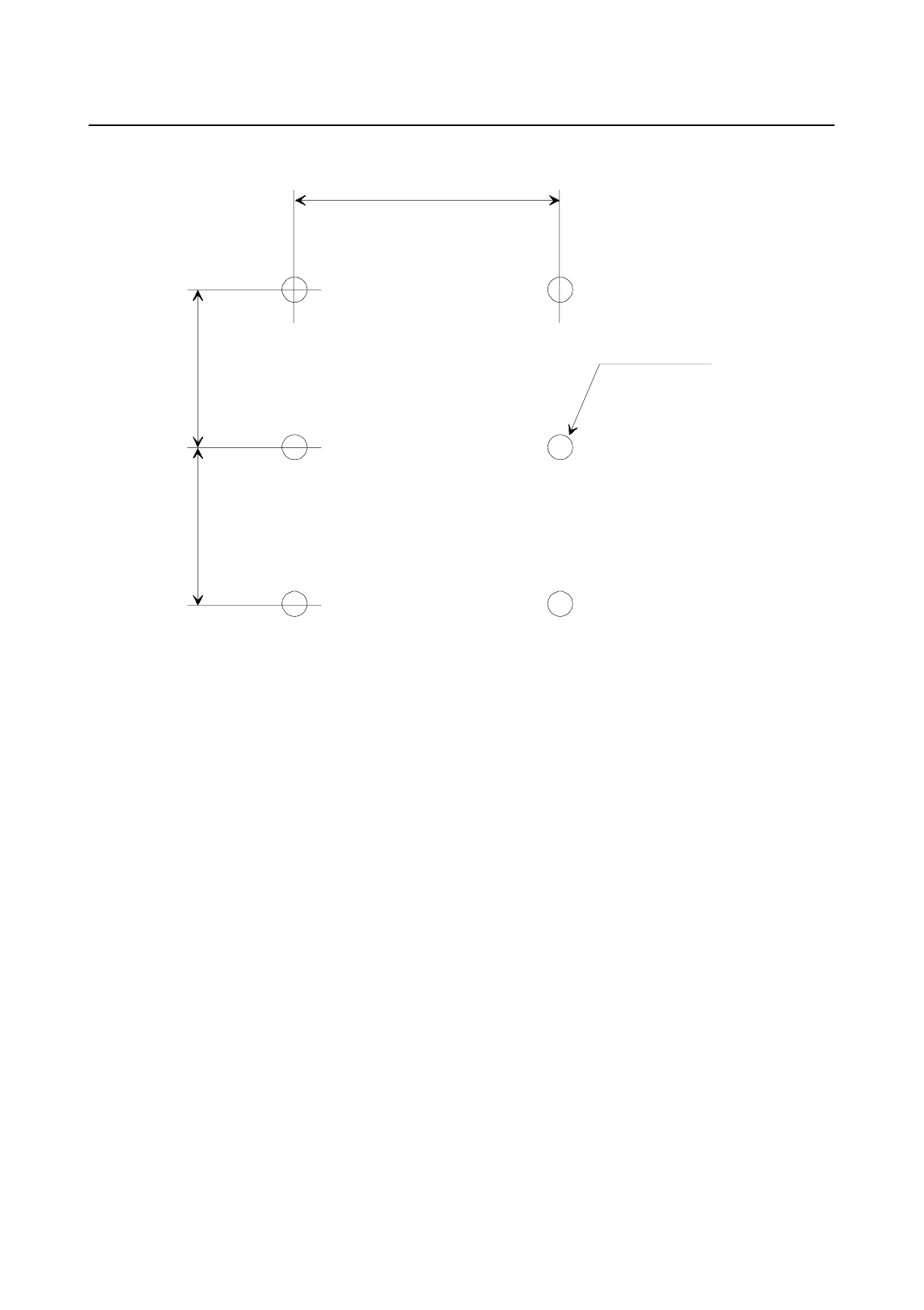
Installation Base Transceiver
IMN:BTSE BS11 Station Equipment
A30808-X3247-B359-2-7631 17
164mm
100mm100mm
6 holes diam. 9mm
Fig. 2.3. Holes for wall mounting
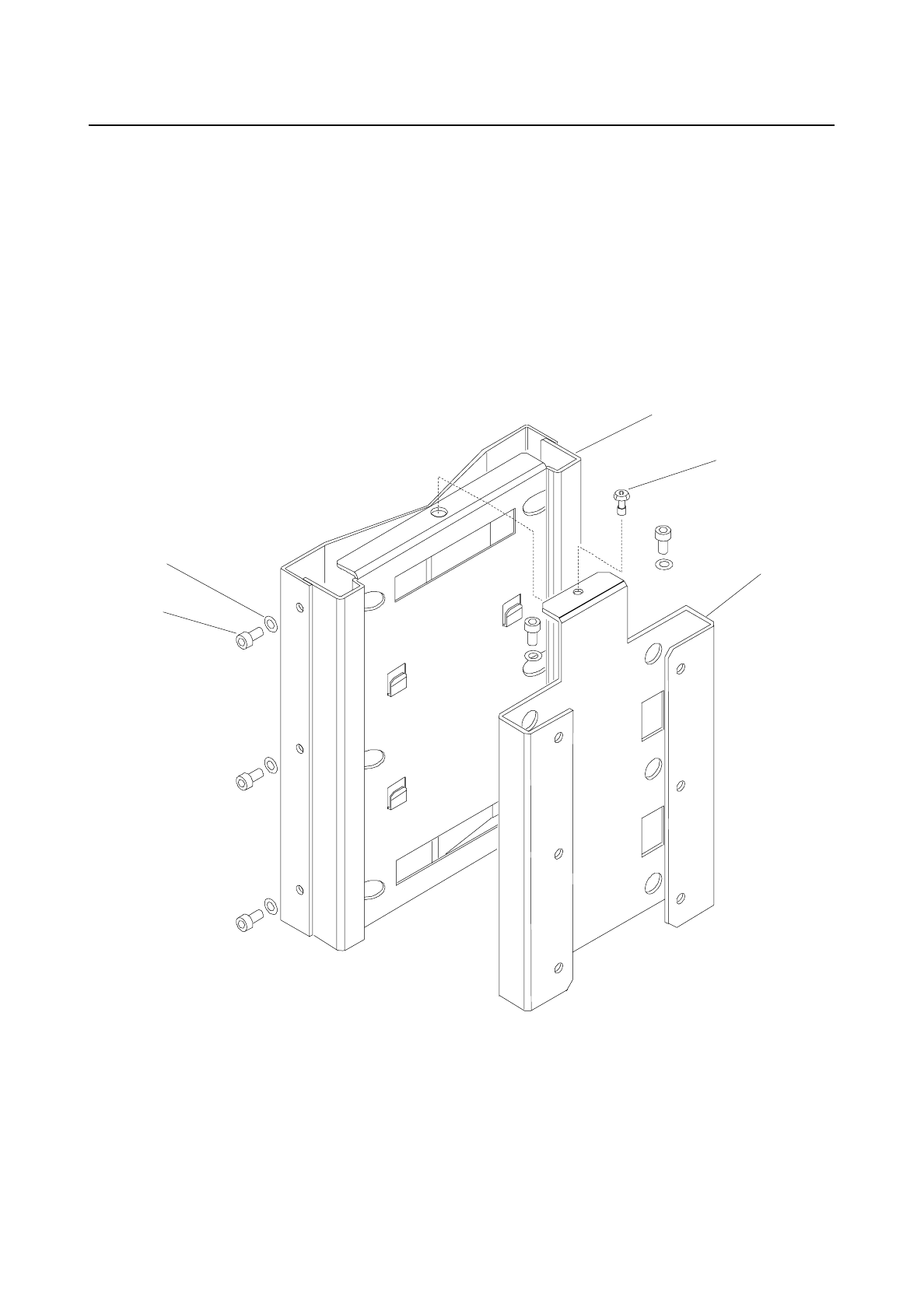
Base Transceiver Installation
Station Equipment IMN:BTSE BS11
18 A30808-X3247-B359-2-7631
- With reference to Fig. 2.4. fasten bracket (1) to the wall using six diameter 8
(2) screws and relative washers (3).
- Connect the BTSE (furnished joined with bracket (4)) to bracket (1).
- Tighten the M5 hexagonal head cap screw (5) using the proper wrench
supplied.
1
5
4
2
3
Fig. 2.4. BTSE: Wall mounting frame

Installation Base Transceiver
IMN:BTSE BS11 Station Equipment
A30808-X3247-B359-2-7631 19
2.5.4. Antenna mounting
After removing the antenna from the box, proceed as follows to install it
(Fig. 2.5.):
- Position the Antenna (1) panel on the front of the BTSE.
- Tighten the four screws (2).
- Open the lower cover (1, Fig. 2.6.) of the BTSE to gain access to the
connector panel using the appropriate wrench supplied.
- Tighten the four male type N connectors (which are connected to the antenna)
to the RF connectors placed in the BTSE as shown in Fig. 2.7.
- Make sure that the BTSE is self-protected from adjacent structures with
regard to the atmospheric discharges in accordance with the standards in
force in the Country where it is installed. If the BTSE is not self-protected, a
lightening rod must be installed.
2.5.5. Solar shield mounting
After removing the three elements that make up the solar shield from the box,
proceed as follows (Fig. 2.5.):
- Position the upper panel (3) on the top of BTSE and fasten it with the four M4
Phillips head screws (4) tightening them with the appropriate wrench.
- Position panels (5) and (6) correctly on the BTSE and fasten them with the
relative fastening screws (7) using the appropriate wrench supplied.
NOTE:
An extra screw is provided.
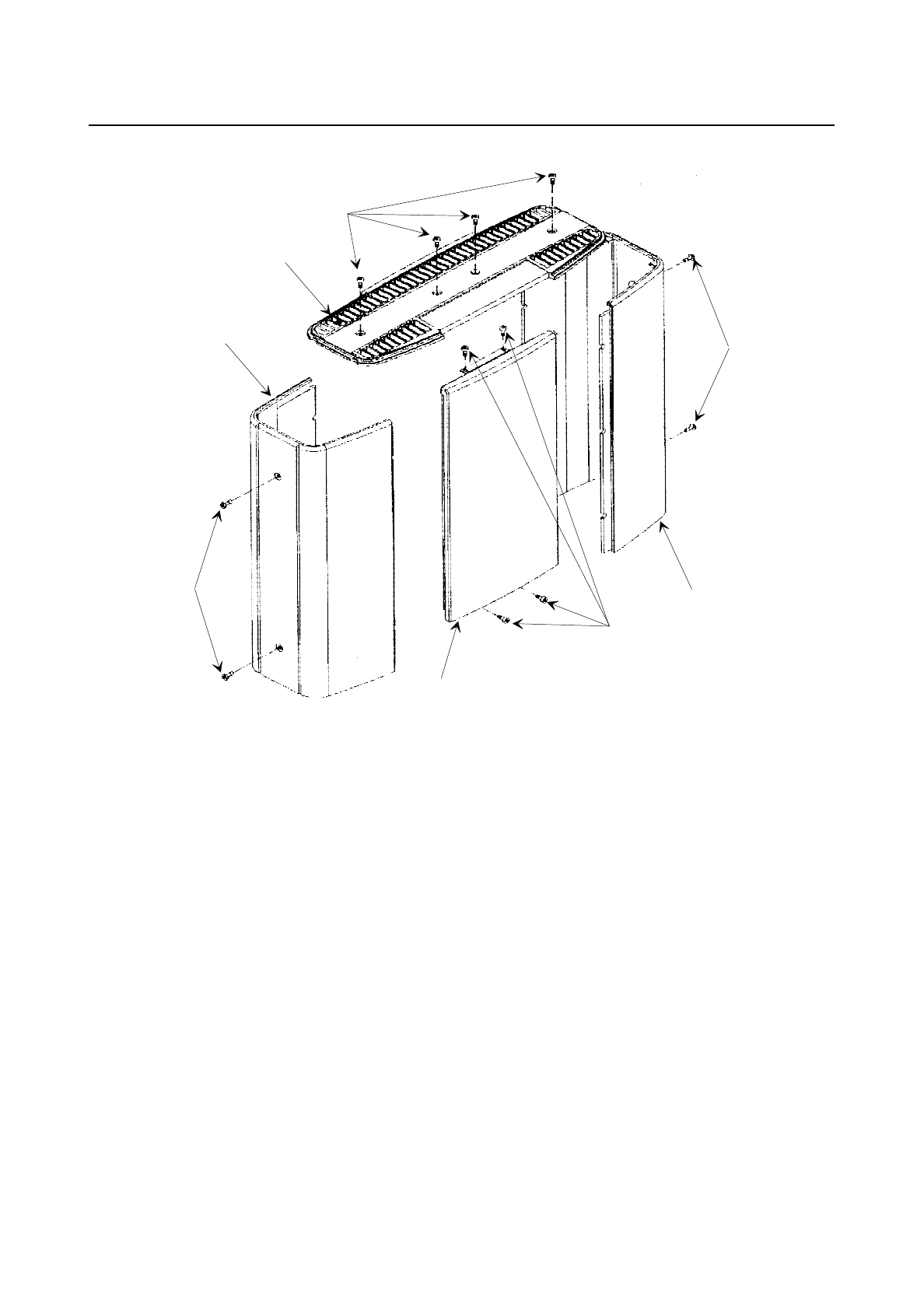
Base Transceiver Installation
Station Equipment IMN:BTSE BS11
20 A30808-X3247-B359-2-7631
4
3
7
2
7
1
5
6
Fig. 2.5. Solar shield mounting

Installation Base Transceiver
IMN:BTSE BS11 Station Equipment
A30808-X3247-B359-2-7631 21
1
Fig. 2.6. Connector panel cover
RX1
RX1
TX0
TX1
TX0
RX0
RX0 TX1
Fig. 2.7. Antenna connections (BiTRX internall antenna)

Base Transceiver Installation
Station Equipment IMN:BTSE BS11
22 A30808-X3247-B359-2-7631
2.6. Pole Mounting of the BTSE
2.6.1. Installation Tools
The correct rack installation is carried out with the aid of the following tools:
- Standard toolkit for BTSE installation.
- Spirit level.
- Plumb bob.
- Saw with shavings exhauster filter (for elevated floor only).
- Hammer drill.
- Hammer.
- Screw driver for cross-slotted screw.
For installation of power distribution panels, cable ducts, antenna, cableways and
other infrastructure equipment, additional tools could be necessary.
2.6.2. Ancillary Material
The following ancillary materials are needed:
- Plumb line.
- Colophony.
- Adhesive tape (yellow/green) for labeling.
- Cable fasteners.
2.6.3. BTSE Installation Procedure
Prior to the commencement of BTSE installation, consult the site documentation
to locate the installation point of the BTSE, the PCM 30 network termination, the
connection point for AC mains and the nearest ground tag. Necessary installation
material such as wall plugs and screws (both for fixing the wall mounting frame to
the wall and for fixing the base plate to the wall mounting frame) and washers for
correct adjustment come with the delivery.
The system selected for pole installation is the BAND IT System. Installation is
possible on poles ranging from 50 mm to 300 mm.
The following Kits of BAND IT products are available:
- BAND 19 x 0.76 mm type B x 206 q.ty 30 meters
- BUCKLE 19 mm type B x 256 q.ty 100 units
- Special BAND IT type B x 201 q.ty 1
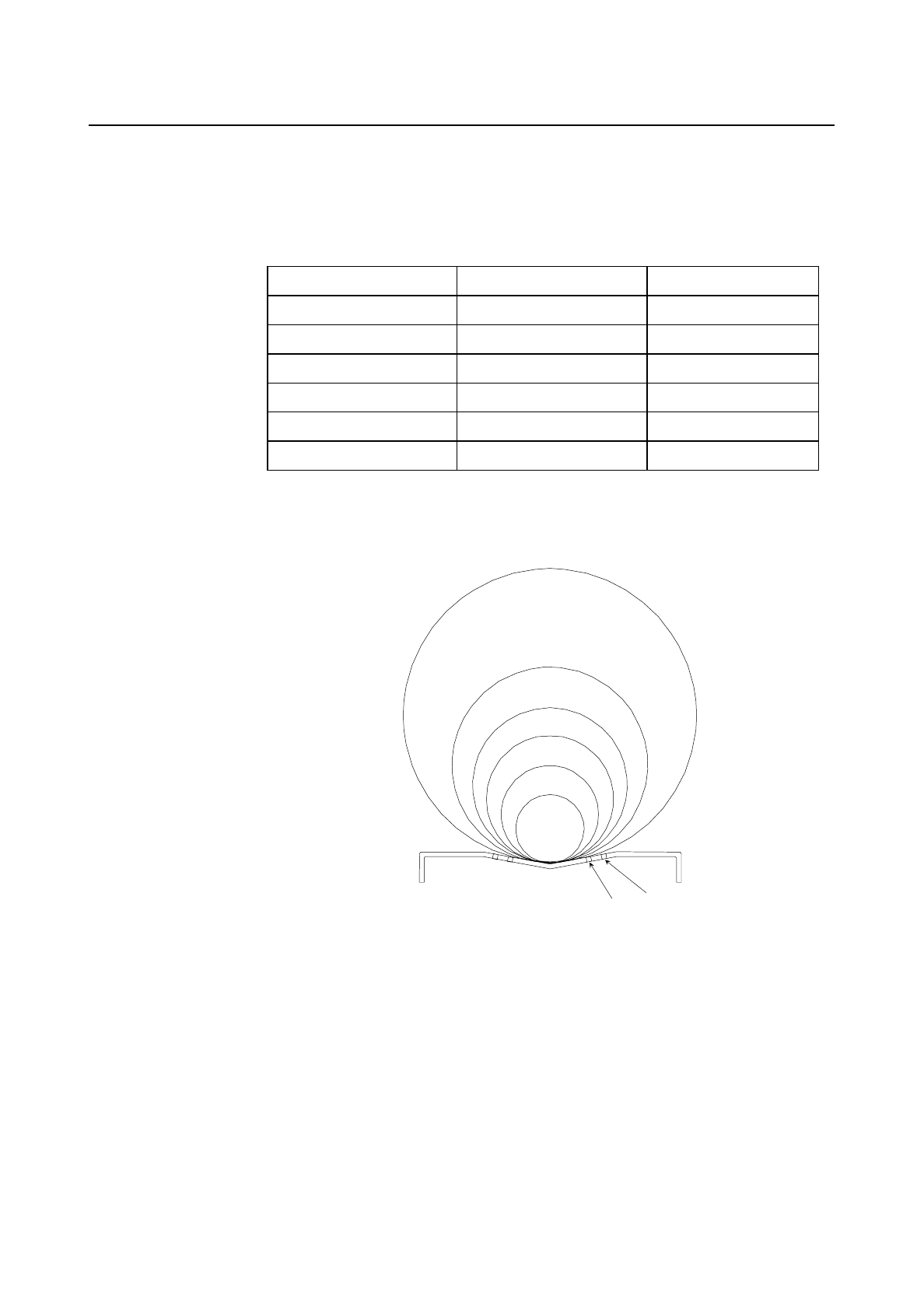
Installation Base Transceiver
IMN:BTSE BS11 Station Equipment
A30808-X3247-B359-2-7631 23
Use the number of tapes (2 or 3) indicated below in relation to the pole diameter.
Use the holes indicated for fastening.
Pole diameter
Tape passage hole
Number of tapes (N)
70 mm
n.1
3
100 mm
n. 1
3
130 mm
n. 2
3
160 mm
n. 2
2
200 mm
n. 2
2
300 mm
n. 2
2
70mm
100mm
130mm
160mm
200mm
300mm
2
1
Proceed in steps as follows (Fig. 2.8.):
- Position bracket (1) on the pole (2). For this purpose:
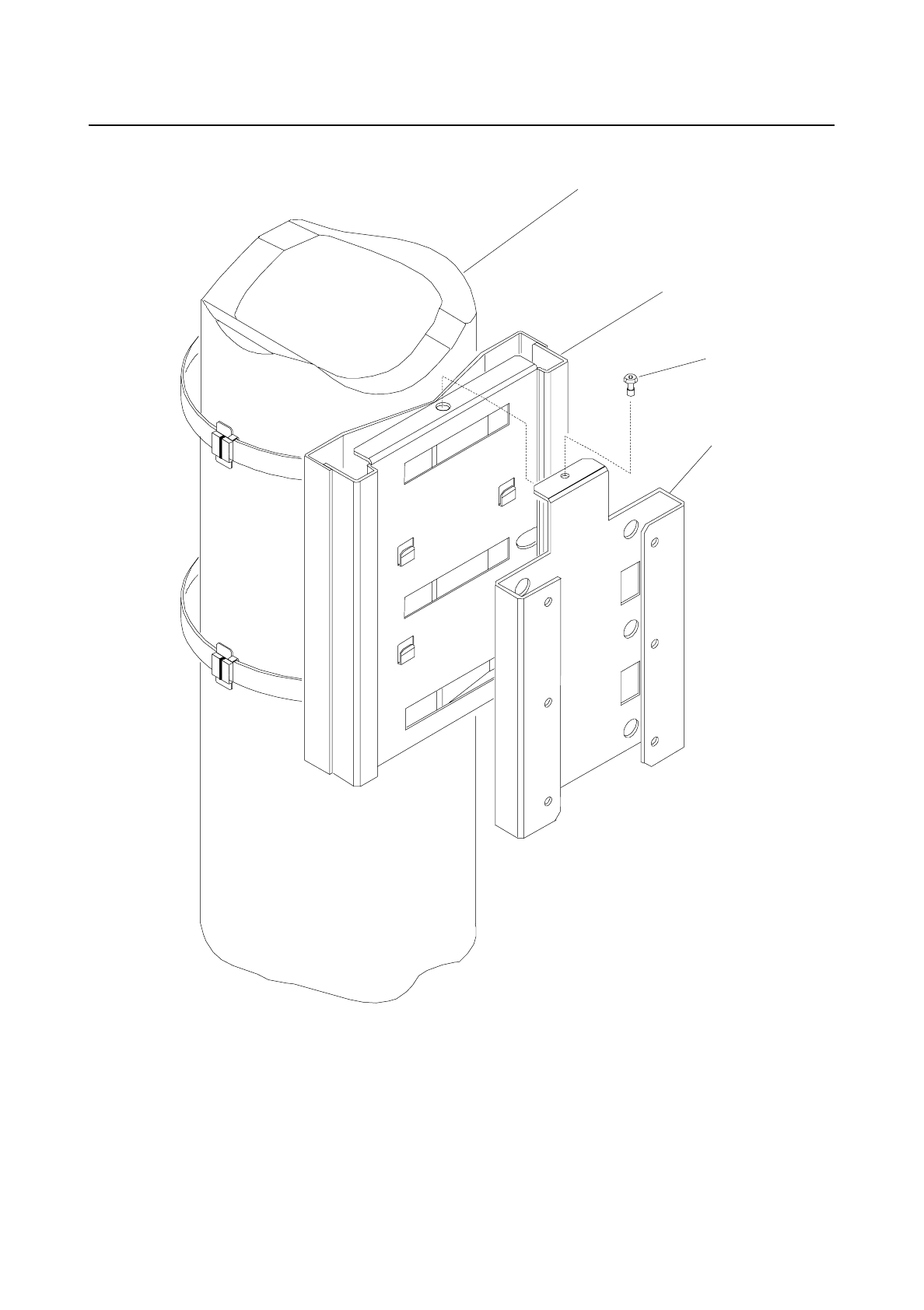
Base Transceiver Installation
Station Equipment IMN:BTSE BS11
24 A30808-X3247-B359-2-7631
2
1
4
3
Fig. 2.8. BTSE: Pole mounting frame without tilting mechanism
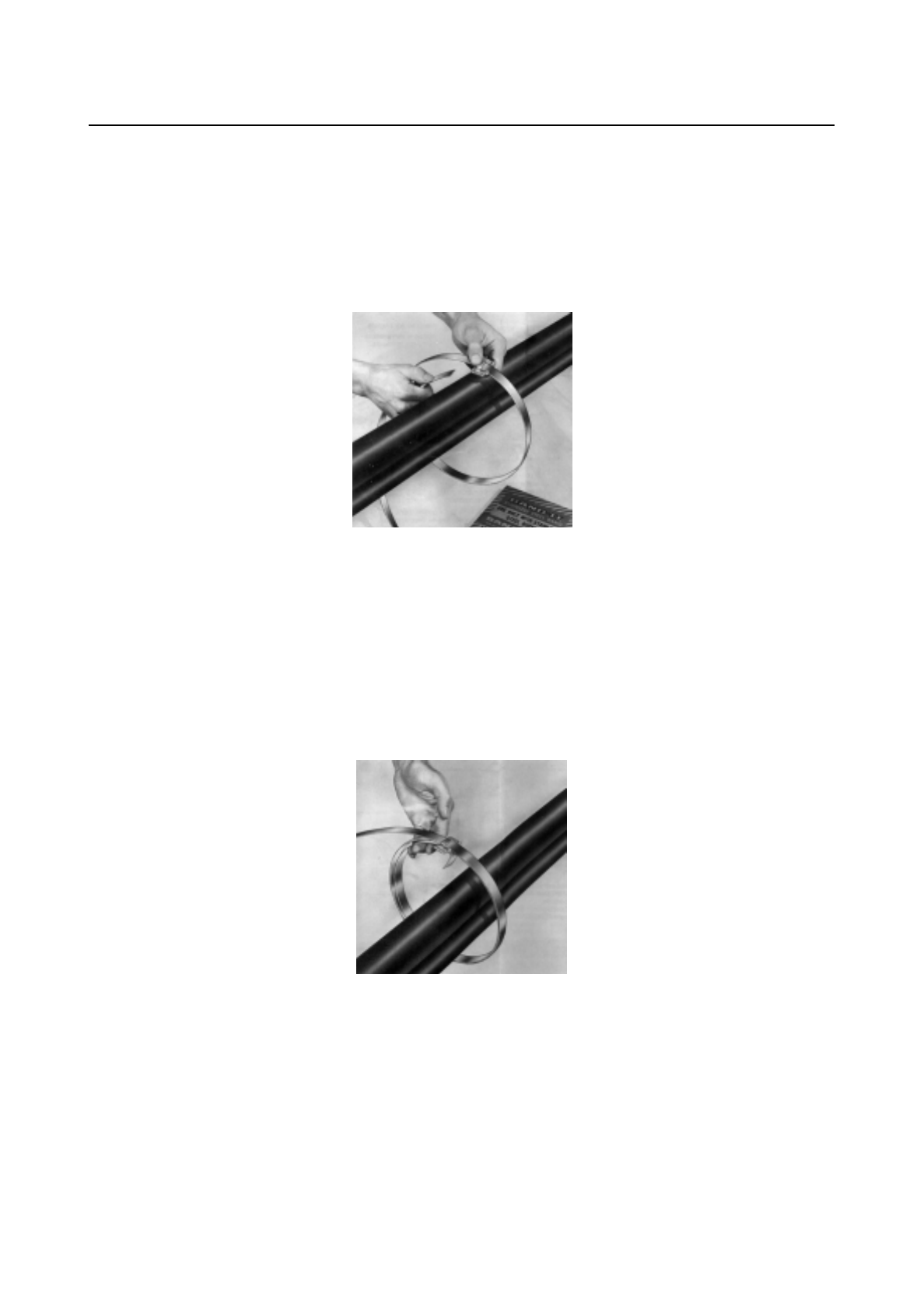
Installation Base Transceiver
IMN:BTSE BS11 Station Equipment
A30808-X3247-B359-2-7631 25
· Band may be used from bulk roll as this completely eliminates waste of
band. Slide buckle on band as shown in Fig. 2.9. bringing end of band
around object to be clamped and again through buckle.
Fig. 2.9. Buckle slided on band
· Continue band around object once more and again through buckle (Fig.
2.10.) Double banding develops a great deal more radial compression
than single banding. Bend end of band under buckle.
Fig. 2.10. Band around pole
· Place band in open slot of tool nose and in slide (Fig. 2.11.). With thumb
on band gripper lever, apply tension by turning handle of tool. After
tension is created, it is no longer necessary to hold band gripper lever as
it locks itself under tension.
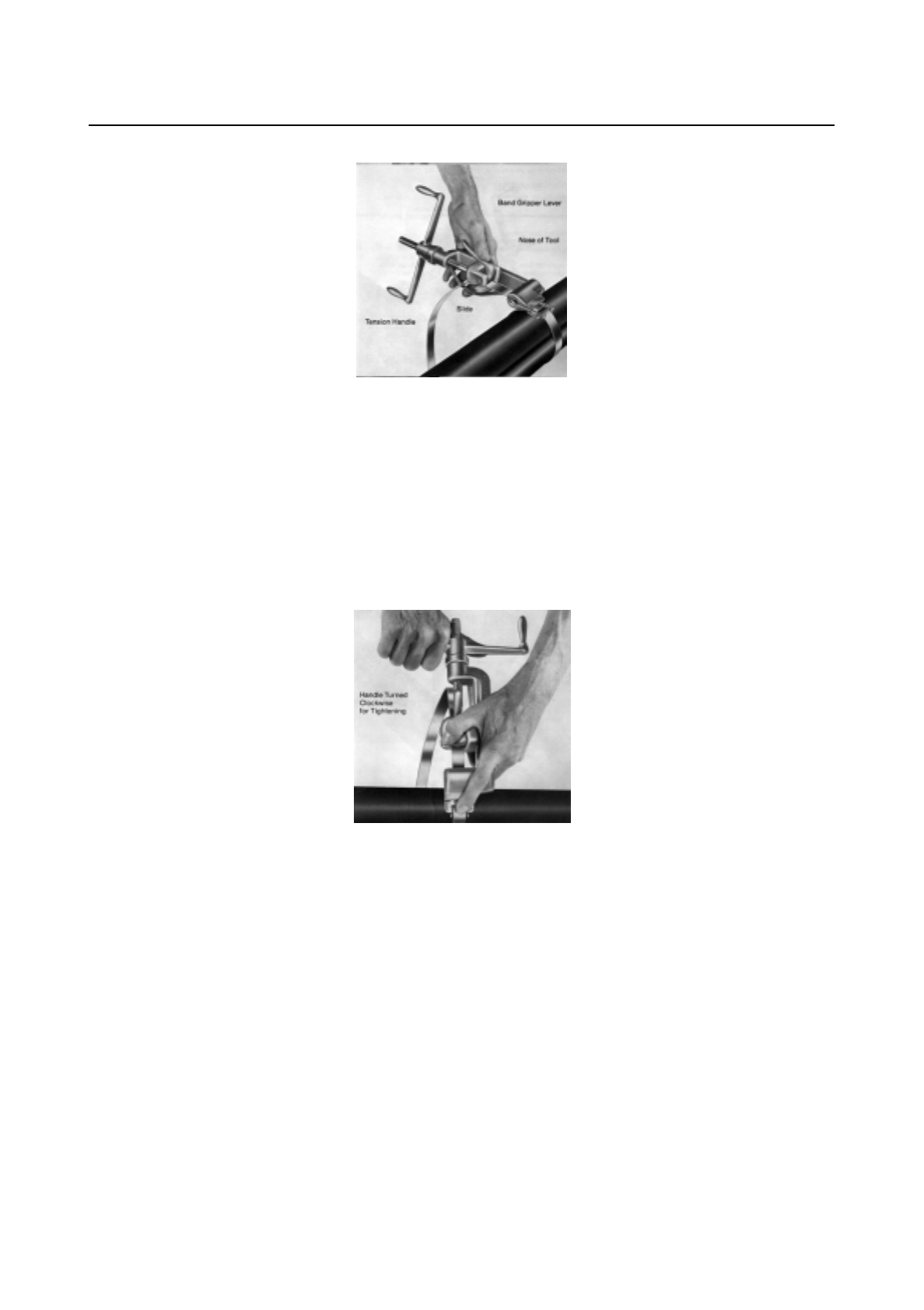
Base Transceiver Installation
Station Equipment IMN:BTSE BS11
26 A30808-X3247-B359-2-7631
Fig. 2.11. Apply tension
· Place finger on Band-It Band at buckle bridge while tensioning with tool
handle, maximum pressure is being exerted bu the Band-It Band around
object being clamped. Stop turning handle (Fig. 2.12.).
Fig. 2.12. Tightening
· Roll tool over buckle, backing off with tension handle throughtout entire
rolling operation (Fig. 2.13.). Failure to back off with tension handle
throughout entire course of roll may result in breaking of band. There is
no loss of tension as band released is used up in the bend.
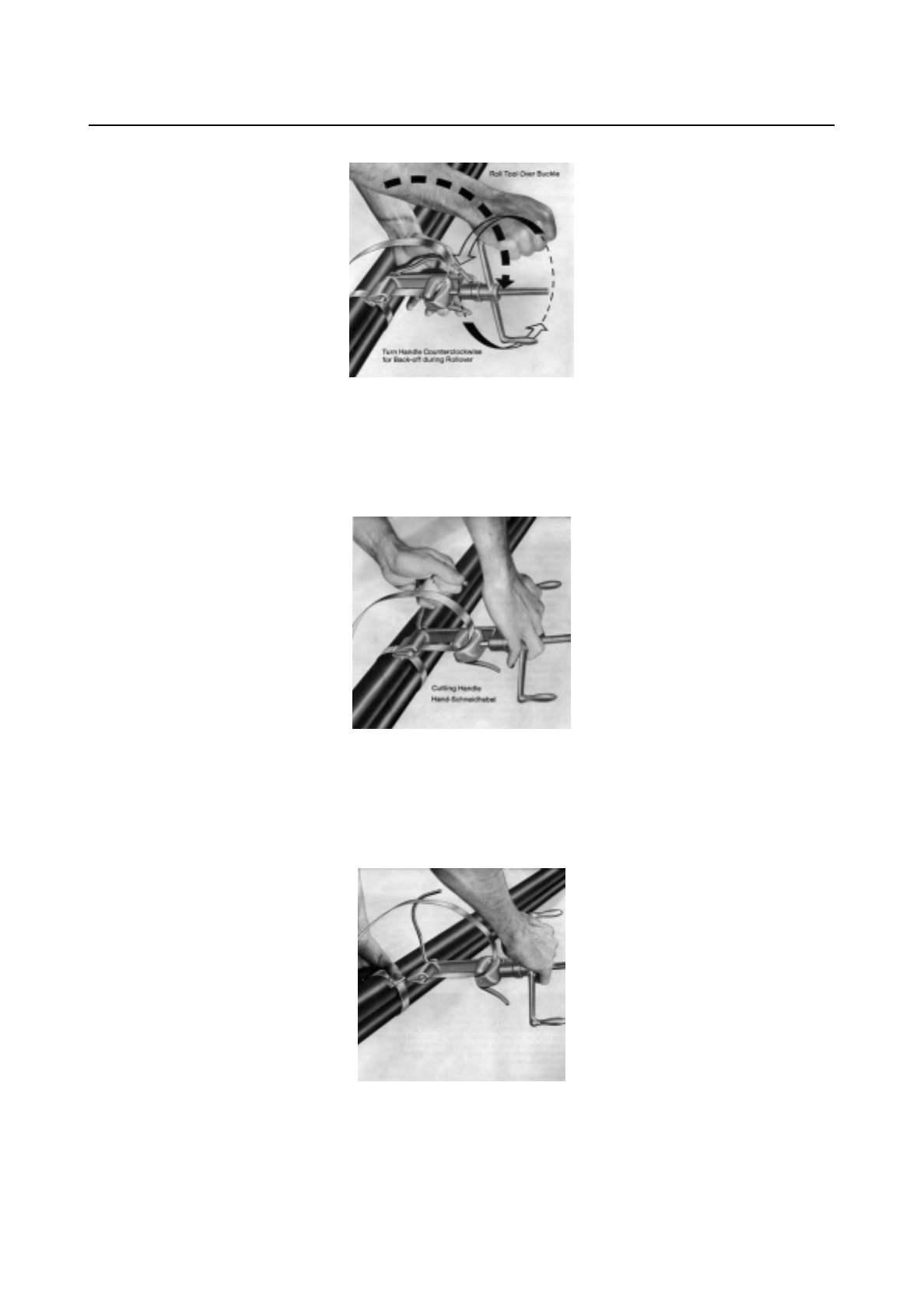
Installation Base Transceiver
IMN:BTSE BS11 Station Equipment
A30808-X3247-B359-2-7631 27
Fig. 2.13. Rolling tool
· Pull cutting handle to cut the band (Fig. 2.14.).
Fig. 2.14. Cutting the band
· Remove tool, holding stub of band down with thumb (Fig. 2.15.).
Fig. 2.15. Removing tool
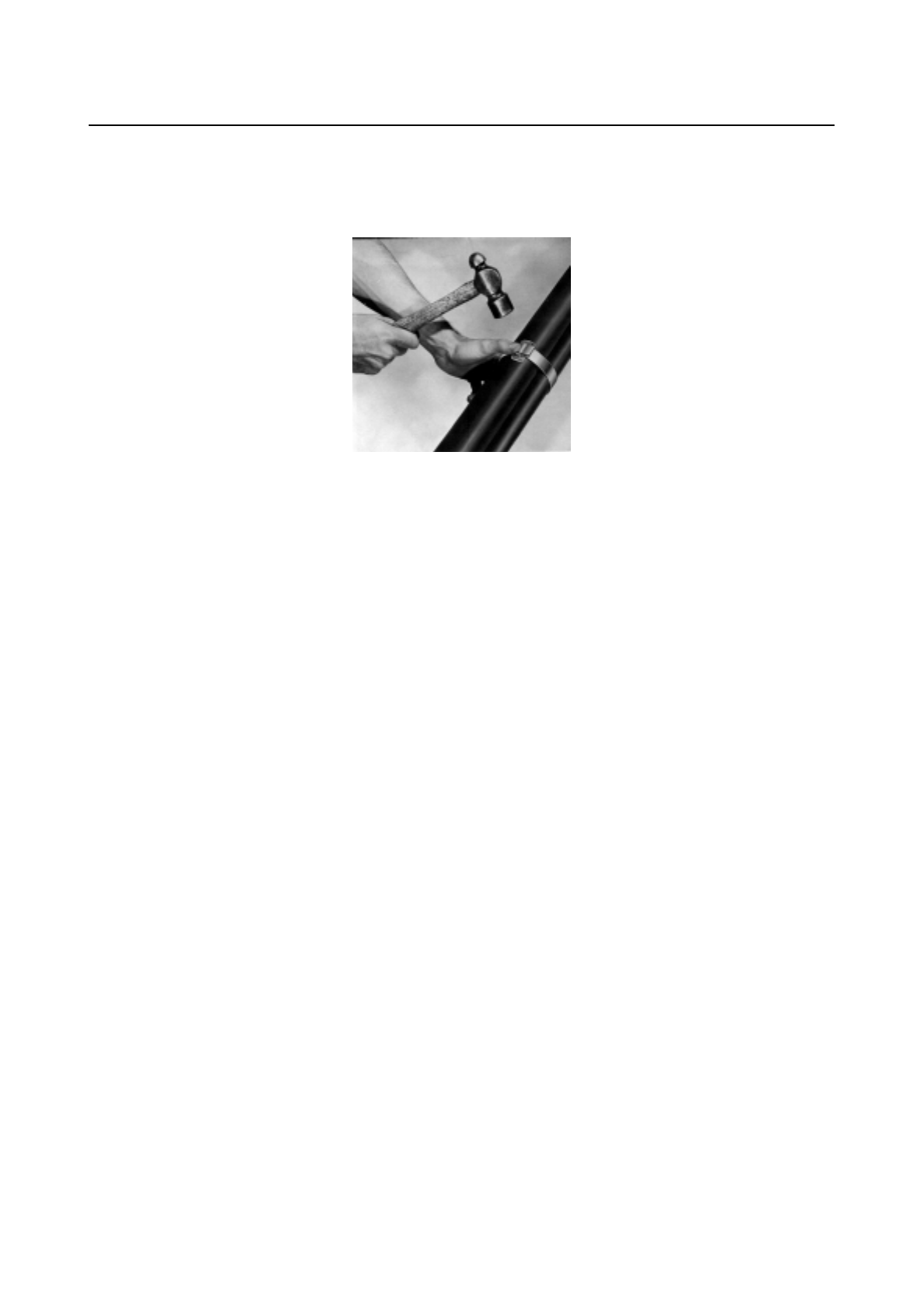
Base Transceiver Installation
Station Equipment IMN:BTSE BS11
28 A30808-X3247-B359-2-7631
· Clink stub by hammering down buckle ears, completing Band-It clamp
(Fig. 2.16.).
Fig. 2.16. Hammering buckle ears
- Connect the BTSE (furnished joined to bracket (3)) to bracket (1).
- Tighten the M5 hexagonal head cap screw (4) using the proper wrench
supplied.
2.6.4. Antenna mounting
Refer to section 2.5.4, where the procedure has already been described.
2.6.5. Solar shield mounting
Refer to section 2.5.5, where the procedure has already been described.
2.7. External Cabling Activities
This chapter gives information required for installing the external cables between
the BTSE and the infrastructure equipment.
The rack cannot function without the following cable connections:
- terminal block: connection point of 230 V AC or 110 V AC
- ground bolt: grounding system
- Abis interface: PCM30 links
- RX/TX antenna connectors: transmit/receive antennas (just connected)
Refer to Fig. 2.17. for the location of the connectors at the connection.

Installation Base Transceiver
IMN:BTSE BS11 Station Equipment
A30808-X3247-B359-2-7631 29
The functions of the commands, indicators, connectors and fuses of the
connection panel are as follows:
Y01: Reception of the first PCM flux from BSC or from preceding BTSE
Y02: Transmission of the first PCM flux to BSC or from preceding BTSE
Y03: Reception of the second PCM flux from BSC or from the
following/preceding BTSE
Y04: Transmission of the second PCM flux to BSC or to the following
BTSE
J01: Test and alarm connector
P1: Power supply connector
F1-F2-F3-F4: 10A delayed fuses (F2-F4 spare in MonoTRX)
SL01: Led with green light (when turned on it signals the presence of the
230 V AC power supply voltage)
ON/OFF: Power supply switch. It is provided with protection against
accidental shutdown.
RX0: First RF reception (diversity)
RX1: Second RF reception (diversity)
TX0: RF transmission TRX0
TX1: RF transmission TRX1
Note that all the cables external to the BTSE (as well as the internal ones) must
be at zero self-extinguishing halogens.
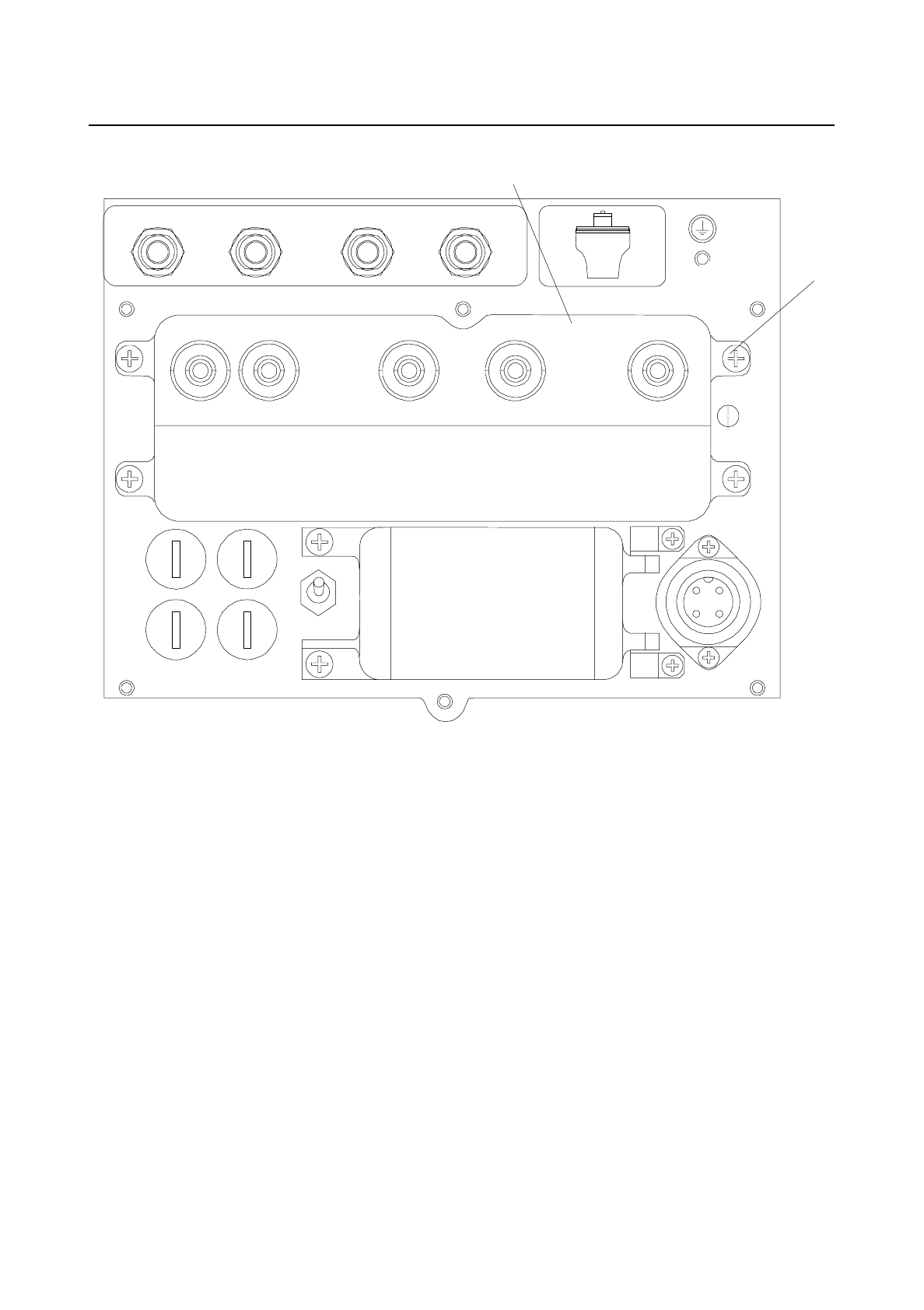
Base Transceiver Installation
Station Equipment IMN:BTSE BS11
30 A30808-X3247-B359-2-7631
RX1 RX0 TX0
JØ1 YØ1 YØ2 YØ3 YØ4
SLØ1
P1
F4 F3
F2 F1
ON/OFF
2
1
TX1*
*only in BiTRX
Fig. 2.17. Connection panel
2.7.1. Ground and Power Supply Connections
The grounding and power supply connections must conform to the standards in
force in the Country where the installation takes place.
A main cable in flexible raceway-plug is required for connecting the BTSE to the
connection point of the 230 V AC power supply.
The terminal block for the 230V AC mains input is located below the BTSE (Fig.
2.18.).
The BTSE accepts either of the following nominal operating voltages indifferently:
- 110 V +15% -25% - 50 Hz ±10% - 60 Hz ±10% 220 W Max MonoTRX
- 230 V +15% -25% - 50 Hz ±10% - 60 Hz ±10%
320 W Max BiTRX

Installation Base Transceiver
IMN:BTSE BS11 Station Equipment
A30808-X3247-B359-2-7631 31
To connect the BTSE with the AC mains connection point proceed with the
following steps:
- Using the appropriate wrench, remove the box covering the connectors,
located on the lower side of the BTSE. The connector cover has already been
opened to carry out the antenna installation (section 2.5.4).
- Refer to the site documentation for the required information about type and
location of the 230 V AC connection point.
- The dimensioning of the power supply cable, of the grounding cable and of
the magneto-thermal switch must be carried out according to the
configuration of the BTSE installation site and with respect for the standards
in force in the Country in which the installation takes place.
- Check the actual distance between the shelter and the connection point.
- Cut the cable for the required length.
- Fix wire end sleeves at the end that is to be connected to the connector.
- Lead the prepared cable through the cable access at the bottom of the
shelter.
- Insert the prepared ends into the connector. With regard to the connector
wiring, consult the instructions contained in the appendix.
- Fix the cable at the cable access by cable strap.
- Lead the main cable to the connection point for 230 V AC.
Note that the type and location of the mains connection point are subject to
modification. They are dependent on site and customer requirements. A
description of the connecting procedure does not form part of this manual. For
further information refer to the site documentation and use the corresponding
manufacturer documents.
The BTSE must be connected to the ground system.
For this purpose, there is a 6 mm diameter threaded hole underneath the BTSE.
Connect the BTSE and ground system as follows:
- Use the nearest connection point of the ground system.
- Ascertain the distances between the connection points of the ground system
and the ground bolts of the shelter.
- Cut the cable (insulated, 6 mm²) to the required length.
- Remove the cable covering at the end to connect to the ground hole (length
approx. 7 mm).
- Fasten a cable terminal to the ground cable and fasten it to the ground hole
with a hexagonal head cap screw and 2 washers.
- Connect the prepared cable end to the ground bolt.
- Tighten the nut firmly.
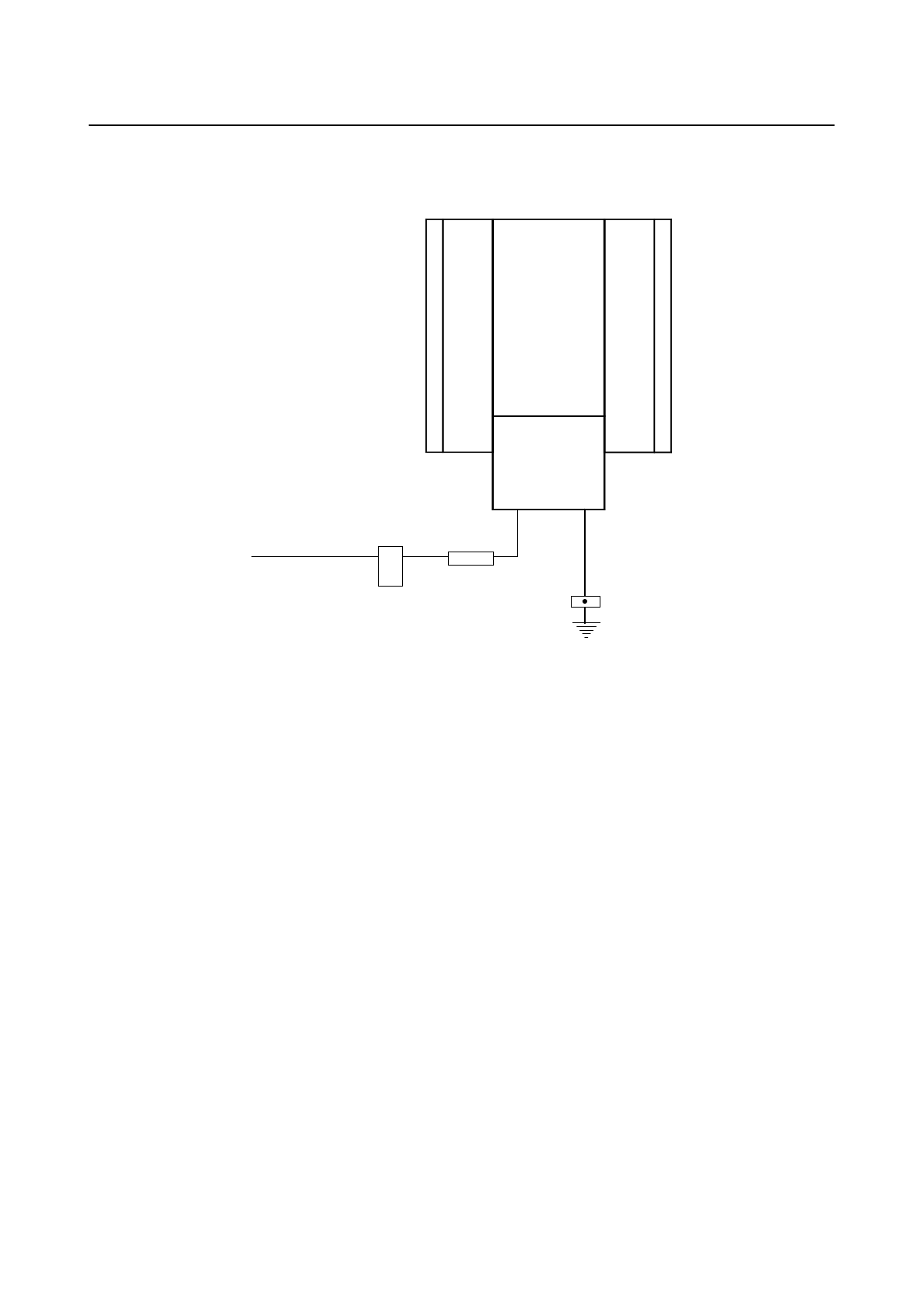
Base Transceiver Installation
Station Equipment IMN:BTSE BS11
32 A30808-X3247-B359-2-7631
Ma
g
neto termal
differential
BTSE
Mains
(
230 Vac/50 Hz
)
Junction box with screw
terminals
(
o
p
tionals
)
1. AC Main
connector
Hirshman CA3LD
P/N 2450000330
2. AC Main Cable
2x1,5 mm antifire
P/N 2268124229
Fig. 2.18. Ground and power supply connections (example)
2.7.2. Abis Interface - PCM 30 Link Equipment
The PCM30 links access the BTSE via the Abis-interface, located at the
connection panel (see Fig. 2.17.).
Fig. 2.19. shows two possible Abis configurations to connect the BTSE to the
BSC. These configurations are called Star (single) and Multidrop (several).
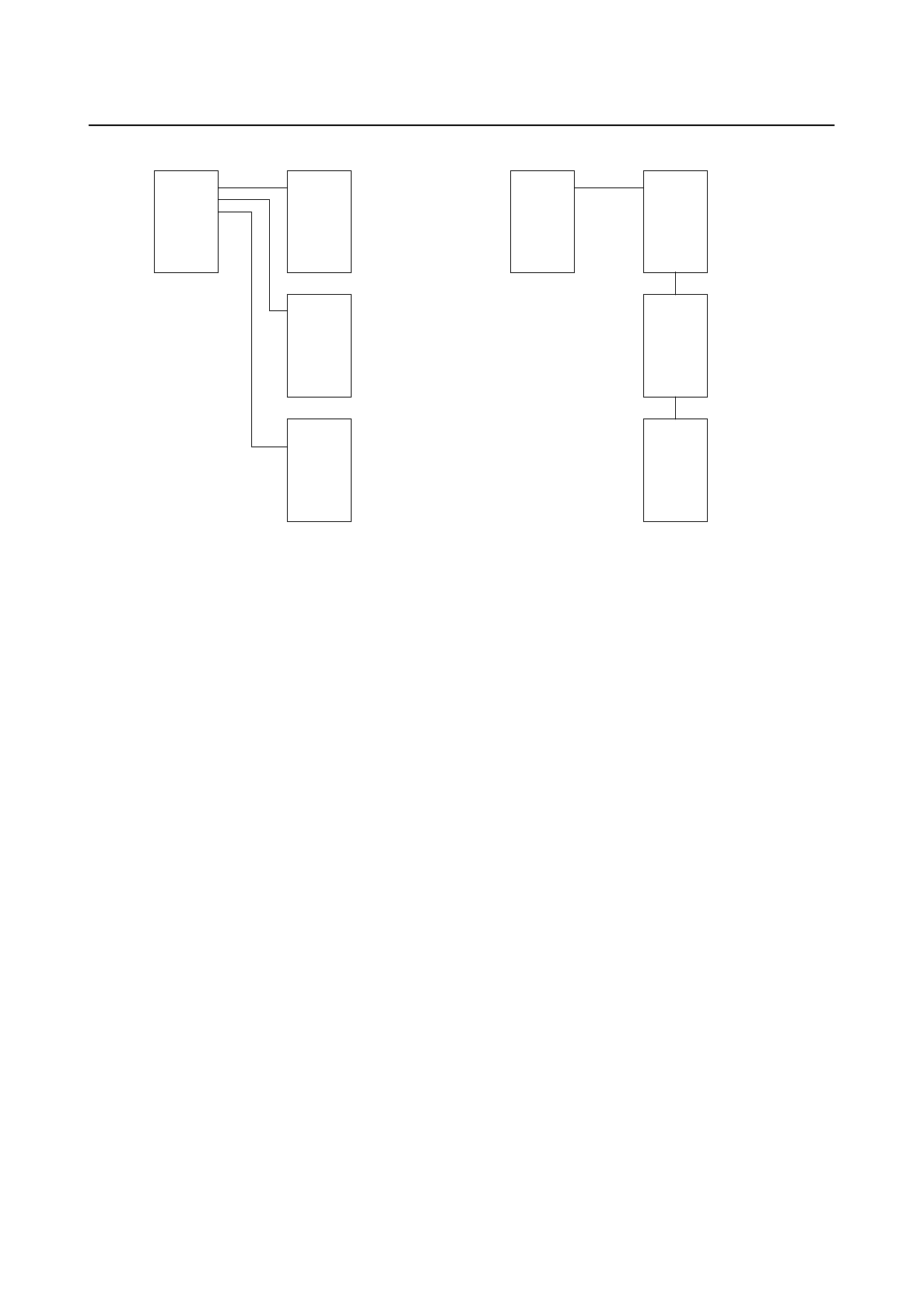
Installation Base Transceiver
IMN:BTSE BS11 Station Equipment
A30808-X3247-B359-2-7631 33
BTSE1
BTSE2
BTSE3
BSC BSC
STAR MULTIDROP
BTSE1
BTSE2
BTSE3
Fig. 2.19. STAR/MULTIDROP Configuration
The functions of the Y01 ÷ Y04 connectors (reception and transmission of the
PCM fluxes) are illustrated in Fig. 2.20. ÷ Fig. 2.22.
Connection of the Abis-interface to the PCM 30 link terminal on site is as follows:
- Refer to the site documentation for the required information about the location
of the PCM 30 link terminal, the type of shielded cable and of connector,
which have to be used.
- Determine the real distance between rack and link terminal.
- Cut the PCM cables to the required length.
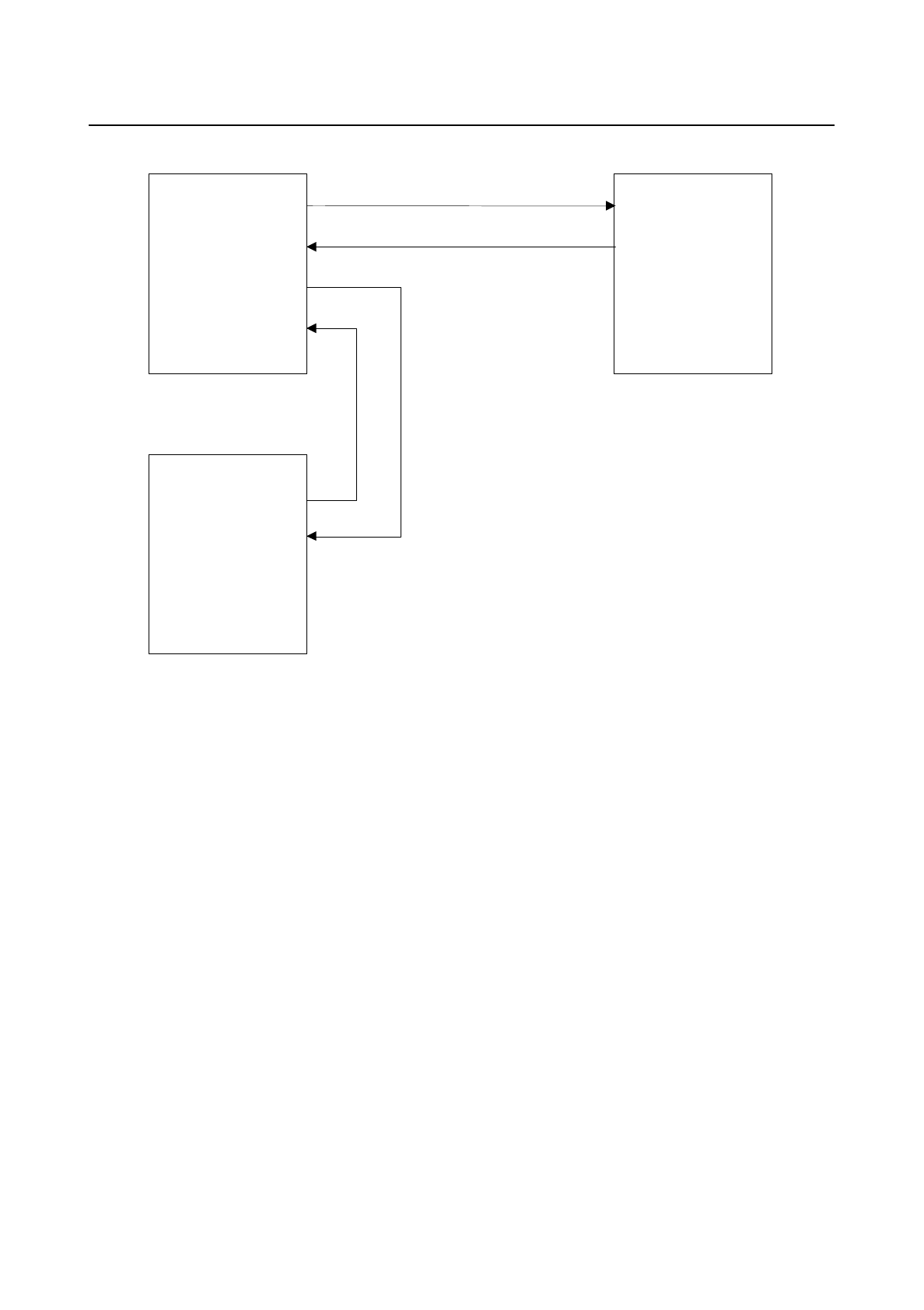
Base Transceiver Installation
Station Equipment IMN:BTSE BS11
34 A30808-X3247-B359-2-7631
YØ2
BSC
YØ4
YØ3
Tx
Rx
Tx
Rx
BTSE
BTSE
YØ1
YØ2
YØ1
Fig. 2.20. Multidrop configuration Functions of Y01 ÷ Y04 connectors
- With reference to Fig. 2.23., remove the four screws (1) and remove the
cover (2) to gain access to the Y01 ÷ Y04 connectors (Fig. 2.24.).
- Insert the four PCM cables in the four holes of the cover removed earlier.
- Abut the PCM cables to the relative connectors (the procedure is shown in
the appendix).
- Remove the central plug of each core hitch.
- Pass each cable in the respective core hitch.
- Abut the movable connector to the cable.
- Insert the movable connectors in the respective fixed connectors.
- The BTSE is supplied with the output impedance preset to 75 Ω and with the
PCM cable shield grounded. Whenever it is necessary to use the output
impedance at 120 Ω or to disconnect the ground shield, consult the
ITMN:BTSE BS11 manual.
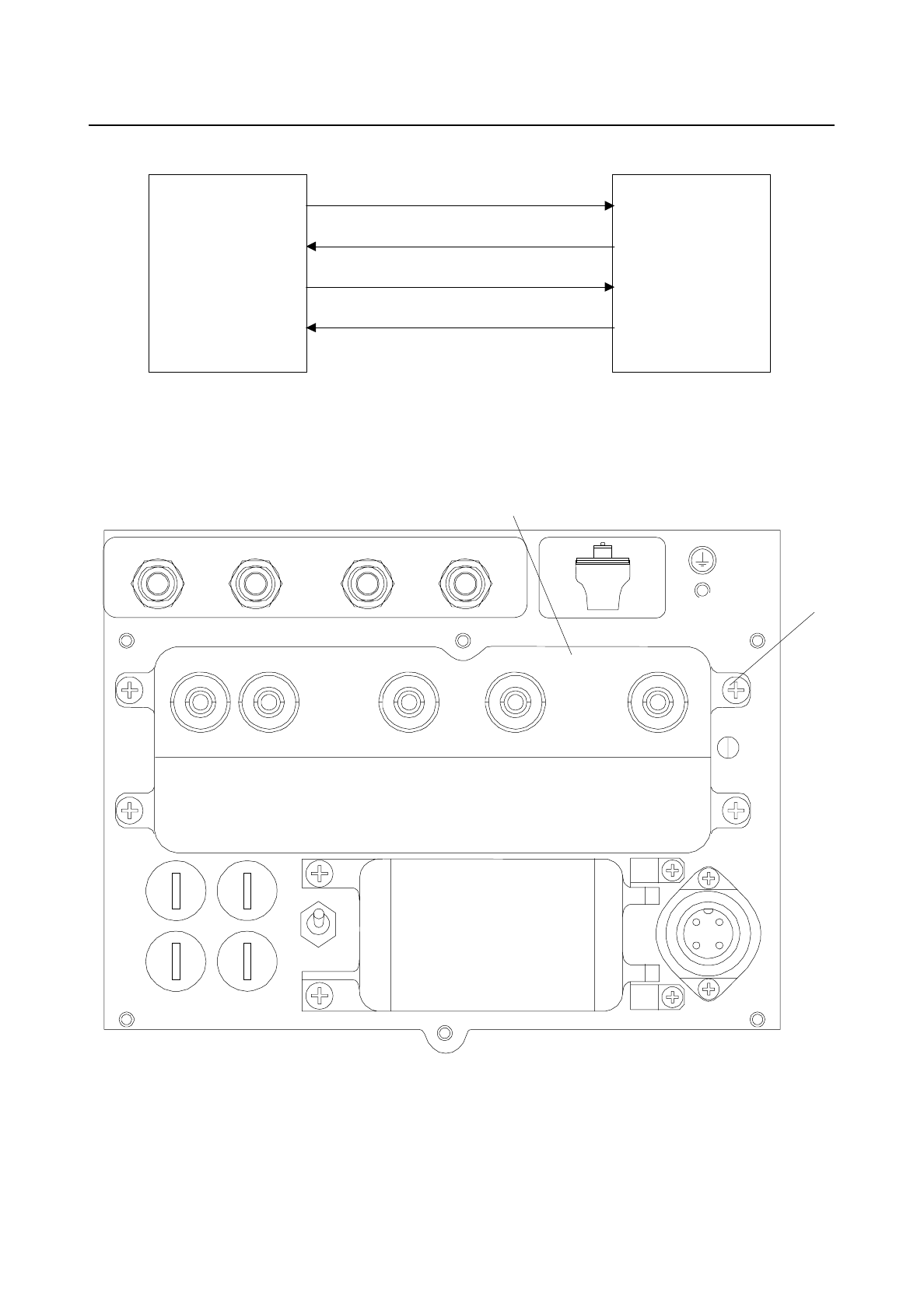
Installation Base Transceiver
IMN:BTSE BS11 Station Equipment
A30808-X3247-B359-2-7631 35
YØ2
BSC
YØ4
YØ3
Tx
Rx
BTSE
YØ1
Tx
Rx
Fig. 2.21. Star configuration Functions of Y01 ÷ Y04 connectors
RX1 RX0 TX0
JØ1 YØ1 YØ2 YØ3 YØ4
SLØ1
P1
F4 F3
F2 F1
ON/OFF
2
1
TX1*
*only in BiTRX
Fig. 2.22. Connection Panel
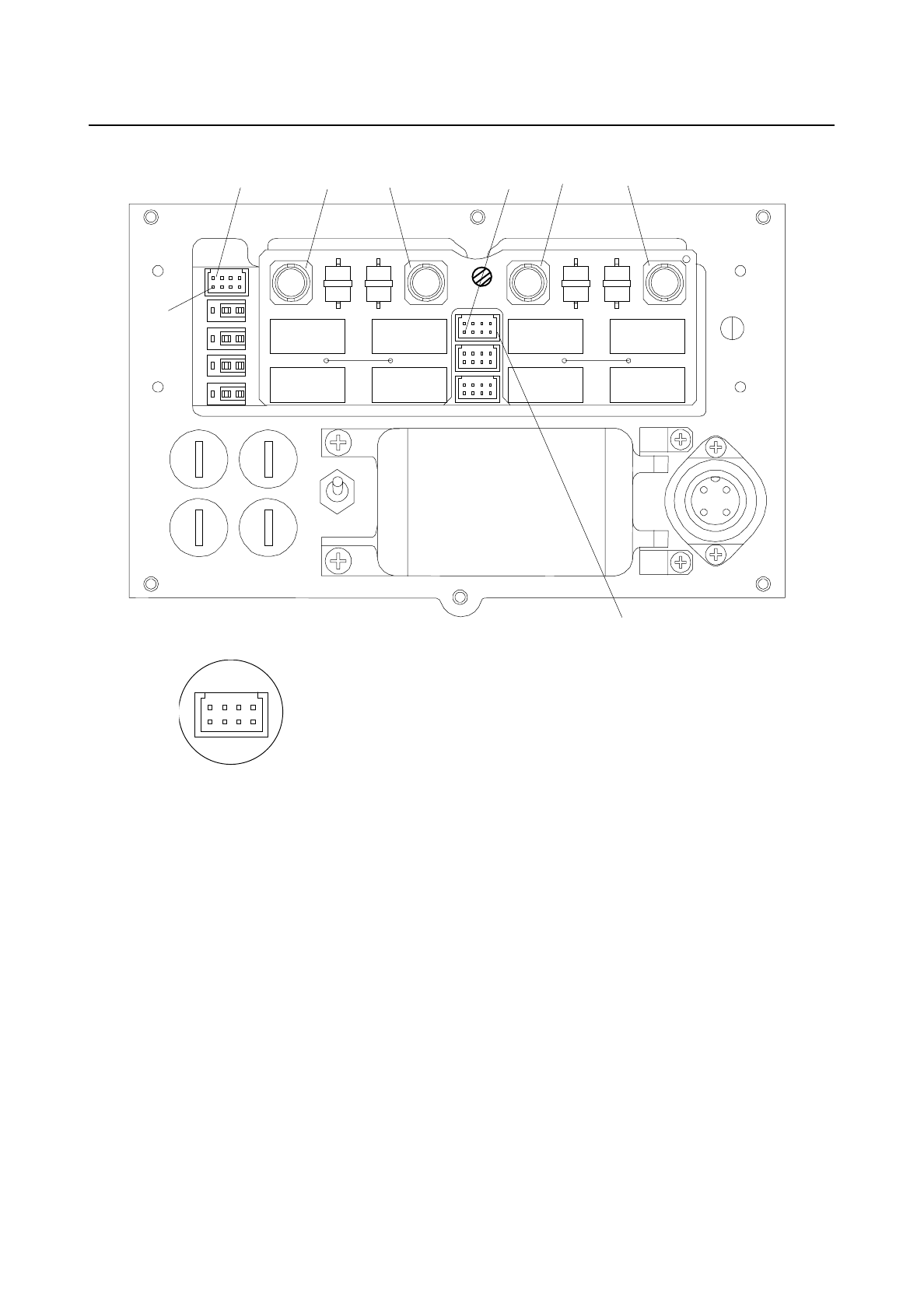
Base Transceiver Installation
Station Equipment IMN:BTSE BS11
36 A30808-X3247-B359-2-7631
JØ2
JØ1 YØ1 YØ2 YØ3 YØ4
pin1
pin1
2
1
4
3
6
5
8
7
2
1
4
3
6
5
8
7
Fig. 2.23. Y01 ÷ Y04, J01 and J02 connectors
2.7.3. Connection to the J01 connector
After having connected the PCM30 cables, before closing the connector panel,
connect the cable to the flying connector which will then be connected to J01.
The operations are described in the appendix.
NOTE:
The J02 connector serves for the connection with LMT.
2.8. Post Installation Notes
After all installation works are finished and all cables clamped at the cable
access, close the cable entry box (2, Fig. 2.23.).
Close the cover of the connector panel using the proper wrench.

Installation Base Transceiver
IMN:BTSE BS11 Station Equipment
A30808-X3247-B359-2-7631 37
Remove all packing material from site.
Call the commissioning staff for switch on, testing and network integration of the
Base Station.

Base Transceiver Installation
Station Equipment IMN:BTSE BS11
38 A30808-X3247-B359-2-7631

Installation Base Transceiver
IMN:BTSE BS11 Station Equipment
A30808-X3247-B359-2-7631 39
3. BS-11e Installation (External antenna)
3.1. Site Requirements
The BS-11e (e is intended for external), called BTSE, is suitable for indoor- and
outdoor operation.
The BTSE is protected from dust, rain and other external factors. The protection
facilities are the following:
- IP 54.
- Burglar proof cabinet.
- Lightning arrestors on power supply and PCM 30 input.
- Connector protection cover supplied with wrenches and anti-intrusion
microswitch.
Prior to the commencement of the installation, the site must have been prepared
as follows:
- The site specific-base construction must have been mounted.
- A wall of min. 1,50 kN/m² load-carrying capacity is required for wall mounting
or, for pole mounting, the pole dimensions must be sufficient to support the
weight of the BTSE. For a maximum wind speed of 160 km/h, the BTSE
produces a 400 kg load.
- The installation area should be clear of standing water, fallen leaves, mud
and building debris.
- Necessary precautions should be taken against unauthorized access during
the installation works.
- The lightning and grounding systems must be completed and tested.
- The antenna lead-in must have been carried out and the antenna must have
been protected from lightening.
- All installation works of 230 V AC or 110 V AC power supply must be
finished.
- The PCM30 cables must have been installed.
- The cables of the alarm signals must have been preset to be – if necessary –
connected to the BTSE later on.
- If the BTSE is pole mounted, install a switching box to the base of the pole
and abut only the cable that goes to the J02 connector of the BTSE
(connector for LMT) to the switching box.
As detailed in para. 3.7.1., the BTSE can accept power supply voltage from 83 V
AC to 265 V AC with frequency from 45 Hz to 65 Hz.
Power consuption:
Mono TRX = 100 W + 120 W with heather sistem inserted from –45 to –
20 degrees external temperature.

Base Transceiver Installation
Station Equipment IMN:BTSE BS11
40 A30808-X3247-B359-2-7631
Bi TRX = 200 W + 120 W with heater system inserted from –45 to –
20 degrees external temperature.
- All the cables must be brought into the immediate vicinity of the BTSE, leaving
30 cm for the following operation of abutment of the cables to the BTSE
connectors.
Whenever the Client considers it necessary, for the purpose of protecting the
cables from attacks of vandalism, it is advisable to pass the cables through steel
or galvanized iron tubes raceways.
It is advisable to make the 220 Vac power supply cables pass through a tube or
raceway different from those used for the signal cables. Alternatively, it is
possible to make all the cables pass through the same raceway, separating,
however, the signal cables from the power supply cables by means of an
insulating partition placed inside the raceway.
3.2. Site Configuration
The installation site configuration is shown in Fig. 3.1. With regard to the alarm
signal cables laid inside the buildings, it is necessary to insert some optoinsulator
devices on their line.
It is necessary to insert overvoltage protections on the alarm signal cables line
laid outside buildings. With regard to the PCM30 cables, if considered necessary,
a sectioning block can be inserted with the terminations.
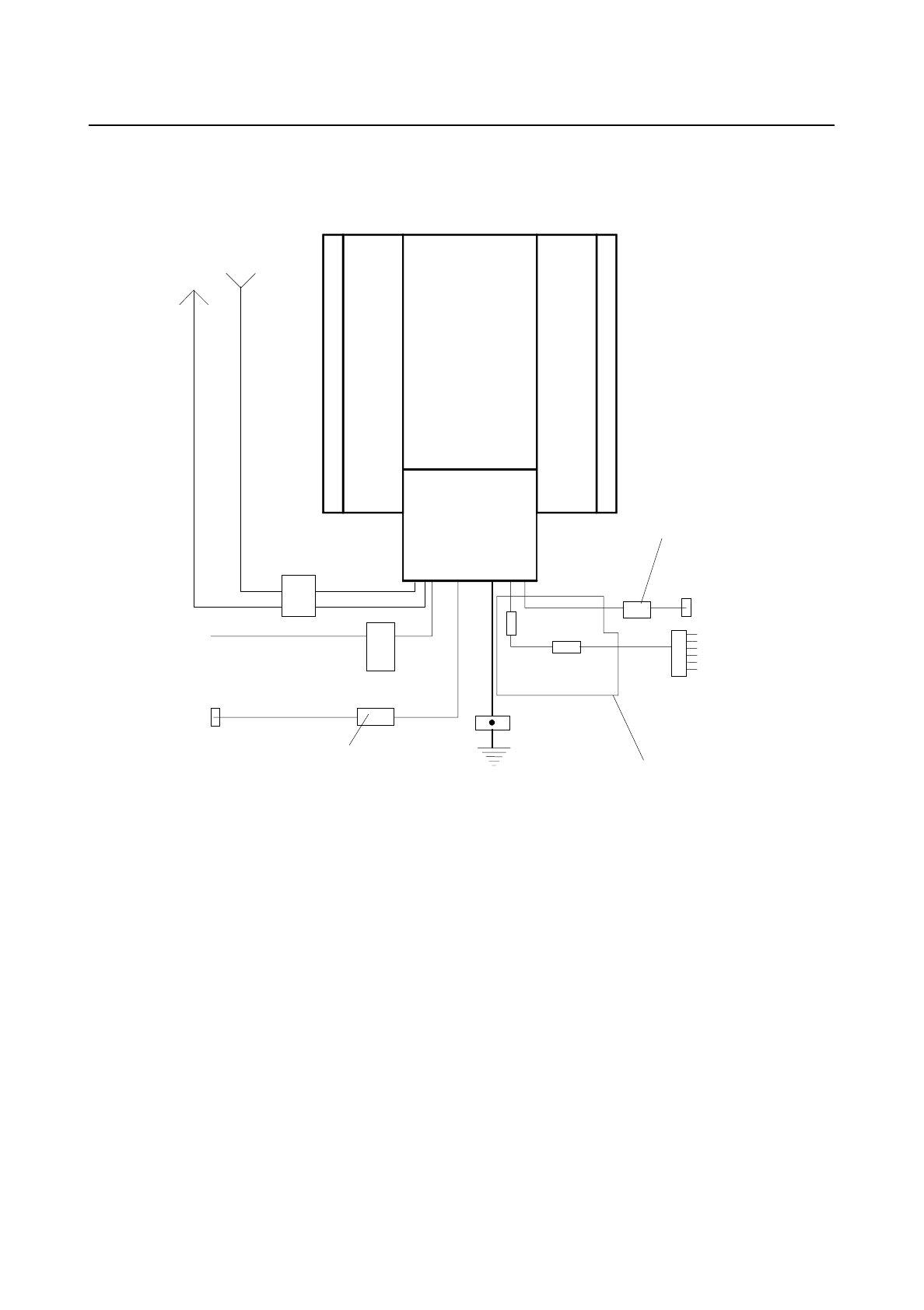
Installation Base Transceiver
IMN:BTSE BS11 Station Equipment
A30808-X3247-B359-2-7631 41
BTSE
lightning
protection
Rx antenna
Tx/Rx antenna
Main breaker
PCM 30 link
Mains (230 Vac/50 Hz)
on next
BTSE ground tag
lightning
protection signalling
link terminal
to the next
BTSE
external
alarms
PCM 30 link
optoisolator
optional
Permutator with line
terminators and
disconnecting switches
(optional)
Permutator with line
terminators and
disconnecting switches
Fig. 3.1. Site Configuration
3.3. Construction View of the BTSE
The BTS equipment is housed in the shelter with dimensions 541 mm x 460 mm
x 163 mm (HxWxD).
The integrated climate control system guarantees proper outdoor operation
(temp. range: -45° C ÷ +45° C).
The plug-in unit ACMDC (AC multiple DC converter) converts the primary input
voltage into all needed DC voltages.
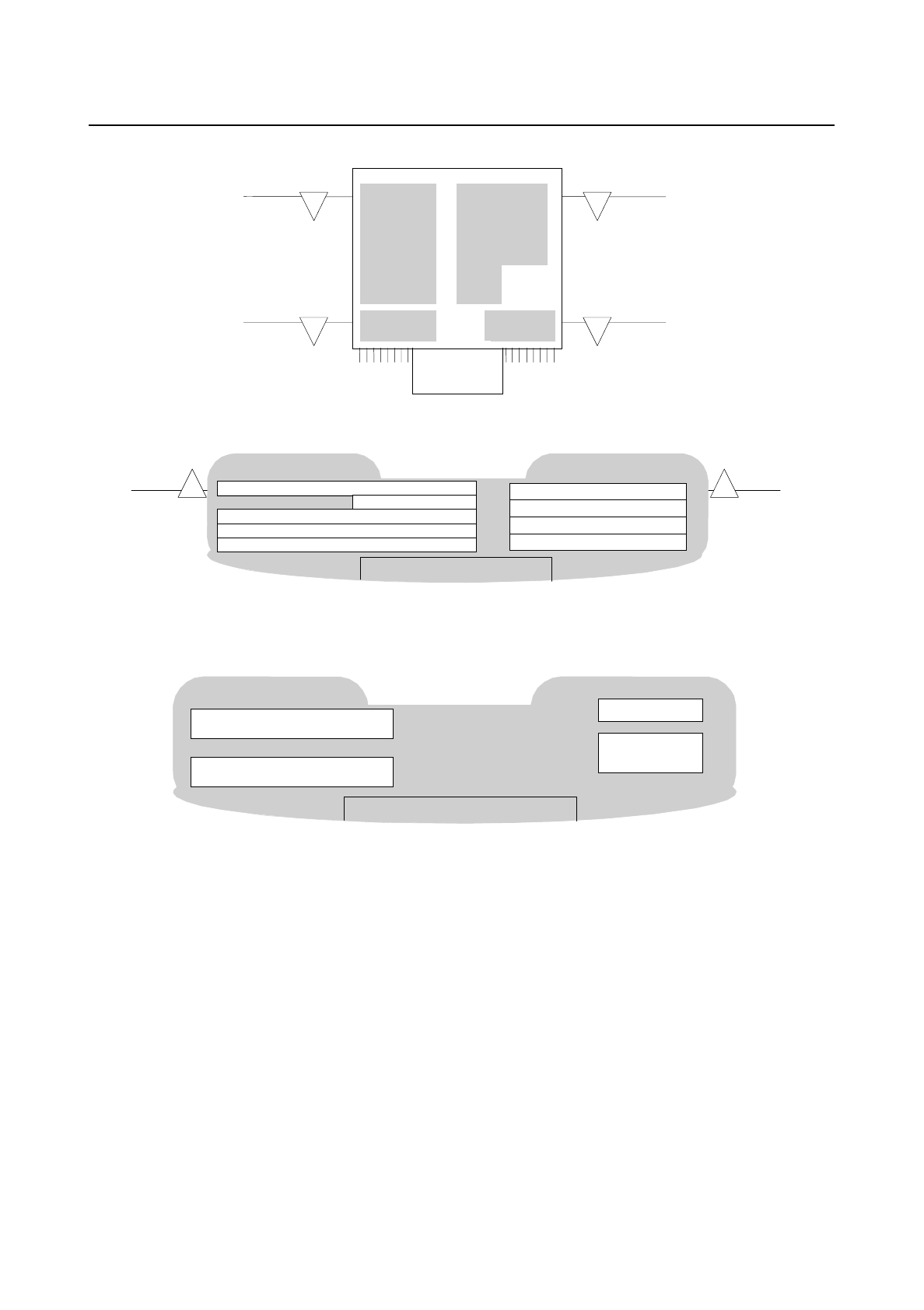
Base Transceiver Installation
Station Equipment IMN:BTSE BS11
42 A30808-X3247-B359-2-7631
A
B
A
B
PSU
PA DUPLEXER
SECTION C-C
SECTION A-A
SECTION B-B
(PA)1
PA0
DUPLEXER
LNA
TX
CC
RF-TX0
RF-RX0
SMU
MBBCU0
DUMMY PANEL
PSU
DUMMY PANEL
MBBCU1
RF-TX1
RF-RX1
Fig. 3.2. BTSE: Location of boards and modules (BiTRX)
3.4. Equipment Delivery
The rack is shipped in a carton with the dimensions 60 x 50 x 20 cm (HxWxD).
The crate can weight up to approx. 27 kg.
The packing consists of two cartons having identical dimensions (600x750x350
m) containing, respectively:
- BTSE with support for fastening and antenna (weight 35 kg BiTRX; 31 Kg.
MonoTRX);
- Movable parts for fastening to pole/wall and solar shield (weight 12 kg).

Installation Base Transceiver
IMN:BTSE BS11 Station Equipment
A30808-X3247-B359-2-7631 43
Handle each carton containing installation material with extreme caution to avoid
tipping.
The crate has the following information printed on them for identification of
delivery:
- Trade mark.
- Customer order number.
- Serial number of rack or other supplied equipment.
- Destination.
- Gross and net weight.
- Overall dimensions (cm).
- Symbol or imprint to identify the “Top” and the “Bottom”.
3.4.1. Preliminary Checks
Check that the cartons are not damaged. In case of evident damage due to
transport, unpack the equipment in presence of an insurance company
representative and promptly claim any damage and inform the shipper for
specifying the damage.
Check whether the package is actually addressed to the site and complete.
Open it and take the contents out carefully.
After having removed all contents from the packing material, check for
deformation to the devices, of torn or unwelded wiring, of oxidized connectors, as
well as deformed front sides of the units, loose screws, damage to paint work etc.
3.4.2. BTSE Unpacking
During the unpacking steps great care must be taken to ensure that the BTSE is
not scratched or damaged in any way. Proceed as follows:
- Cut the straps and remove the container cover.
- Take out the BTSE from the cardboard box.
- Open the tubular PE shrink-wrap protecting the BTSE and take it out.
- Remove the dehydrating material bags fixed with the adhesive tape.
- Remove the protection to the head and to the base of the BTSE.
- Lift the BTSE in vertical position.
- Remove the profiles protecting the BTSE edges.
3.4.3. Installation Kit Unpacking
Proceed as follows:
- Open the PVC wrap protecting the carton and withdraw it.
- Remove the dehydrating material bag from the box.
- Cut with a suitable knife the adhesive tape sealing the box.

Base Transceiver Installation
Station Equipment IMN:BTSE BS11
44 A30808-X3247-B359-2-7631
- Take the installation kit out.
- Open the PVC wrap protecting the device/board and withdraw it.
The packing material should be preserved for possible future re-packing. For this
purpose, reverse the procedure described above, taking into account the
warnings specified for the packing.
Installation is facilitated by the use of the handle with which the BTSE is
equipped.
3.4.4. Spare parts for field maintenance
Suggested spare parts for field maintenance are:
Description Part Number
Sun Shield Reddish color 332-0443/02
Green solar shields 332-0443/03
Beige solar shields 332-0443/04
Neutral solar shields 332-0443/01
Dummy antenna 332-0450/01
Wall/Pole mechanical fitting 131-9221/01
Line protection module 130-3679/01
Power supply protection module 130-3680/01
Bottom covers for connectors 350-1339/01
Fuses 2622210252
Socket head Screw 15059000039
Look Key 10350000063
As facilities for field maintenance can be used
BS 11 local maintenance terminal interface kit 131-9441/01
3.5. Wall Mounting of the BTSE
3.5.1. Installation Tools
The correct rack installation is carried out with the aid of the following tools:
- Standard toolkit for BTSE installation.
- Spirit level.
- Plumb bob.
- Saw with shavings exhausted filter (for elevated floor only).
- Hammer drill.

Installation Base Transceiver
IMN:BTSE BS11 Station Equipment
A30808-X3247-B359-2-7631 45
- Drill widia
- Hammer.
- Screw driver for cross-slotted screw.
For installation of power distribution panels, cable ducts, antenna, cableways and
other infrastructure equipment, additional tools could be necessary.
3.5.2. Ancillary Material
The following ancillary materials are needed:
- Plumb line.
- Colophony.
- Adhesive tape (yellow/green) for labelling.
- Cable fasteners.
3.5.3. BTSE Installation Procedure
Prior to the commencement of BTSE installation, consult the site documentation
to locate the installation point of the BTSE, the PCM 30 network termination, the
connection point for AC mains and the nearest ground tag.
Necessary installation material (for fixing the wall mounting frame to the wall and
for fixing the base plate to the wall) come with the delivery.
Proceed in steps as follows:
- Make six holes in the wall corresponding to the holes located on bracket (Fig.
3.3.).
- Insert in the wall six wallplugs (The wallplugs are not included in the
installation kit because these wallplugs must be chosen in relation to the wall.
The wallplug must receive at least a diameter 8 mm screw.
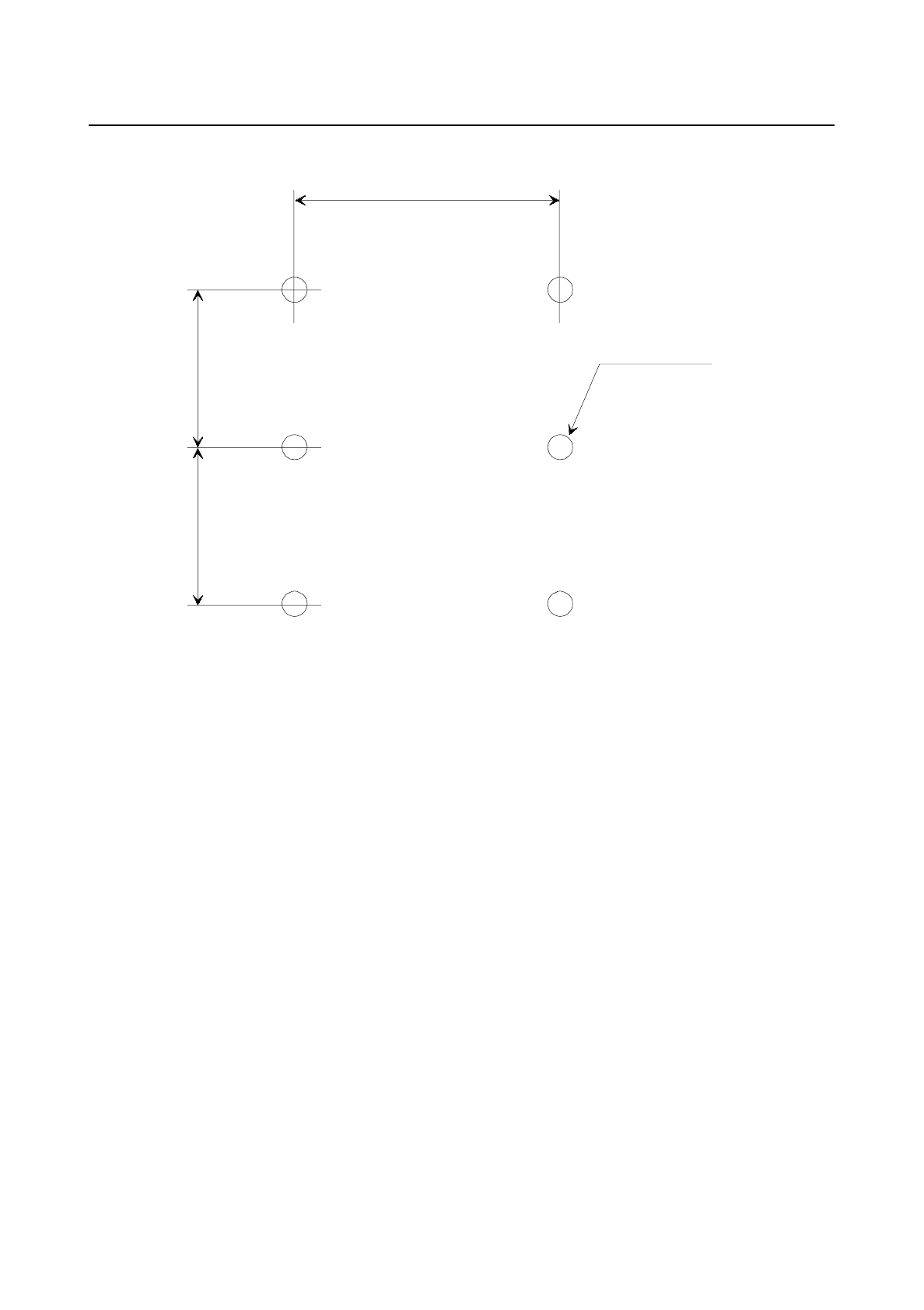
Base Transceiver Installation
Station Equipment IMN:BTSE BS11
46 A30808-X3247-B359-2-7631
164mm
100mm100mm
6 holes diam. 9mm
Fig. 3.3. Holes for wall mounting
- With reference to Fig. 3.4. fasten bracket (1) to the wall using six diameter 8
(2) screws and relative washers (3).
- Connect the BTSE joined with bracket (4) to bracket (1).
- Tighten the M5 hexagonal head cap screw (5) using the proper wrench
supplied.
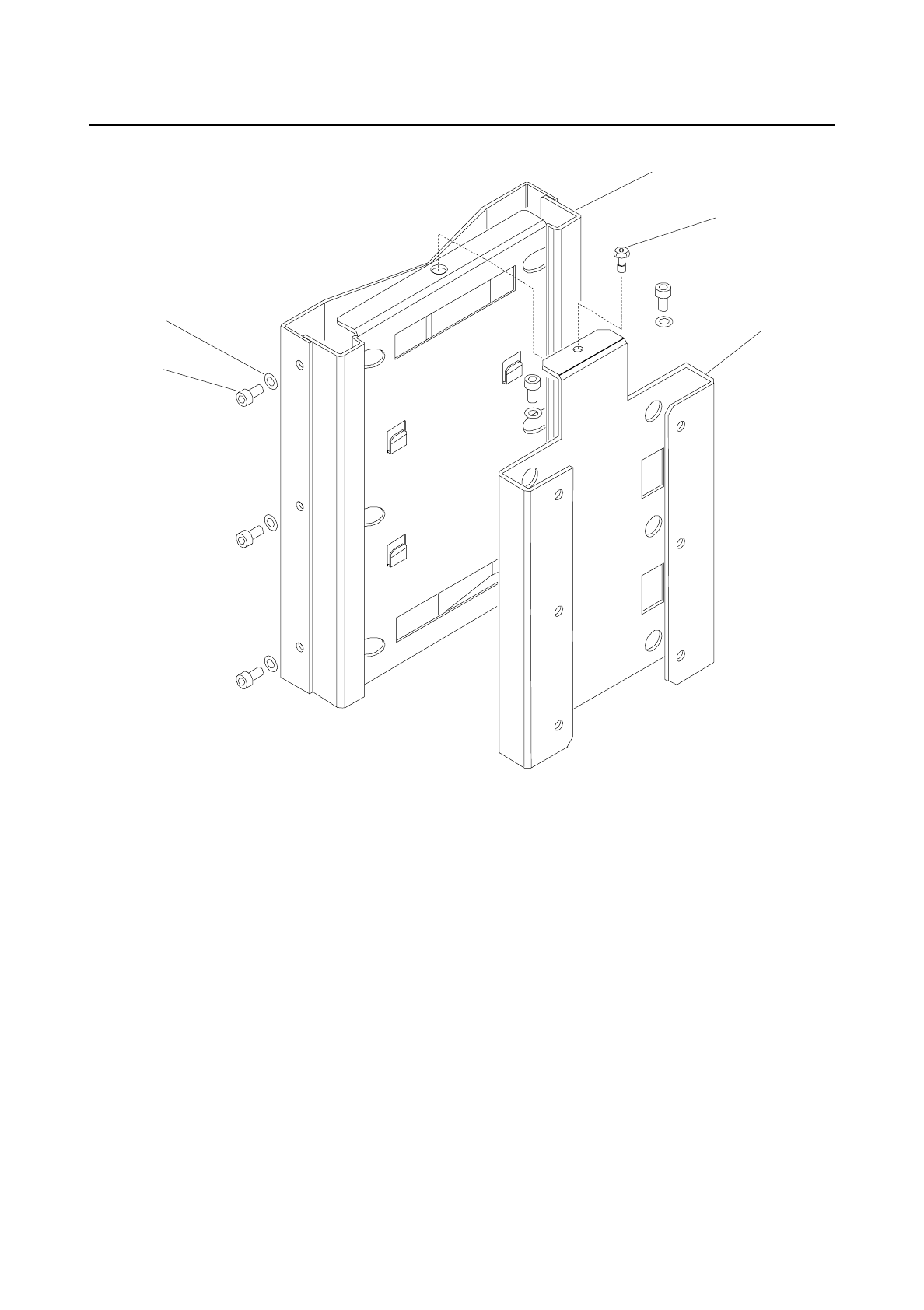
Installation Base Transceiver
IMN:BTSE BS11 Station Equipment
A30808-X3247-B359-2-7631 47
1
5
4
2
3
Fig. 3.4. BTSE: Wall mounting frame
3.5.4. Dummy panel mounting
After removing the antenna from the box, proceed as follows to install it (Fig. 3.5):
- Position the dummy panel (1) on the front of the BTSE.
- Tighten the four screws (2).
3.5.5. Solar shield mounting
After removing the three elements that make up the solar shield from the box,
proceed as follows (Fig. 3.5.):
- Position the upper panel (3) on the top of BTSE and fasten it with the four M4
Phillips head screws (4) tightening them with the appropriate wrench.
- Position panels (5) and (6) correctly on the BTSE and fasten them with the
relative fastening screws (7) using the appropriate wrench supplied.
NOTE:
An extra screw is provided.
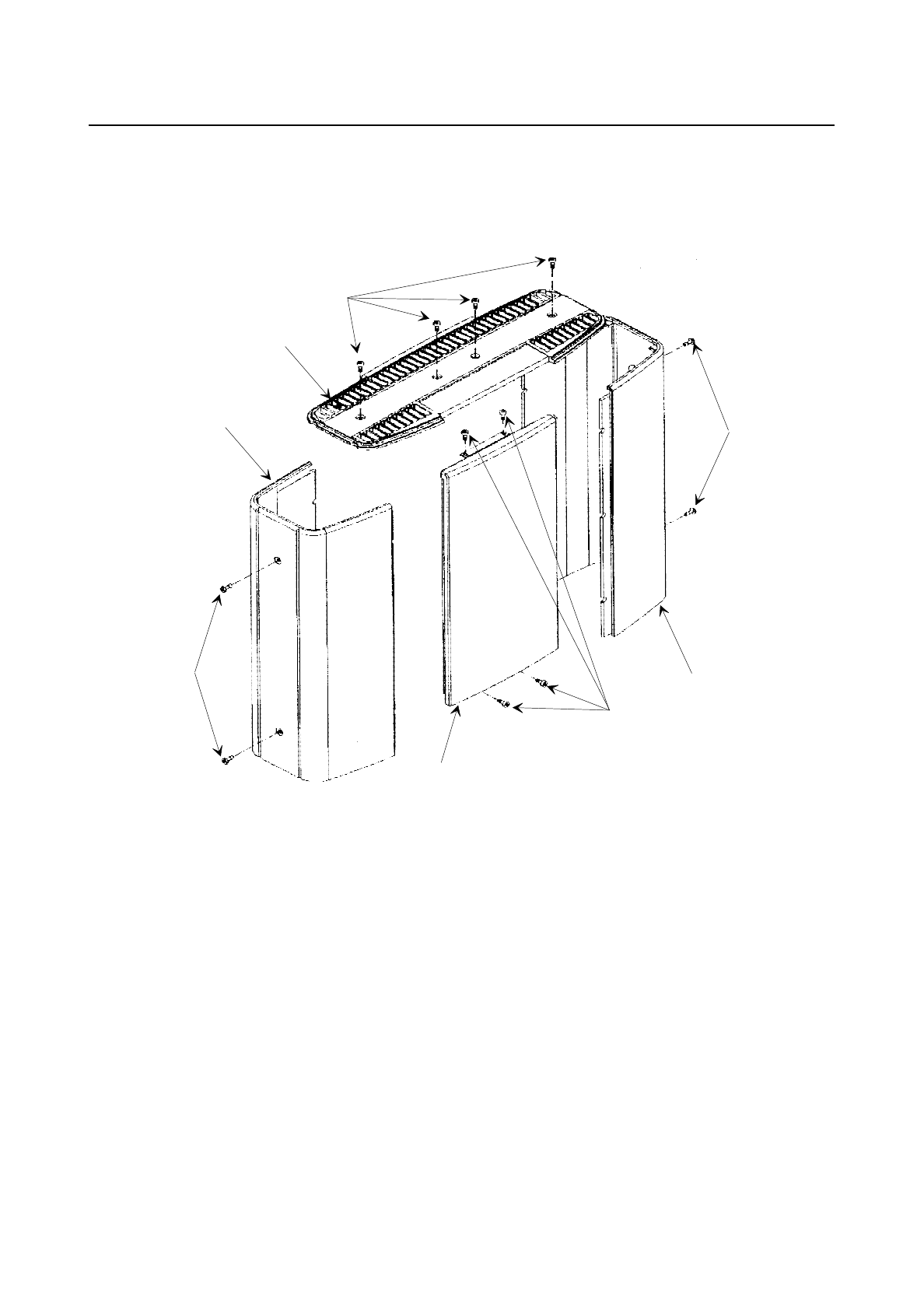
Base Transceiver Installation
Station Equipment IMN:BTSE BS11
48 A30808-X3247-B359-2-7631
4
3
7
2
7
1
5
6
Fig. 3.5. Solar shield mounting

Installation Base Transceiver
IMN:BTSE BS11 Station Equipment
A30808-X3247-B359-2-7631 49
3.6. Pole Mounting of the BTSE
3.6.1. Installation Tools
The correct rack installation is carried out with the aid of the following tools:
- Standard toolkit for BTSE installation.
- Spirit level.
- Plumb bob.
- Saw with shavings exhauster filter (for elevated floor only).
- Hammer drill.
- Hammer.
- Screw driver for cross-slotted screw.
For installation of power distribution panels, cable ducts, antenna, cableways and
other infrastructure equipment, additional tools could be necessary.
3.6.2. Ancillary Material
The following ancillary materials are needed:
- Plumb line.
- Colophony.
- Adhesive tape (yellow/green) for labelling.
- Cable fasteners.
3.6.3. BTSE Installation Procedure
Prior to the commencement of BTSE installation, consult the site documentation
to locate the installation point of the BTSE, the PCM 30 network termination, the
connection point for AC mains and the nearest ground tag. Necessary installation
material such as wall plugs and screws (both for fixing the wall mounting frame to
the wall and for fixing the base plate to the wall mounting frame) and washers for
correct adjustment come with the delivery.
The system selected for pole installation is the BAND IT System. Installation is
possible on poles ranging from 50 mm to 300 mm.
The following Kits of BAND IT products are available:
- BAND 19 x 0.76 mm type B x 206 q.ty 30 meters
- BUCKLE 19 mm type B x 256 q.ty 100 units
- Special BAND IT type B x 201 q.ty 1
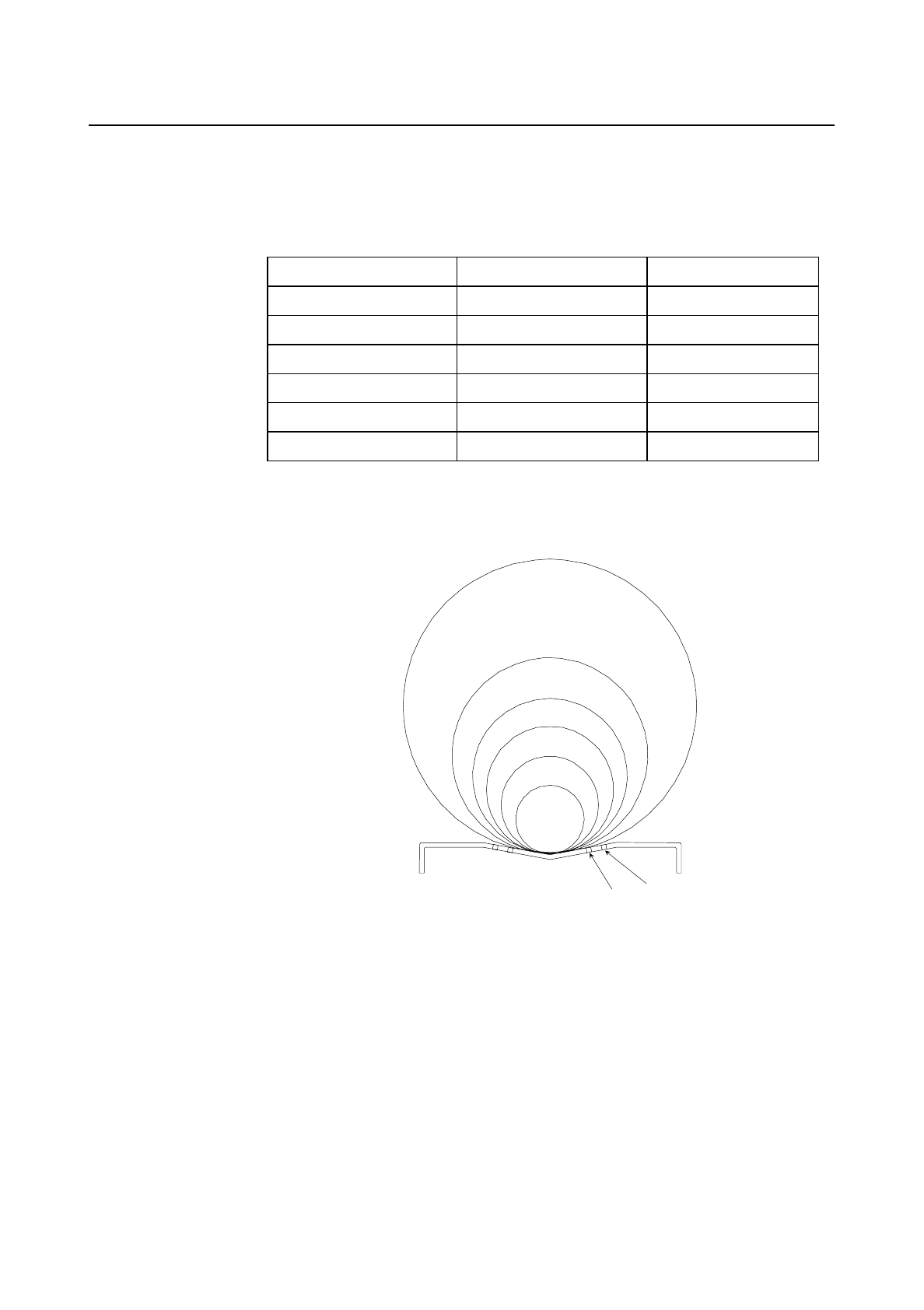
Base Transceiver Installation
Station Equipment IMN:BTSE BS11
50 A30808-X3247-B359-2-7631
Use the number of tapes (2 or 3) indicated below in relation to the pole diameter.
Use the holes indicated for fastening.
Pole diameter Tape passage hole Number of tapes (N)
70 mm n.1 3
100 mm n. 1 3
130 mm n. 2 3
160 mm n. 2 2
200 mm n. 2 2
300 mm n. 2 2
70mm
100mm
130mm
160mm
200mm
300mm
2
1
Proceed in steps as follows (Fig. 3.6.):
- Position bracket (1) on the pole (2). For this purpose:
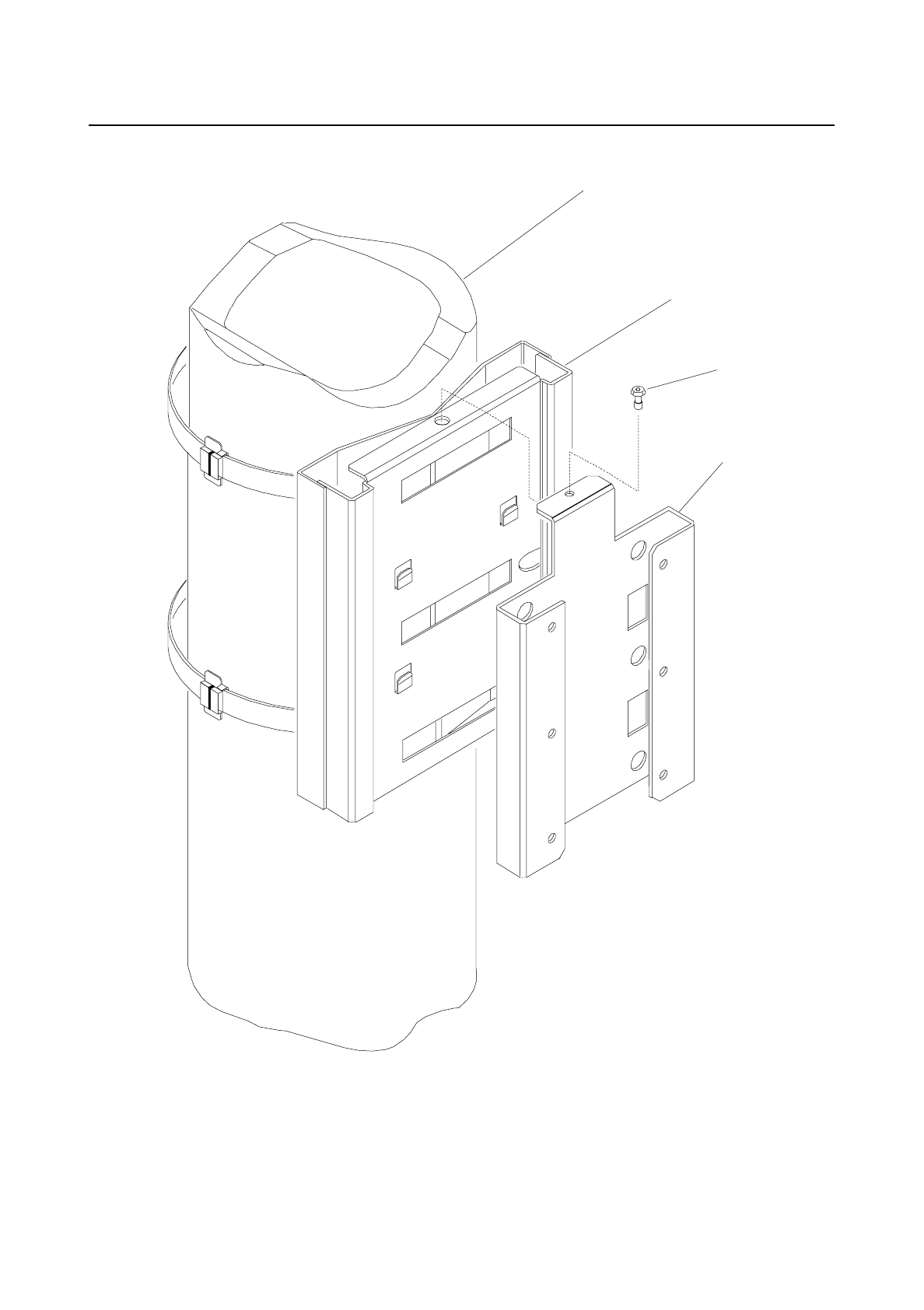
Installation Base Transceiver
IMN:BTSE BS11 Station Equipment
A30808-X3247-B359-2-7631 51
2
1
4
3
Fig. 3.6. BTSE: Pole mounting frame
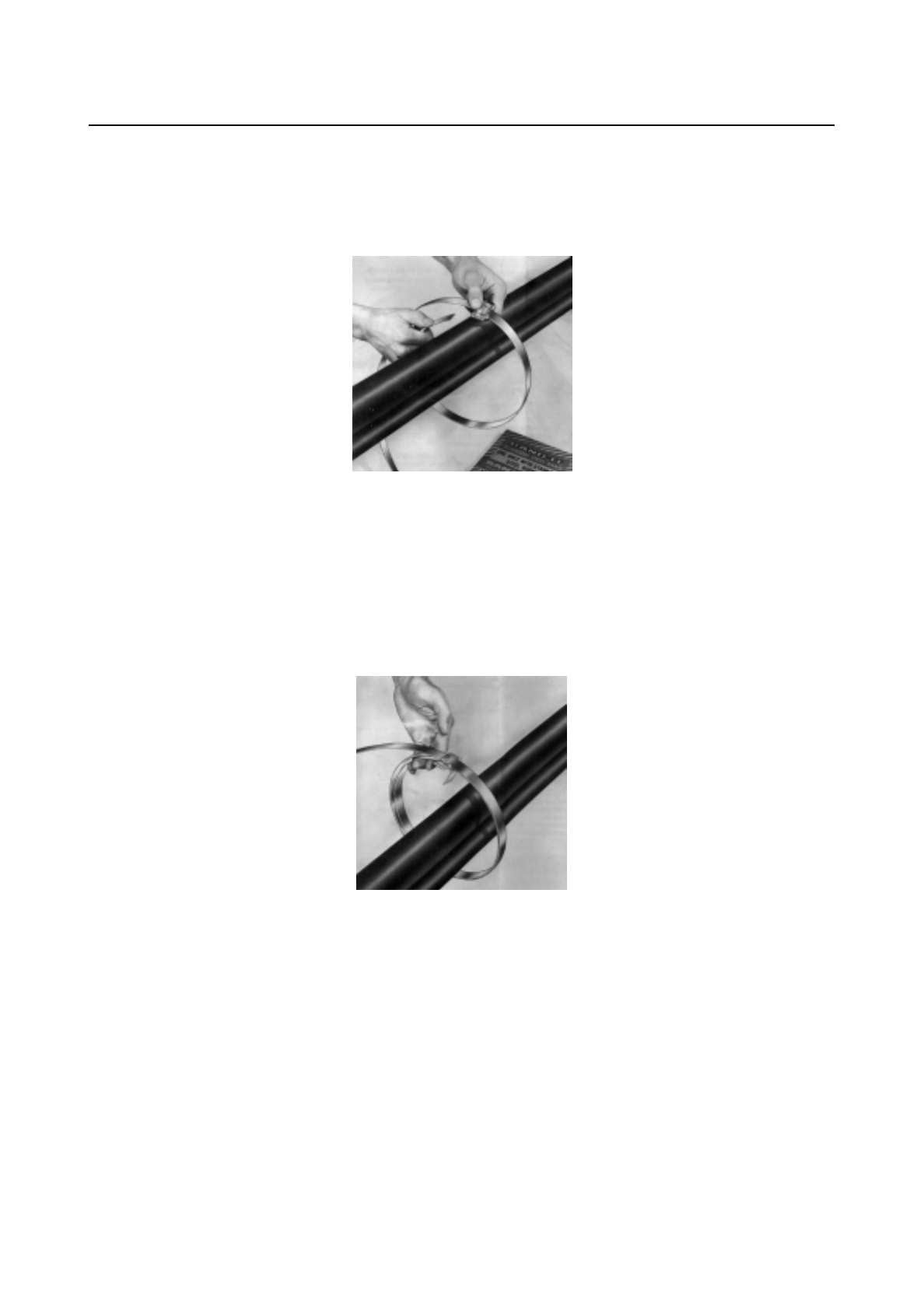
Base Transceiver Installation
Station Equipment IMN:BTSE BS11
52 A30808-X3247-B359-2-7631
· Band may be used from bulk roll as this completely eliminates waste of
band. Slide buckle on band as shown in Fig. 3.7. bringing end of band
around object to be clamped and again through buckle.
Fig. 3.7. Buckle slided on band
· Continue band around object once more and again through buckle (Fig.
3.8.) Double banding develops a great deal more radial compression than
single banding. Bend end of band under buckle.
Fig. 3.8. Band around pole
· Place band in open slot of tool nose and in slide (Fig. 3.9.). With thumb
on band gripper lever, apply tension by turning handle of tool. After
tension is created, it is no longer necessary to hold band gripper lever as
it locks itself under tension.
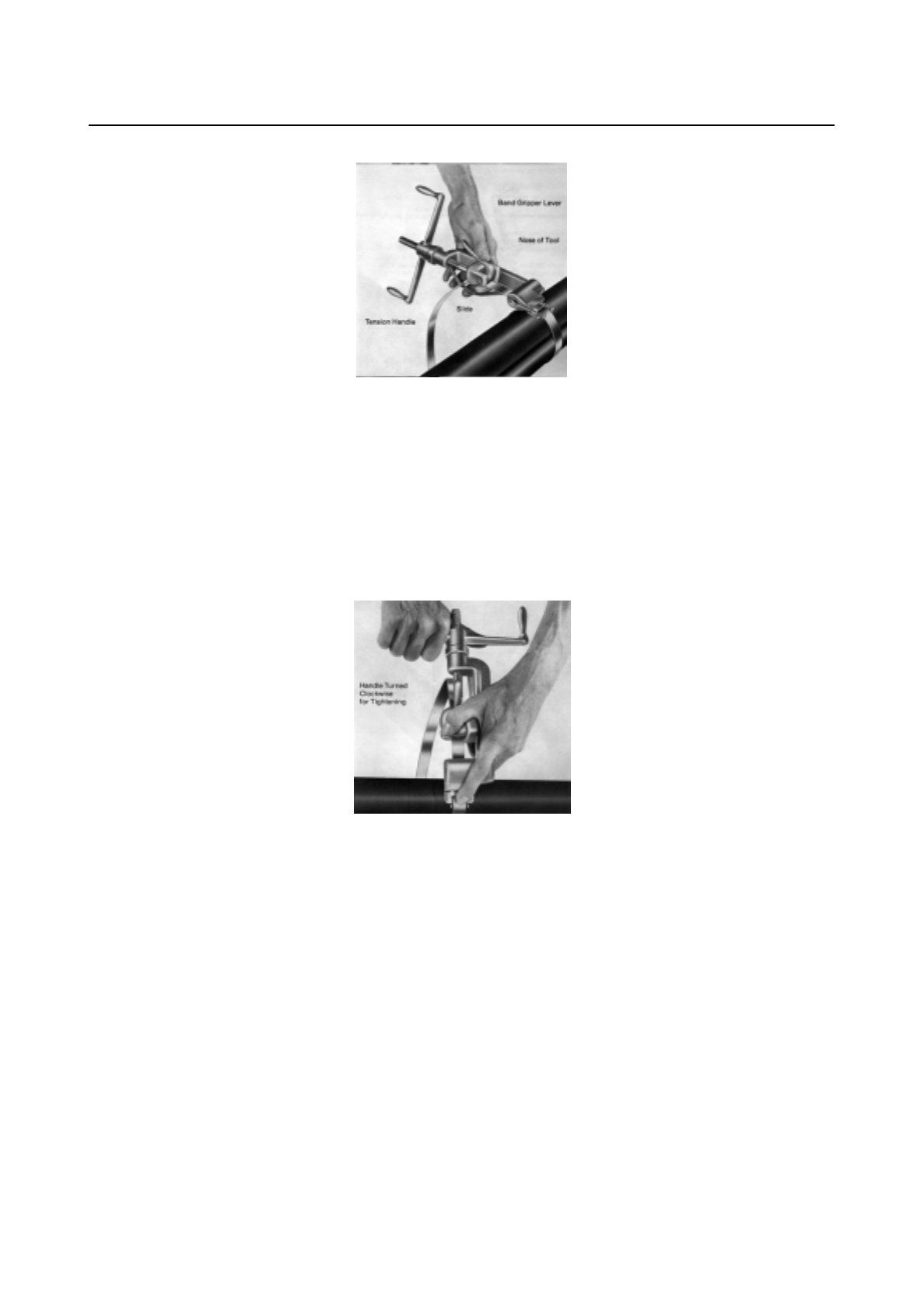
Installation Base Transceiver
IMN:BTSE BS11 Station Equipment
A30808-X3247-B359-2-7631 53
Fig. 3.9. Apply tension
· Place finger on Band-It Band at buckle bridge while tensioning with tool
handle, maximum pressure is being exerted bu the Band-It Band around
object being clamped. Stop turning handle (Fig. 3.10.).
Fig. 3.10. Tightening
· Roll tool over buckle, backing off with tension handle throughout entire
rolling operation (Fig. 3.11.). Failure to back off with tension handle
throughout entire course of roll may result in breaking of band. There is
no loss of tension as band released is used up in the bend.
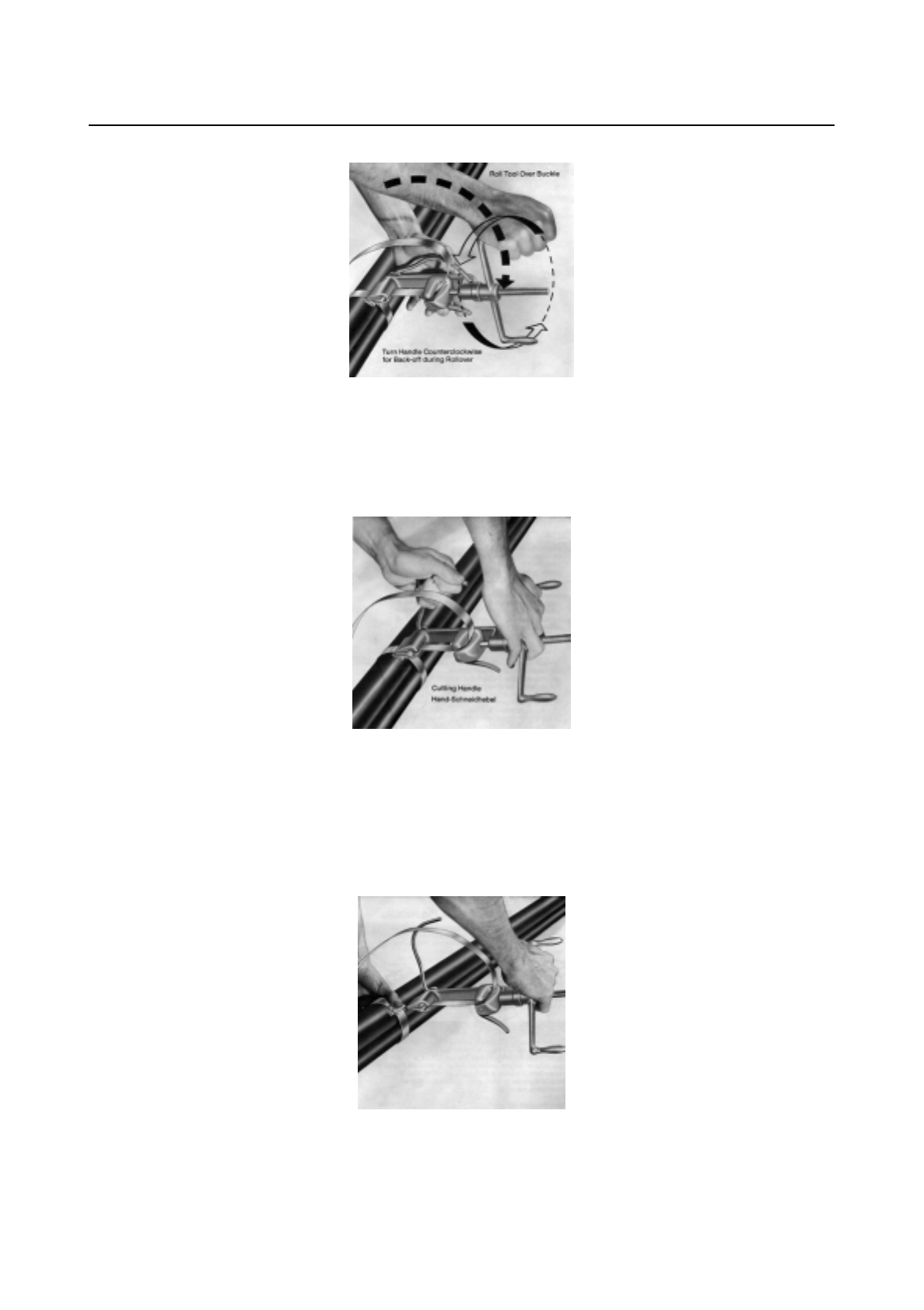
Base Transceiver Installation
Station Equipment IMN:BTSE BS11
54 A30808-X3247-B359-2-7631
Fig. 3.11. Rolling tool
· Pull cutting handle to cut the band (Fig. 3.12.).
Fig. 3.12. Cutting the band
· Remove tool, holding stub of band down with thumb (Fig. 3.13.).
Fig. 3.13. Removing tool
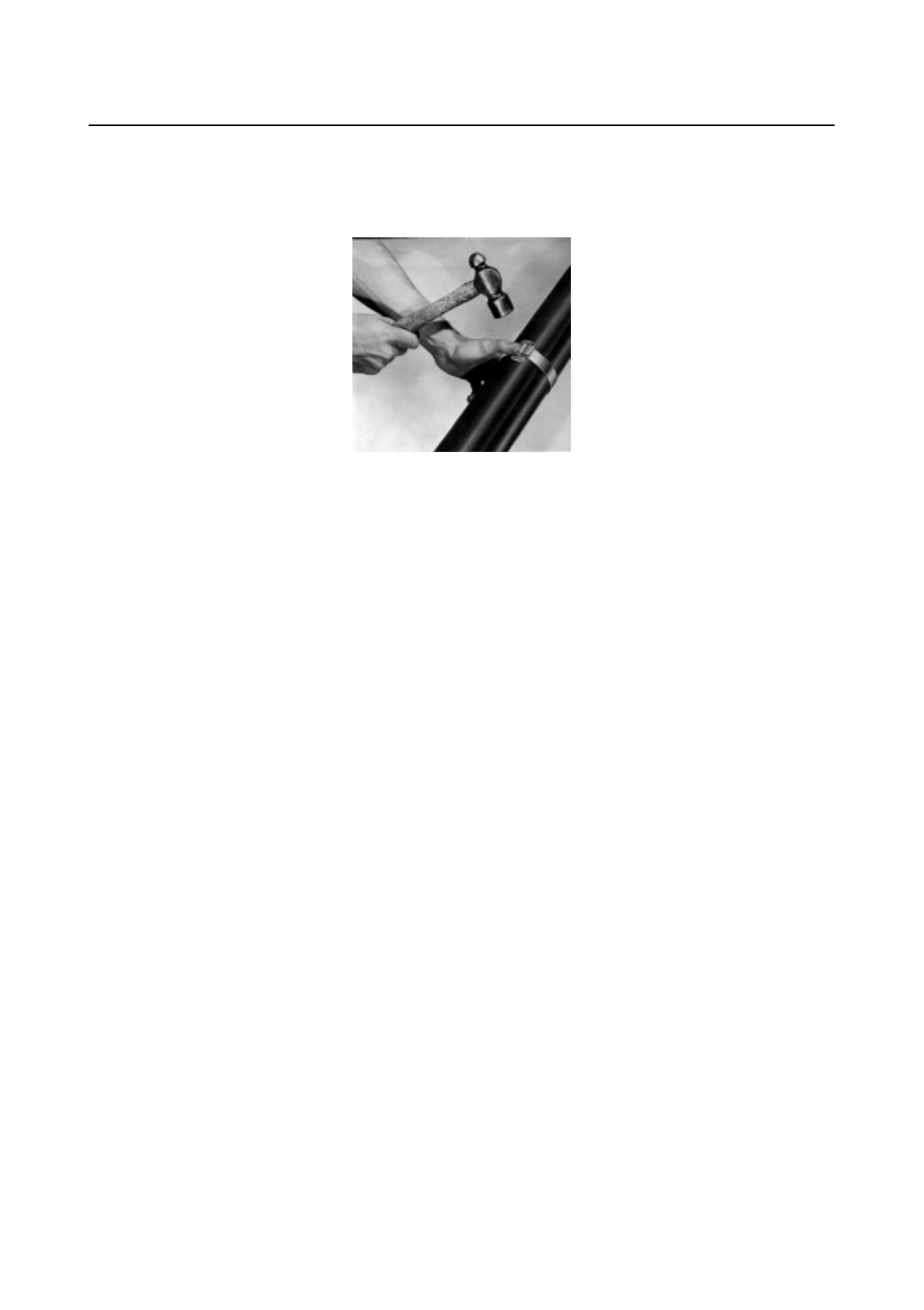
Installation Base Transceiver
IMN:BTSE BS11 Station Equipment
A30808-X3247-B359-2-7631 55
· Clink stub by hammering down buckle ears, completing Band-It clamp
(Fig. 3.14.).
Fig. 3.14. Hammering buckle ears
- Connect the BTSE joined to bracket (3) to bracket (1).
- Tighten the M5 hexagonal head cap screw (4) using the proper wrench
supplied.
3.6.4. Solar shield mounting
Refer to section 3.5.5, where the procedure has already been described.
3.7. External Cabling Activities
This chapter gives information required for installing the external cables between
the BTSE and the infrastructure equipment.
The rack cannot function without the following cable connections:
- terminal block: connection point of 230 V AC or 110 V AC
- ground bolt: grounding system
- Abis interface: PCM30 links
- RX/TX antenna connectors: transmit/receive antennas (just connected)
Refer to Fig. 3.15. for the location of the connectors at the connection panel and
remember that TX2 is not used.
The functions of the commands, indicators, connectors and fuses of the
connection panel are as follows:
Y01: Reception of the first PCM flux from BSC or from preceding BTSE
Y02: Transmission of the first PCM flux to BSC or from preceding BTSE

Base Transceiver Installation
Station Equipment IMN:BTSE BS11
56 A30808-X3247-B359-2-7631
Y03: Reception of the second PCM flux from BSC or from the
following/preceding BTSE
Y04: Transmission of the second PCM flux to BSC or to the following
BTSE
J01: Test and alarm connector
P1: Power supply connector
F1-F2-F3-F4: 10A delayed fuses (F2-F4 spare in MonoTRX)
SL01: Led with green light (when turned on it signals the presence of the
230 V AC power supply voltage)
ON/OFF: Power supply switch. It is provided with protection against
accidental shutdown.
RX0/TX0: First RF reception (diversity) and RF transmission
RX1/TX1*: Second RF reception (diversity) and *RF transmission if BiTRX
TX0: RF transmission
Note that all the cables external to the BTSE (as well as the internal ones) must
be at zero self-extinguishing halogens.
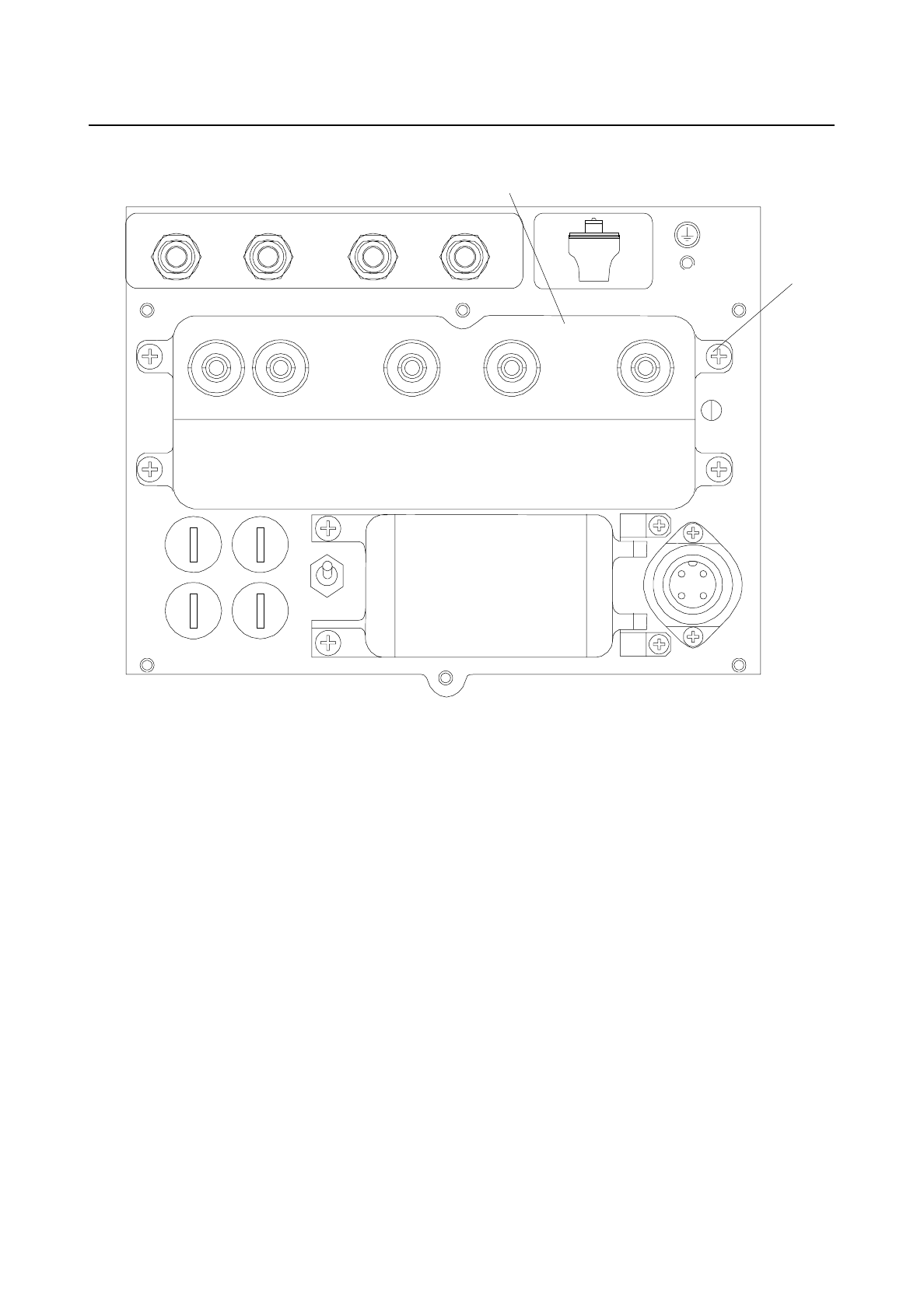
Installation Base Transceiver
IMN:BTSE BS11 Station Equipment
A30808-X3247-B359-2-7631 57
RX2aTX0/RX0
JØ1 YØ1 YØ2 YØ3 YØ4
SLØ1
P1
F4 F3
F2 F1
ON/OFF
2
1
a = Diversity for MonoTRX
b = BiTRX
TX1/RX1b
Fig. 3.15. Connection panel
3.7.1. Ground and Power Supply Connections
The grounding and power supply connections must conform to the standards in
force in the Country where the installation takes place.
A main cable in flexible raceway-plug is required for connecting the BTSE to the
connection point of the 230 V AC power supply.
The terminal block for the 230V AC mains input is located below the BTSE (Fig.
3.16.).
The BTSE accepts either of the following nominal operating voltages indifferently:
- 110 V +15% -25% - 50 Hz ±10% - 60 Hz ±10% 220 W Max MonoTRX
- 230 V +15% -25% - 50 Hz ±10% - 60 Hz ±10% 320 W Max BiTRX
To connect the BTSE with the AC mains connection point proceed with the
following steps:
- Using the appropriate wrench, remove the box covering the connectors,
located on the lower side of the BTSE.

Base Transceiver Installation
Station Equipment IMN:BTSE BS11
58 A30808-X3247-B359-2-7631
- Refer to the site documentation for the required information about type and
location of the 230 V AC connection point.
- The dimensioning of the power supply cable, of the grounding cable and of
the magneto-thermal switch must be carried out according to the
configuration of the BTSE installation site and with respect for the standards
in force in the Country in which the installation takes place.
- Check the actual distance between the shelter and the connection point.
- Cut the cable for the required length.
- Fix wire end sleeves at the end that is to be connected to the connector.
- Lead the prepared cable through the cable access at the bottom of the
shelter.
- Insert the prepared ends into the connector. With regard to the connector
wiring, consult the instructions contained in the appendix.
- Fix the cable at the cable access by cable strap.
- Lead the main cable to the connection point for 230 V AC.
Note that the type and location of the mains connection point are subject to
modification. They are dependent on site and customer requirements. A
description of the connecting procedure does not form part of this manual. For
further information refer to the site documentation and use the corresponding
manufacturer documents.
The BTSE must be connected to the ground system.
For this purpose, there is a 6 mm diameter threaded hole underneath the BTSE.
Connect the BTSE and ground system as follows:
- Use the nearest connection point of the ground system.
- Ascertain the distances between the connection points of the ground system
and the ground bolts of the shelter.
- Cut the cable (insulated, 6 mm²) to the required length.
- Remove the cable covering at the end to connect to the ground hole (length
approx. 7 mm).
- Fasten a cable terminal to the ground cable and fasten it to the ground hole
with a hexagonal head cap screw and 2 washers.
- Connect the prepared cable end to the ground bolt.
- Tighten the nut firmly.
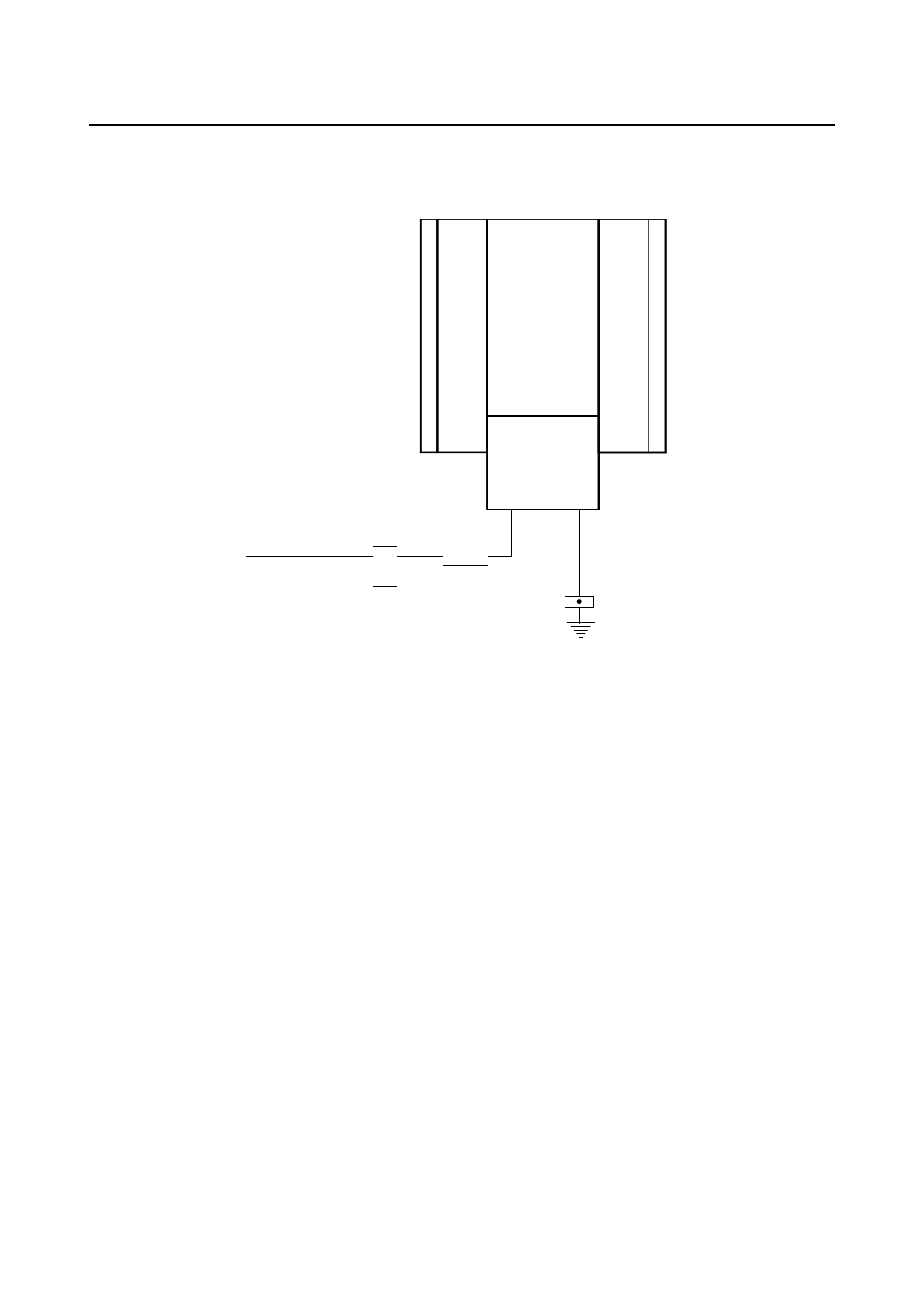
Installation Base Transceiver
IMN:BTSE BS11 Station Equipment
A30808-X3247-B359-2-7631 59
Ma
g
neto termal
differential
BTSE
Mains
(
230 Vac/50 Hz
)
Junction box with screw
terminals
(
o
p
tionals
)
1. AC Main
connector
Hirshman CA3LD
P/N 2450000330
2. AC Main Cable
2x1,5 mm antifire
P/N 2268124229
Fig. 3.16. Ground and power supply connections (example)
3.7.2. Abis Interface - PCM 30 Link Equipment
The PCM30 links access the BTSE via the Abis-interface, located at the
connection panel (see Fig. 3.15.).
Fig. 3.17. shows three possible Abis configurations to connect the BTSE to the
BSC. These configurations are called Star (single), Loop (several in circle) and
Multidrop (several).
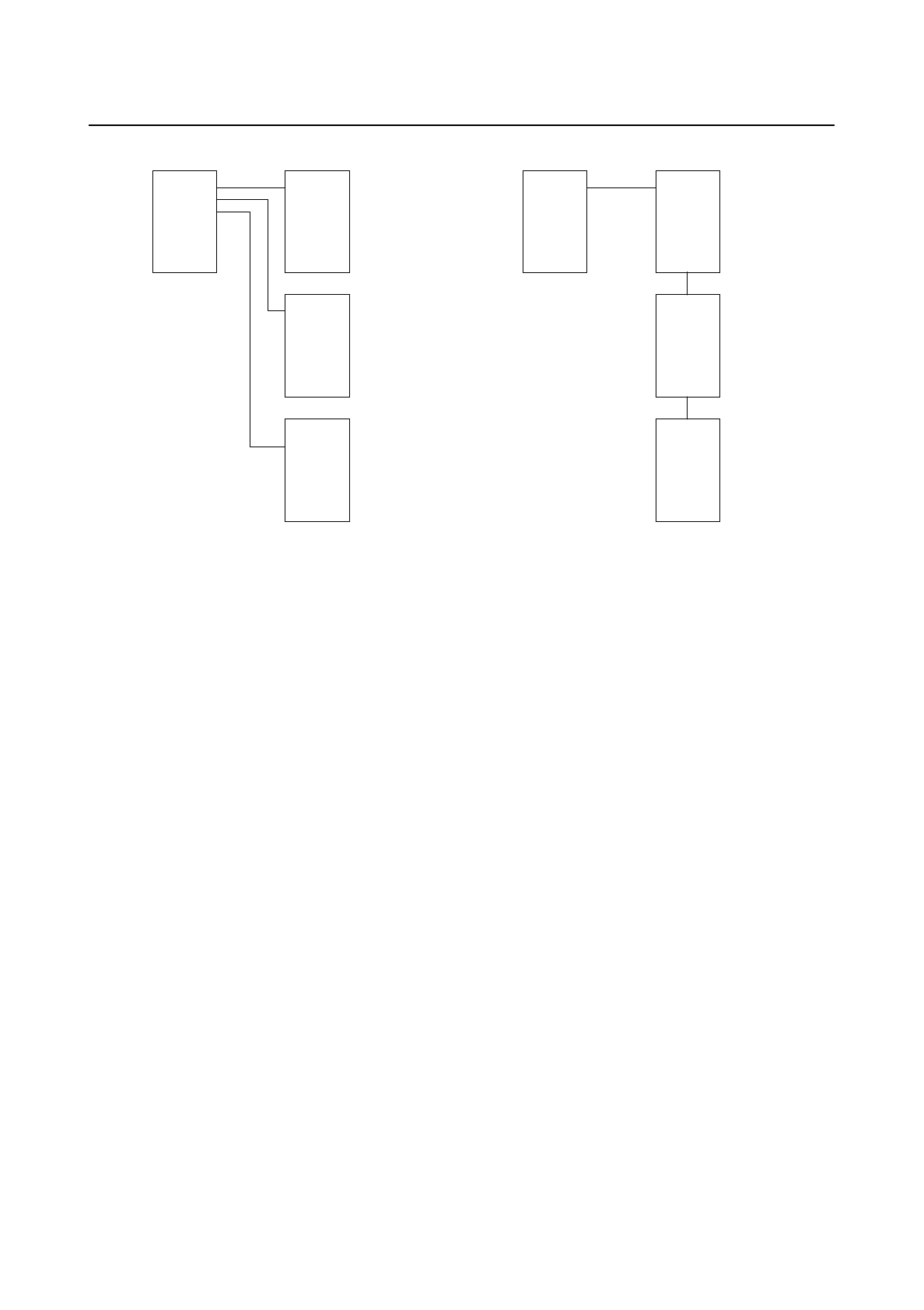
Base Transceiver Installation
Station Equipment IMN:BTSE BS11
60 A30808-X3247-B359-2-7631
BTSE1
BTSE2
BTSE3
BSC BSC
STAR MULTIDROP
BTSE1
BTSE2
BTSE3
Fig. 3.17. STAR/MULTIDROP Configuration
The functions of the Y01 ÷ Y04 connectors (reception and transmission of the
PCM fluxes) are illustrated in Fig. 3.18. ÷ Fig. 3.20.
Connection of the Abis-interface to the PCM 30 link terminal on site is as follows:
- Refer to the site documentation for the required information about the location
of the PCM 30 link terminal, the type of shielded cable and of connector,
which have to be used.
- Determine the real distance between rack and link terminal.
- Cut the PCM cables to the required length.
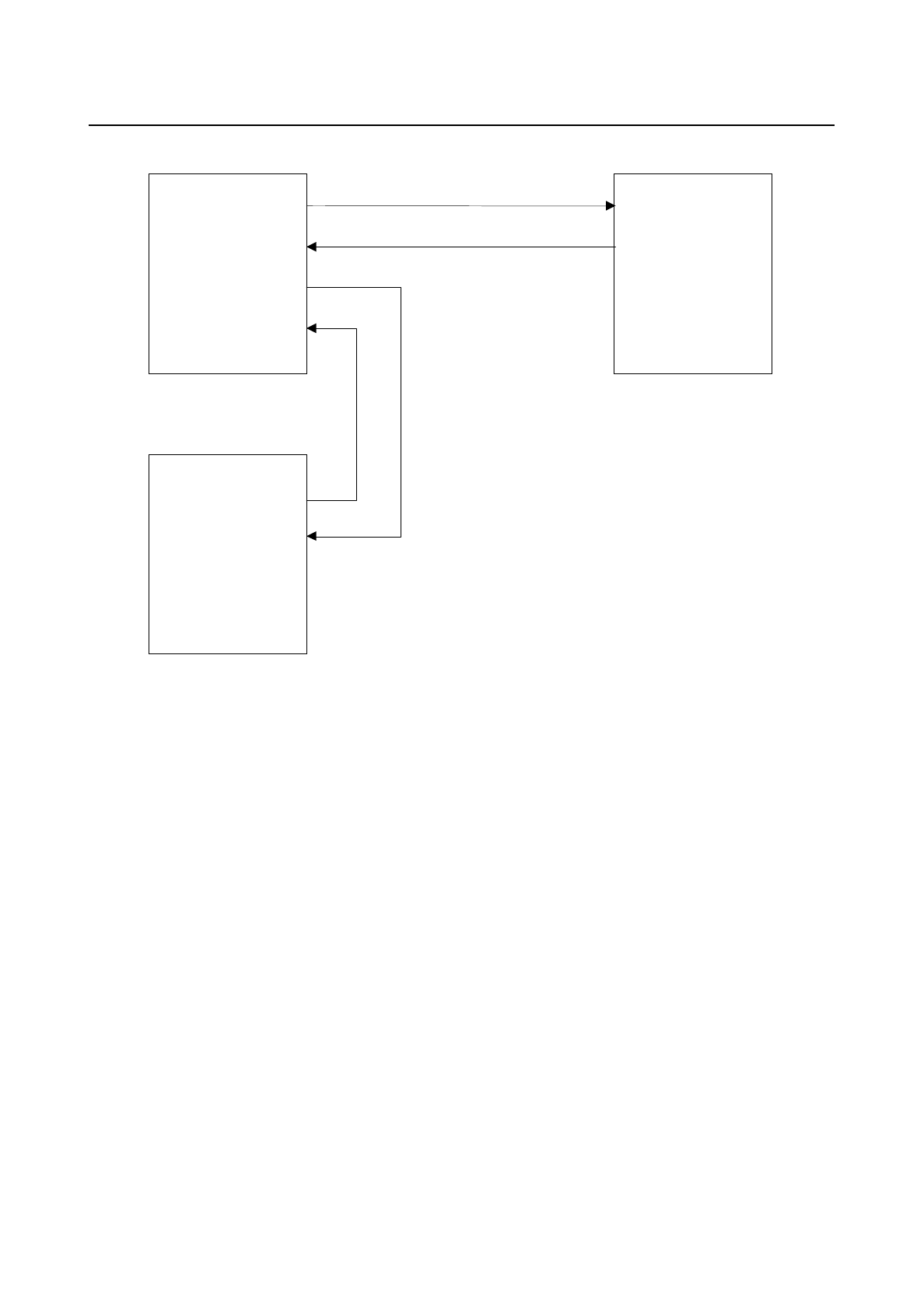
Installation Base Transceiver
IMN:BTSE BS11 Station Equipment
A30808-X3247-B359-2-7631 61
YØ2
BSC
YØ4
YØ3
Tx
Rx
Tx
Rx
BTSE
BTSE
YØ1
Fig. 3.18. Multidrop configuration Functions of Y01 ÷ Y04 connectors
- With reference to Fig. 3.21., remove the four screws (1) and remove the
cover (2) to gain access to the Y01 ÷ Y04 connectors (Fig. 3.22.).
- Insert the four PCM cables in the four holes of the cover removed earlier.
- Abut the PCM cables to the relative connectors (the procedure is shown in
the appendix).
- Pass each cable in the respective core hitch.
- Abut the movable connector to the cable.
- Insert the movable connectors in the respective fixed connectors.
- The BTSE is supplied with the output impedance preset to 75 Ω and with the
PCM cable shield grounded. Whenever it is necessary to use the output
impedance at 120 Ω or to disconnect the ground shield, consult the
ITMN:BTSE BS11 manual.
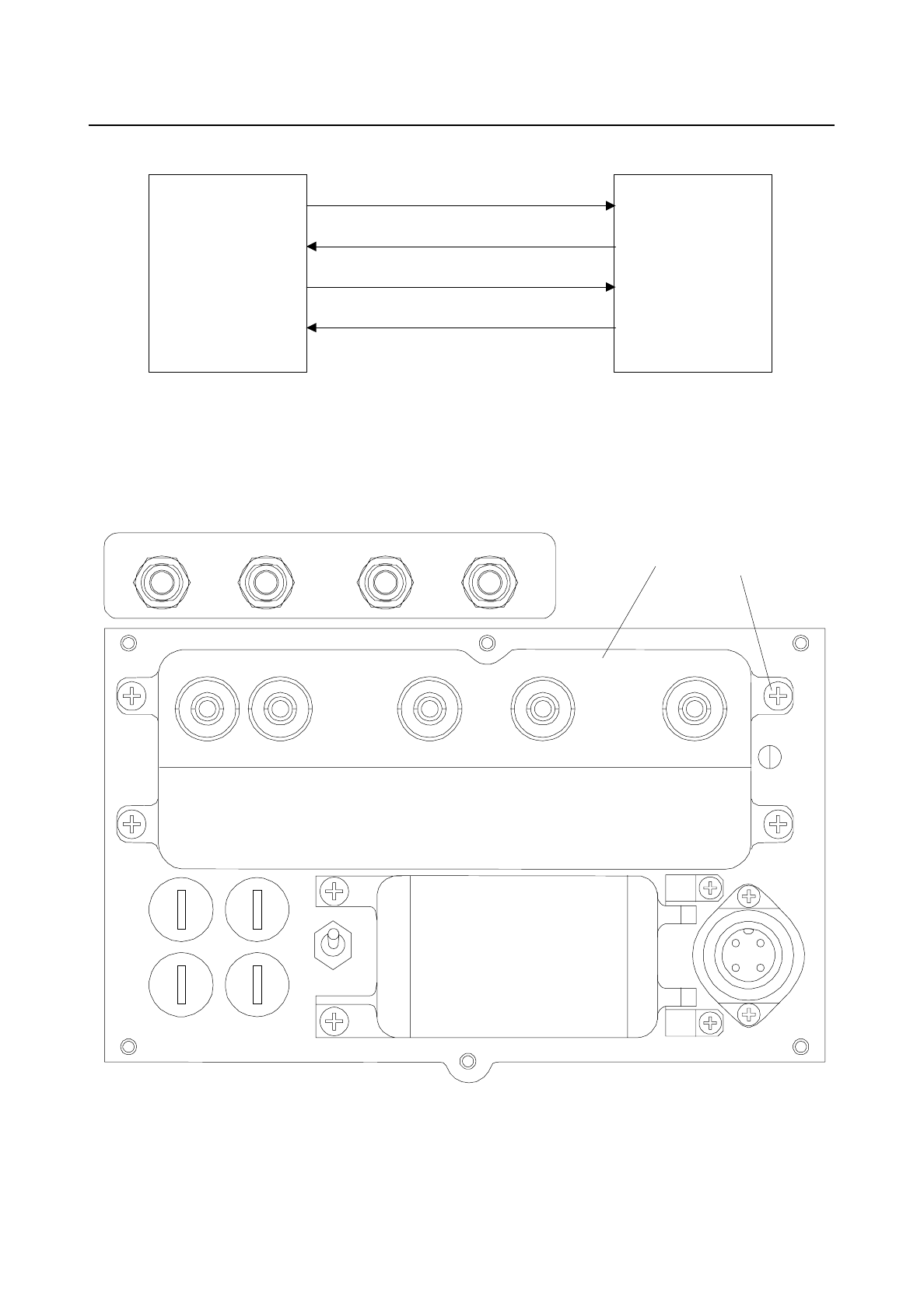
Base Transceiver Installation
Station Equipment IMN:BTSE BS11
62 A30808-X3247-B359-2-7631
YØ2
BSC
YØ4
YØ3
Tx
Rx
BTSE
YØ1
Tx
Rx
Fig. 3.19. Star configuration Functions of Y01 ÷ Y04 connectors
RX1 TX0/RX0
JØ1 YØ1 YØ2 YØ3 YØ4
SLØ1
P1
F4 F3
F2 F1
ON/OFF
21
Fig. 3.20. Connection Panel
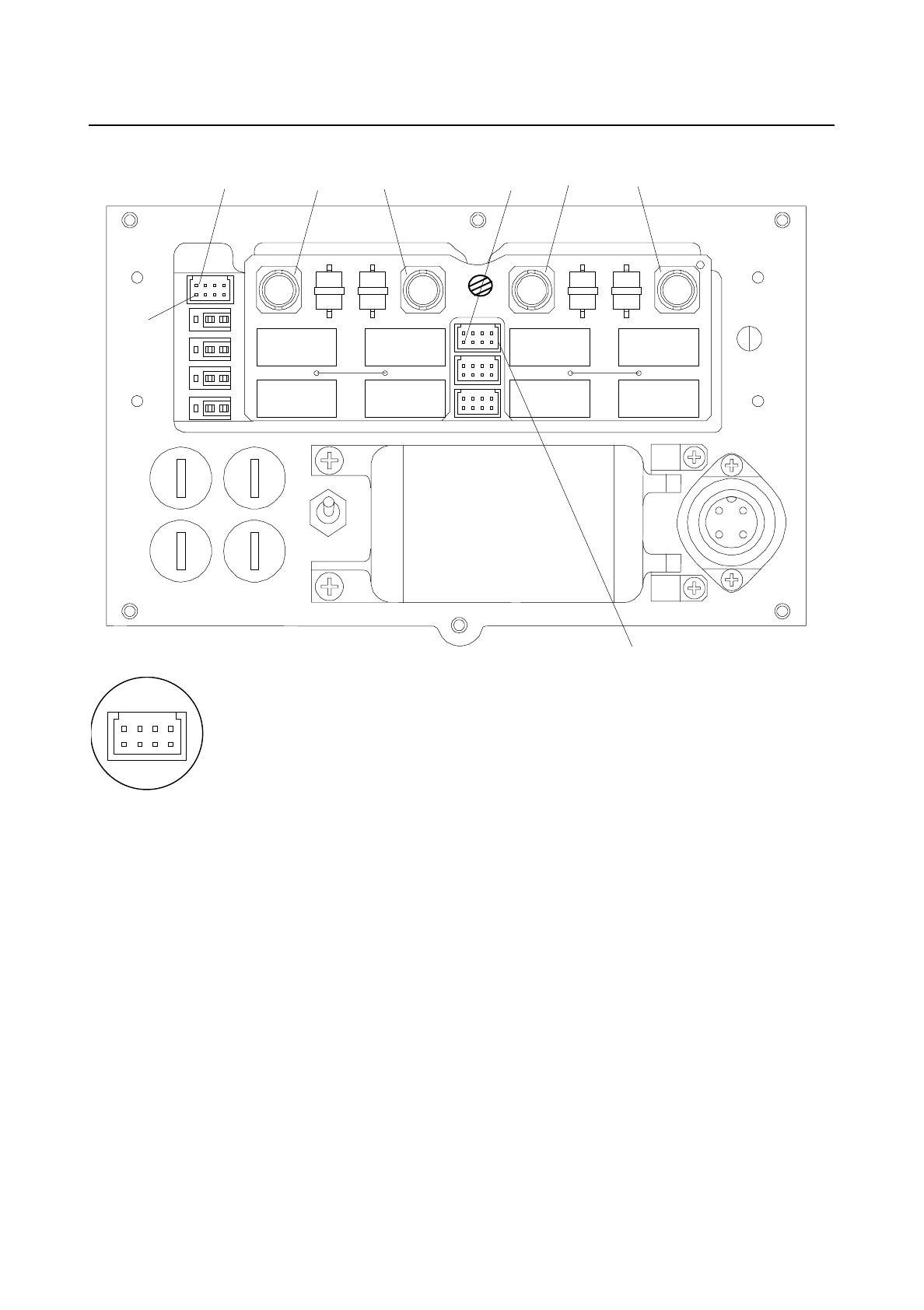
Installation Base Transceiver
IMN:BTSE BS11 Station Equipment
A30808-X3247-B359-2-7631 63
JØ2
JØ1 YØ1 YØ2 YØ3 YØ4
pin1
pin1
2
1
4
3
6
5
8
7
2
1
4
3
6
5
8
7
NOTE:
The pin aut of J01 and J02 is in par. 4.6.3
Fig. 3.21. Y01 ÷ Y04, J01 and J02 connectors
3.7.3. Connection to the J01 connector
After having connected the PCM30 cables, before closing the connector panel,
connect the cable to the flying connector which will then be connected to J01.
The operations are described in the appendix.
NOTE:
The J02 connector serves for the connection with LMT.
3.8. Antenna Connections
The BTSE has to be connected to the transmit and receive antennas according to
Fig. 3.23. The antenna configuration and the required cabling are dependent on
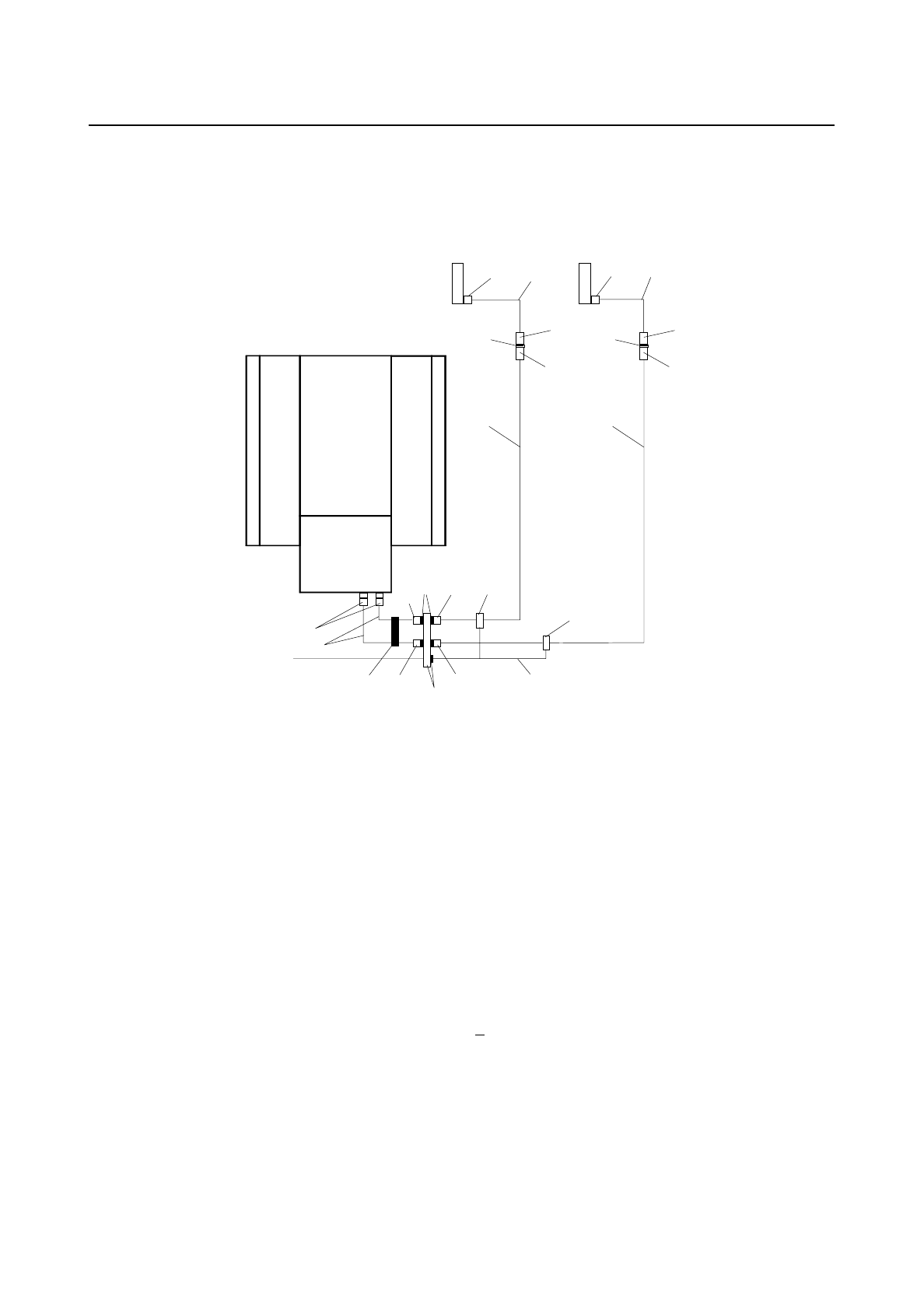
Base Transceiver Installation
Station Equipment IMN:BTSE BS11
64 A30808-X3247-B359-2-7631
the site. The cable pass plate (ref. 11) is shows in fig. 3.24.
For detailed information refer to the site- specific documentation or use the
corresponding customer documents. This section gives information about the
antenna connections and the connecting procedure of the BTSE.
112
2
3
6
4-5 3
6
4-5
77
8-9
10
1
2
13
11-9
61
112 68-9
1 Coaxial connector mole type N N15015CA N-P/N 24504000018
2 Coaxial cable RT 5020
3 Coaxial connector female type N N15022C4 G-P/N 24504000025
4 Self-agglomerative Rubber tae P/N 20750000206
5 Isolation tape PVC P/N 2075000031
6 Coaxial connector Male type N fo 1/2 cable P/N 24504003077
7 Coaxial cable 1/2 P/N 22580000175
8 Grounding kit for 1/2 cable P/N 2259000086
9 Spade Pug for 6 mm cable P/N 2600440080
10 Ground cable 6 mm P/N 22271215152
11 Cable pass Plate with ground kit P/N 94287275
12 RF Overvoltage Protection Suhner 3400.17.0038 P/N 6047000010
13 Tolson neck P/N 20710000538
NOTE: 1) The maximum atenuation of 1 GHz for connection between the
BTSE and the aerial antenna system (all included) must be 1.25
dB.
2) The return loss of the aerial antenna system must be at a maximum
of 15 dB (VSWR < 1,43)
Fig. 3.22. Antenna Cabling
The antenna cables access the BTSE via the cable access at the bottom of the
BTSE.
For connecting of the BTSE short antenna jumper cables must be prepared on
site.

Installation Base Transceiver
IMN:BTSE BS11 Station Equipment
A30808-X3247-B359-2-7631 65
Make sure that the BTSE is self-protected from adjacent structures with regard to
the atmospheric discharges in accordance with the standards in force in the
Country where it is installed. If the BTSE is not self-protected, a lightening rod
must be installed.
Connect the jumper cables as follows:
- Cut the coaxial cable to the required length
(distance between the BTSE antenna connectors and the ends of the
antenna feeder cables).
- Fix a N-type angle connector (male) at the end to be connected with the
antenna connectors.
- Fix a N male connector at the end to be connected with the antenna feeder
cable.
- Lead the jumper cable via the cable access to the antenna connector
Pay attention to the minimum bending radius of the cable.
- After fixing of the jumper cable at the antenna connector, use a cable
strap for cable fixing at the cable access.
- The TX / RX antenna must be connected to TX 1 connector and RX antenna
to RX 2 connector.
- We recommend placing the lightening discharge and the passage between
the antenna cable and the antenna down lead on the interconnection plate.
3.8.1. Antenna System Fulmination Protection
After having installed the antenna as indicated earlier, it is necessary to verify if
the structure is self-protected. Refer to European standards in effect in the
Country where the installation is carried out regarding fulmination protection. If
not, the antenna must be grounded by a system carried out according to the
standards in force. Use l/4 shorting stub by SYHNER or M/A-COM.
3.8.2. Antivandalism Protection
It is necessary to protect the cables with stainless steel or zinc-coated tubes or
with steel tubes covered with a steel and transparent PVC braid.
3.8.3. Cable Down-Leads
Always keep the feeders separate from the signal cables by means of separate
raceways.
Furthermore, ground the braid of the antenna cable at the beginning and at the
end of the lead-in.
Use 1/2”, 7/8” or Heliax type cables for the antenna lead-in, depending on the
distance between the antenna and the BTSE.
3.8.4. Interconnection Plate
Position the interconnection plate (not supplied) as close as possible to the BTSE
(Fig. 3.25.) and then carry out the connections between the antenna cables and
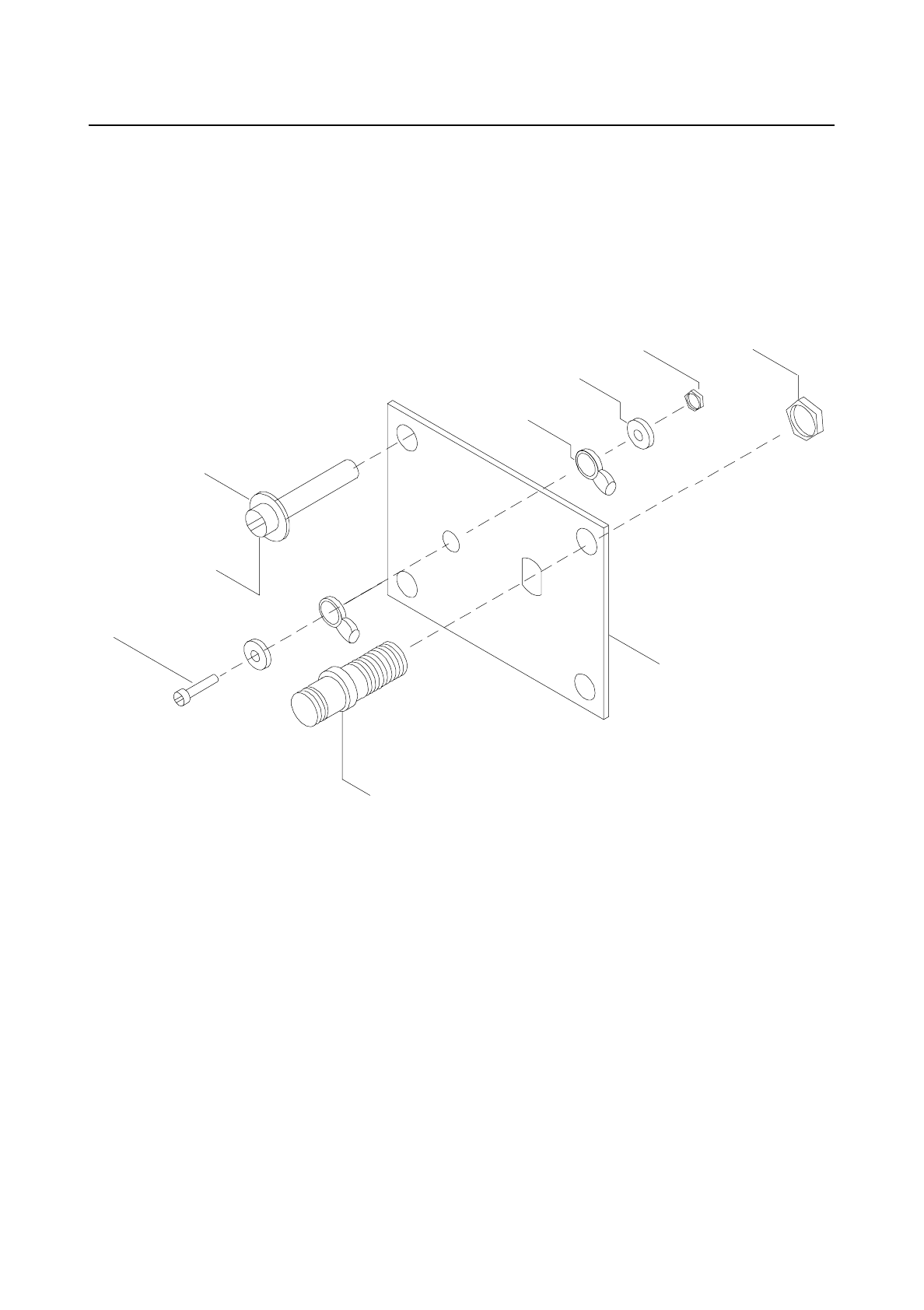
Base Transceiver Installation
Station Equipment IMN:BTSE BS11
66 A30808-X3247-B359-2-7631
the interconnection plate and between the interconnection plate and the BTSE.
Then ground the plate.
The interconnection plate is not supplied.
n. 4 INSERTS
code 06990000028
n.2 ADAPTER
code 24504003046
n. 1 SREW 6x16
code 06121010667
n. 4 WASHERS
code 06381001007
n. 2 LUGS
code 2600444262
n. 2 WASHERS
code 06381001014
n. 1 NUT
code 06241012545 ADAPTER NUT
PLATE
code 892084265
Fig. 3.23. Cable Pass Plate

Installation Base Transceiver
IMN:BTSE BS11 Station Equipment
A30808-X3247-B359-2-7631 67
Antenna cable
Inteconnection plate
RT 5020
BTSE
Fig. 3.24. Interconnection Plate
3.9. Post Installation Notes
After all installation works are finished and all cables clamped at the cable
access, close the cable entry box (2, Fig. 3.21.).
Close the connector panel cover using the proper wrench.
Remove all packing material from site.
Call the commissioning staff for switch on, testing and network integration of the
Base Station.

Base Transceiver Installation
Station Equipment IMN:BTSE BS11
68 A30808-X3247-B359-2-7631
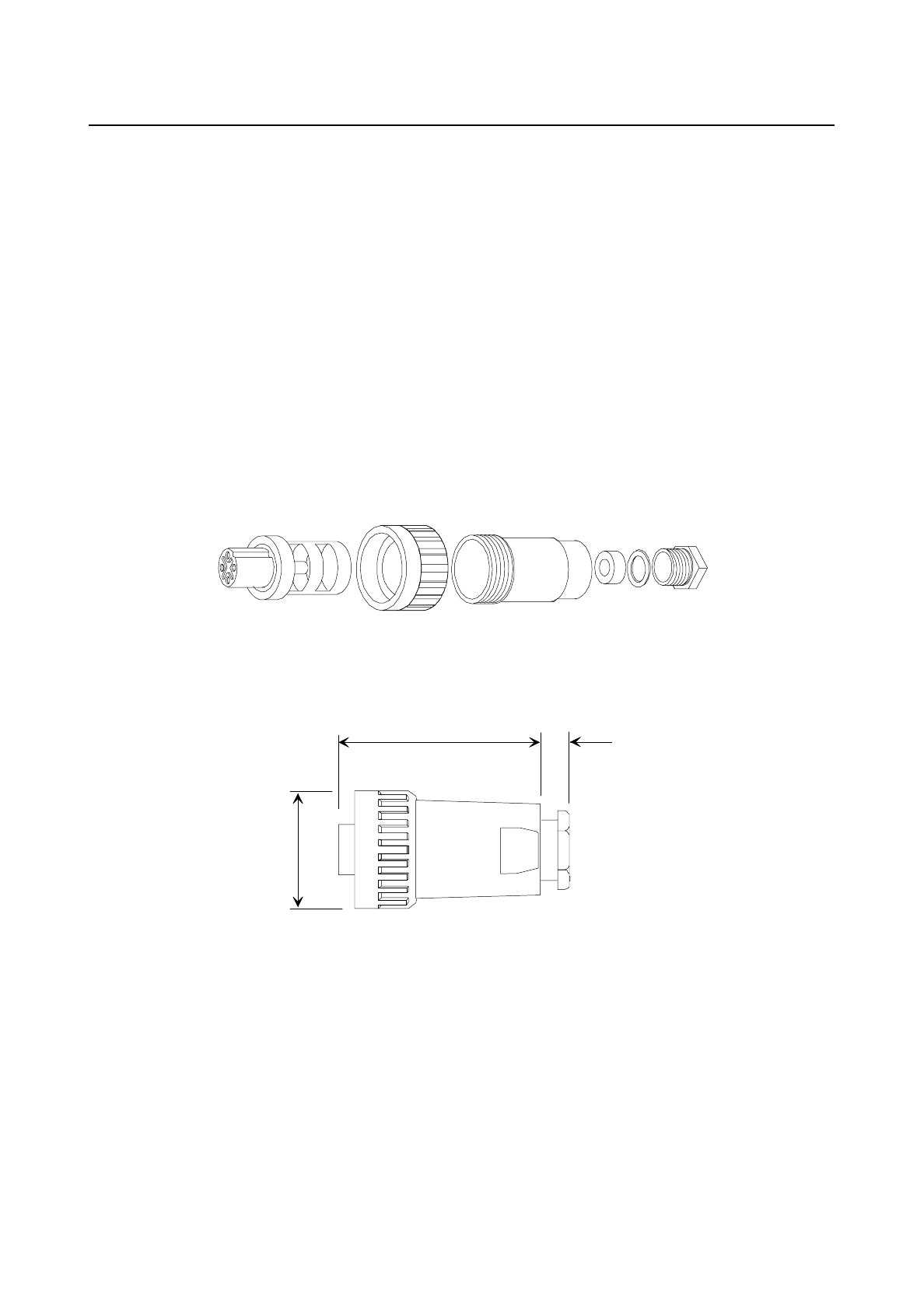
Installation Base Transceiver
IMN:BTSE BS11 Station Equipment
A30808-X3247-B359-2-7631 69
4. Appendix
4.1. AC Main Connector
4.1.1. Connector type
Type: Hirshmann CA 3 LD 09 ZS
OTE code: 24550000347
4.1.2. General view
4.1.3. Dimensions (mm)
65 10
Ø 28
4.1.4. Technical characteristics
- Insulation group DIN VDE 0110 C
- Continuous load current 16 A AC/10 A DC
- Contact resistance 3 mΩ
- Pin diameter 2 mm
- Type of connection screw
- Cable gland Pg 9, Pg 13,5
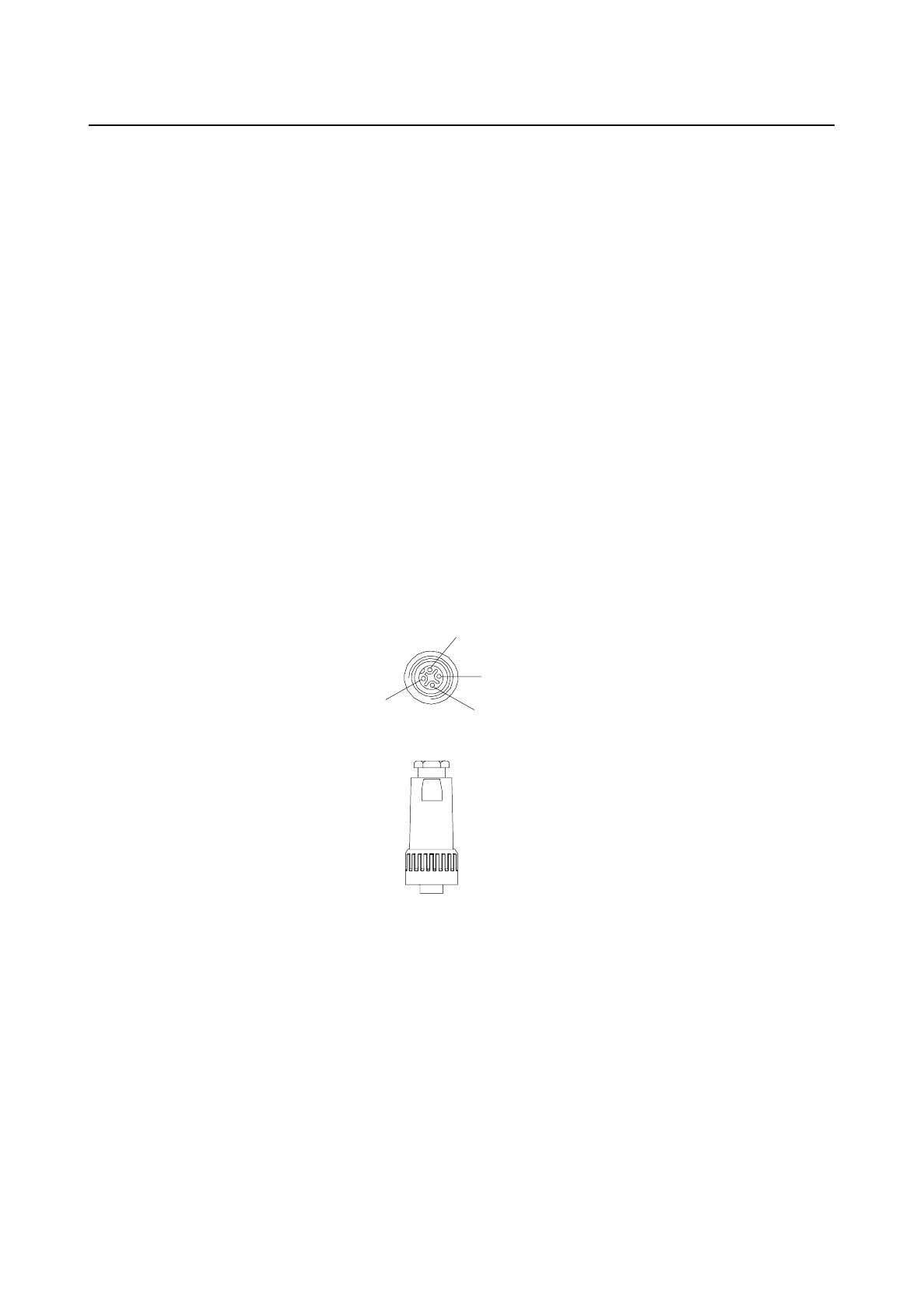
Base Transceiver Installation
Station Equipment IMN:BTSE BS11
70 A30808-X3247-B359-2-7631
- Outer lead diameter 6....12 mm
- Max lead cross-section 1,5 mm²/AWG 16
- Flammability UL standard 94 V - 0
- Protection class DIN 40 050 IP 65
- Ambient temperature range 40°C ÷ 90°C
4.1.5. Materials
- Contact material/surface CuZn/silver plate
- Contact beard PA 66-GF 25
- Casing PA 66-GF 25
- Sealing ring NBR
4.1.6. Pinning of Power Supply Socket
1
2
3
4
1 Phase
2 GND
3 Phase
4 Shield
4.1.7. Mounting of the cable-Movable socket
- Insert the cable fastener, the extension, the ring nut and the other connector
components on the cable (section 4.1.1).
- Cut the external cable sheath for a length of approx. 10 cm.
- Remove the conductor covering
- Carry out the connections indicated in section 4.1.2.
- Tighten the connector components.
- Connect the flying connector to the P1 connector
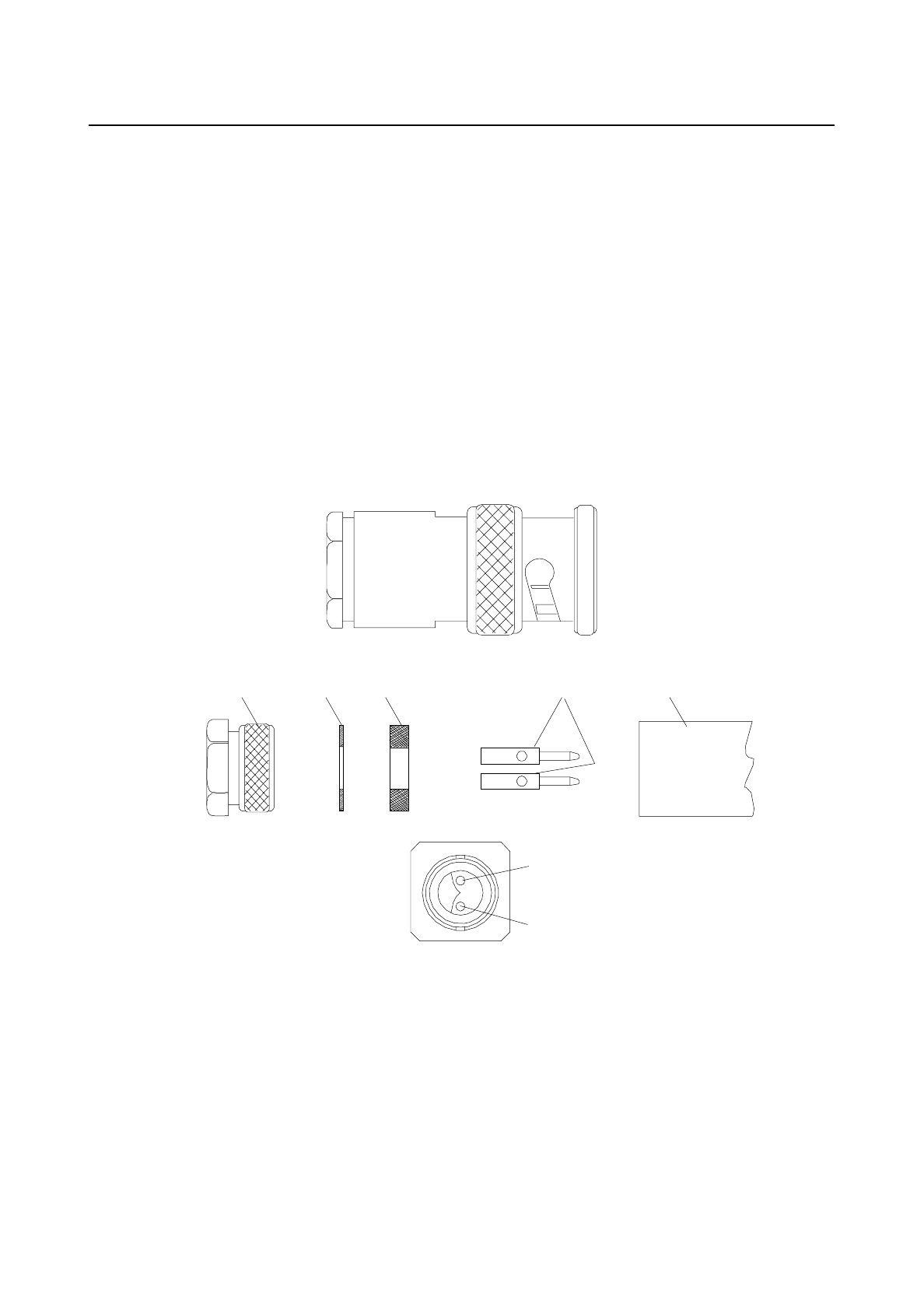
Installation Base Transceiver
IMN:BTSE BS11 Station Equipment
A30808-X3247-B359-2-7631 71
4.2. PCM Connector
4.2.1. Straight connector type
For cables with 6 ÷ 6.4 mm diameter
Type: Radiall R 605006
OTE code: 24508000430
For cables with 5 ÷ 5.5 mm diameter
Type: Radiall R 605005
4.2.2. General view
Clamp nut Washer Gasket Male/female
centre contacts Body
A2
A1
Panel connector
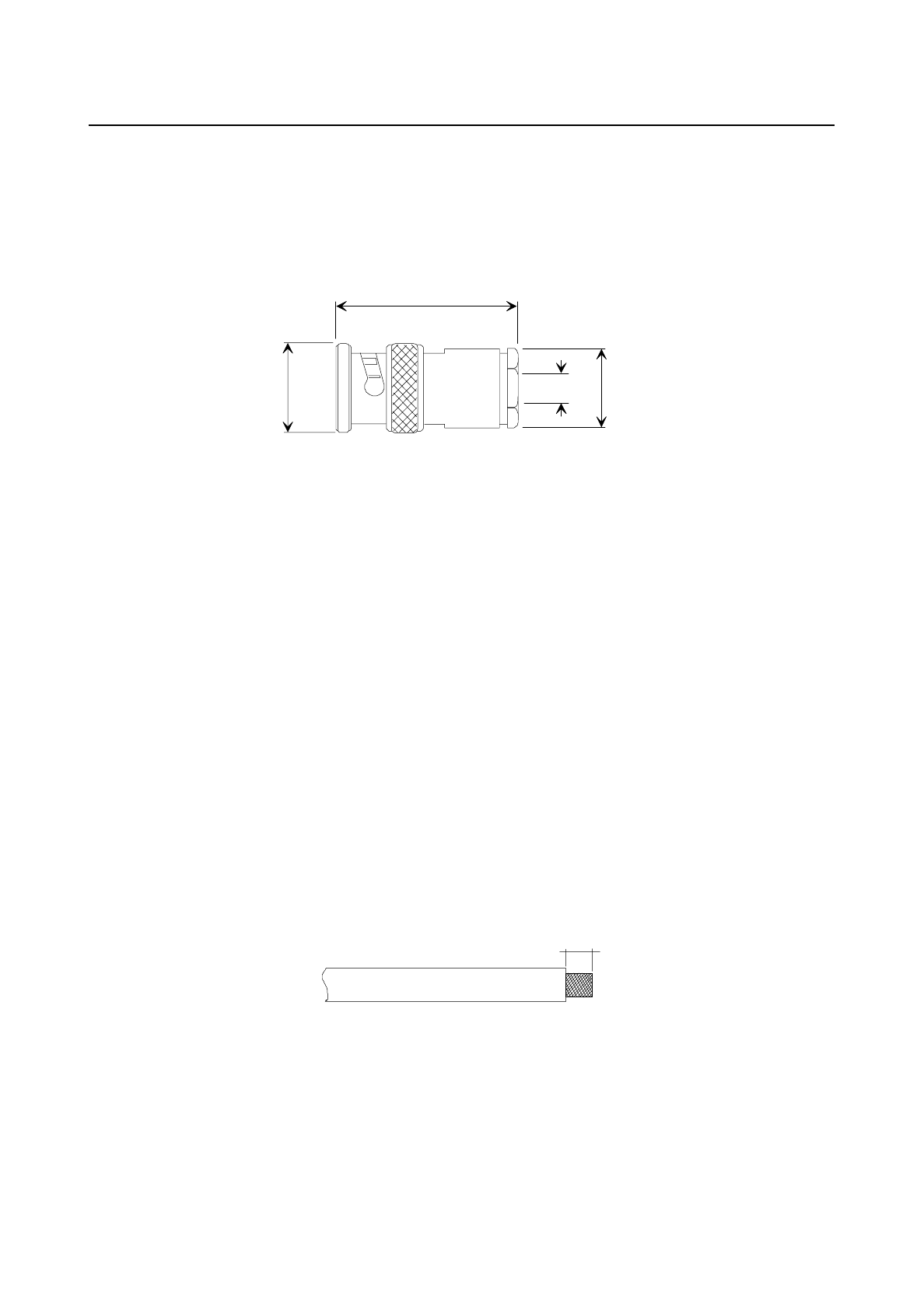
Base Transceiver Installation
Station Equipment IMN:BTSE BS11
72 A30808-X3247-B359-2-7631
4.2.3. Dimensions (mm)
31
Ø 12,7
Ø 14,3
4.2.4. General view
- Characteristic impedance 50 Ohm
- Operating frequency range to 10000 Mhz
- Test voltage: Unmated Mated
connector pair
Between centre conductor and inner screen 1500 V.rms 3000 V.rms
Between inner screen and outer screen 1000 V.rms 1000 V.rms
- Temperature range -55°C ÷+125°C
4.2.5. Mounting of cable on connector
- Strip the cable (dimensions in mm).
10
- Slide the clamp nut, the large diameter washer and gasket onto the cable.
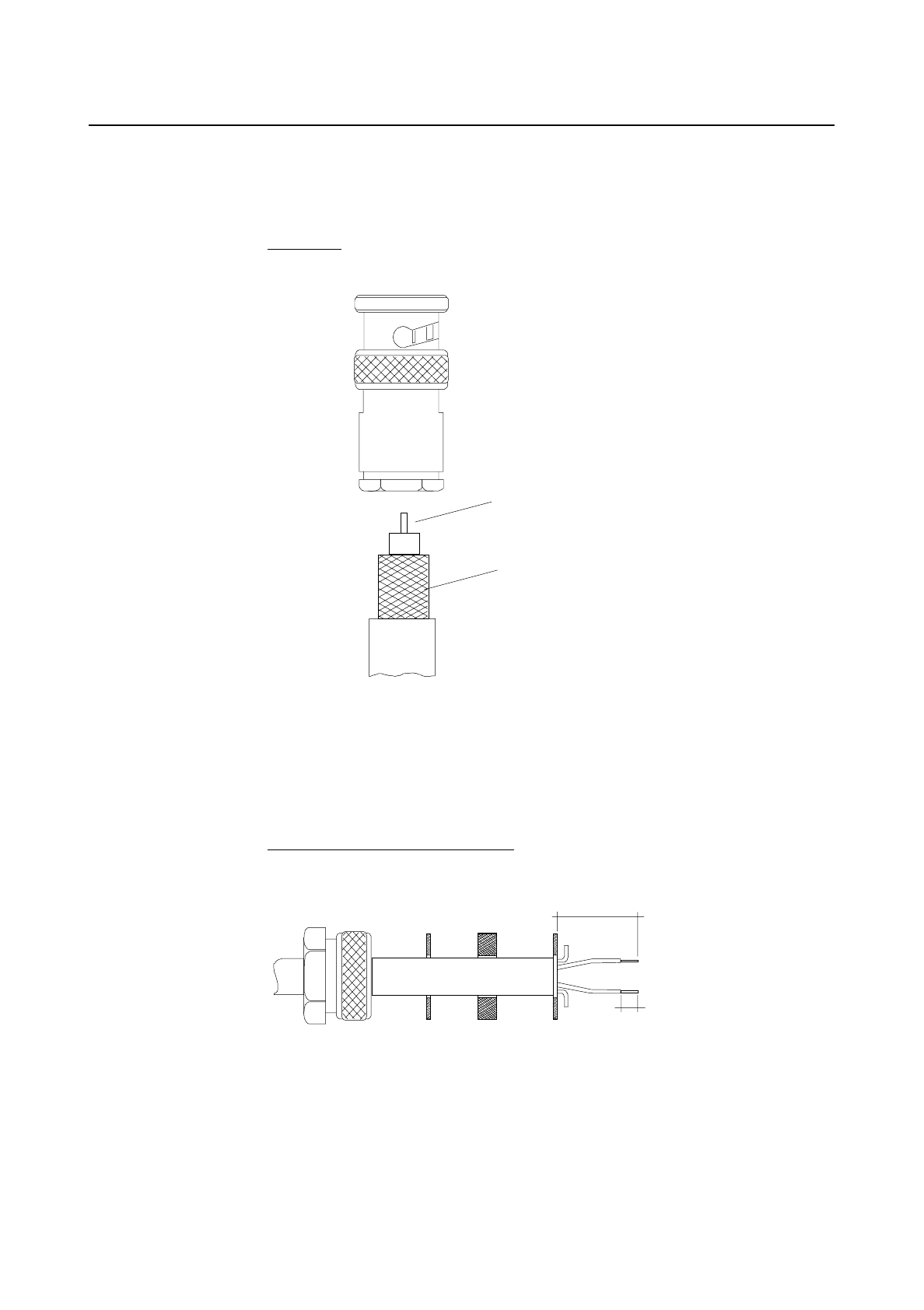
Installation Base Transceiver
IMN:BTSE BS11 Station Equipment
A30808-X3247-B359-2-7631 73
4.2.6. Connections
75 W coax
A1
Placed on
connector
body
- Connect only A1
- Connect the shield to the connector body.
120 W twisted pair with shield cable
9
4
- Slide smaller diameter washer until it bottoms against cable jacket.
- Fold back braid and trim to outside diameter of washer.
- Trimback dielectric as shown.
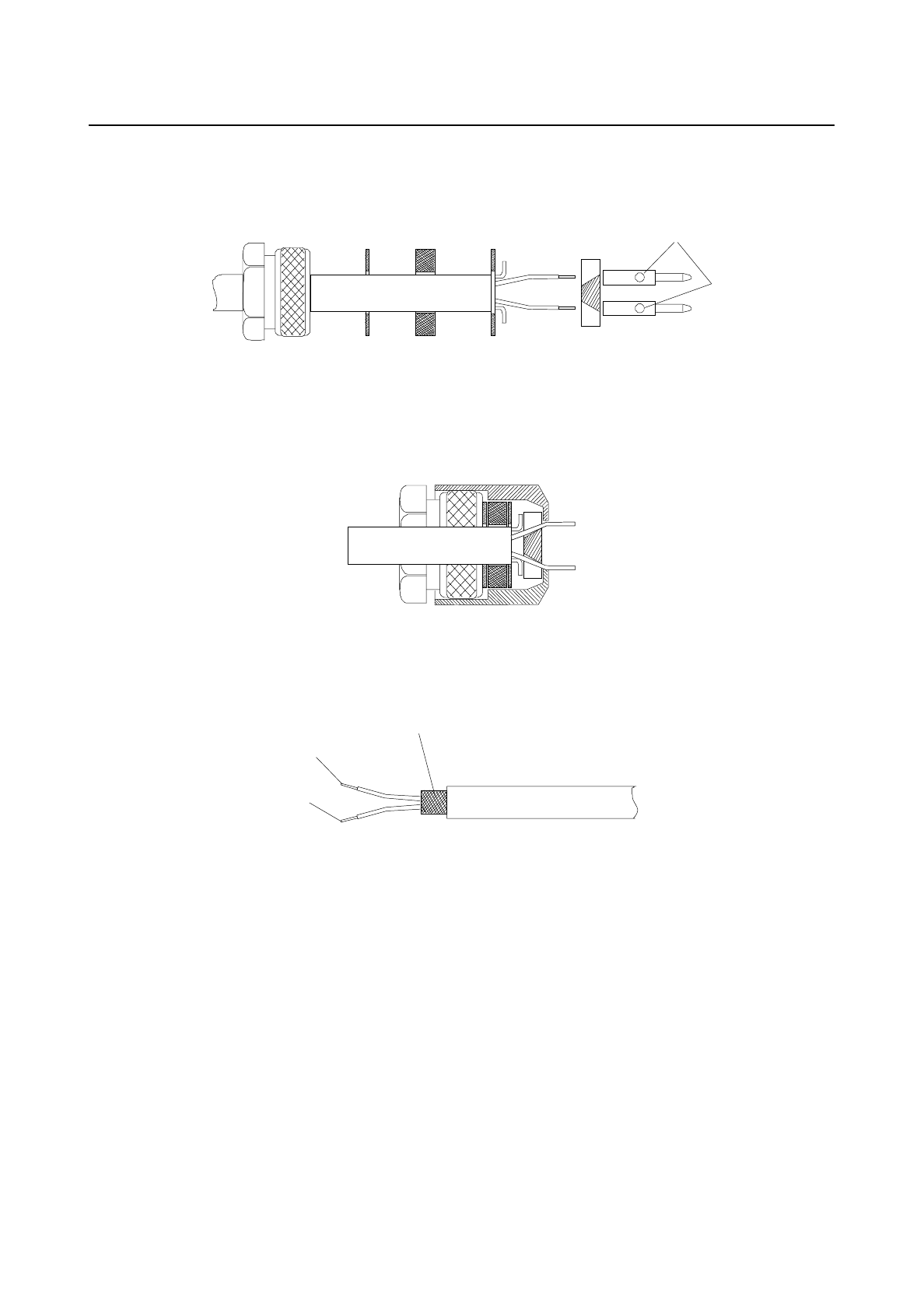
Base Transceiver Installation
Station Equipment IMN:BTSE BS11
74 A30808-X3247-B359-2-7631
- Slide smaller diameter washer and the separator.
Solder
- Solder centre contacts on to inner conductor.
- Screw sub-assembly into the connector body (recommended coupling torque:
450 cm. N).
A1
A2
Placed on
connector
body
- Connect A1 and A2.
- Connect the shield to the connector body.
4.3. RF Connector Type N N15015 C4 GN-1
4.3.1. Connector type
Coaxial Connector Male for cable RT 5020 (RG 214)
Type: N N15015C4 GN-1
OTE code: 24504000018
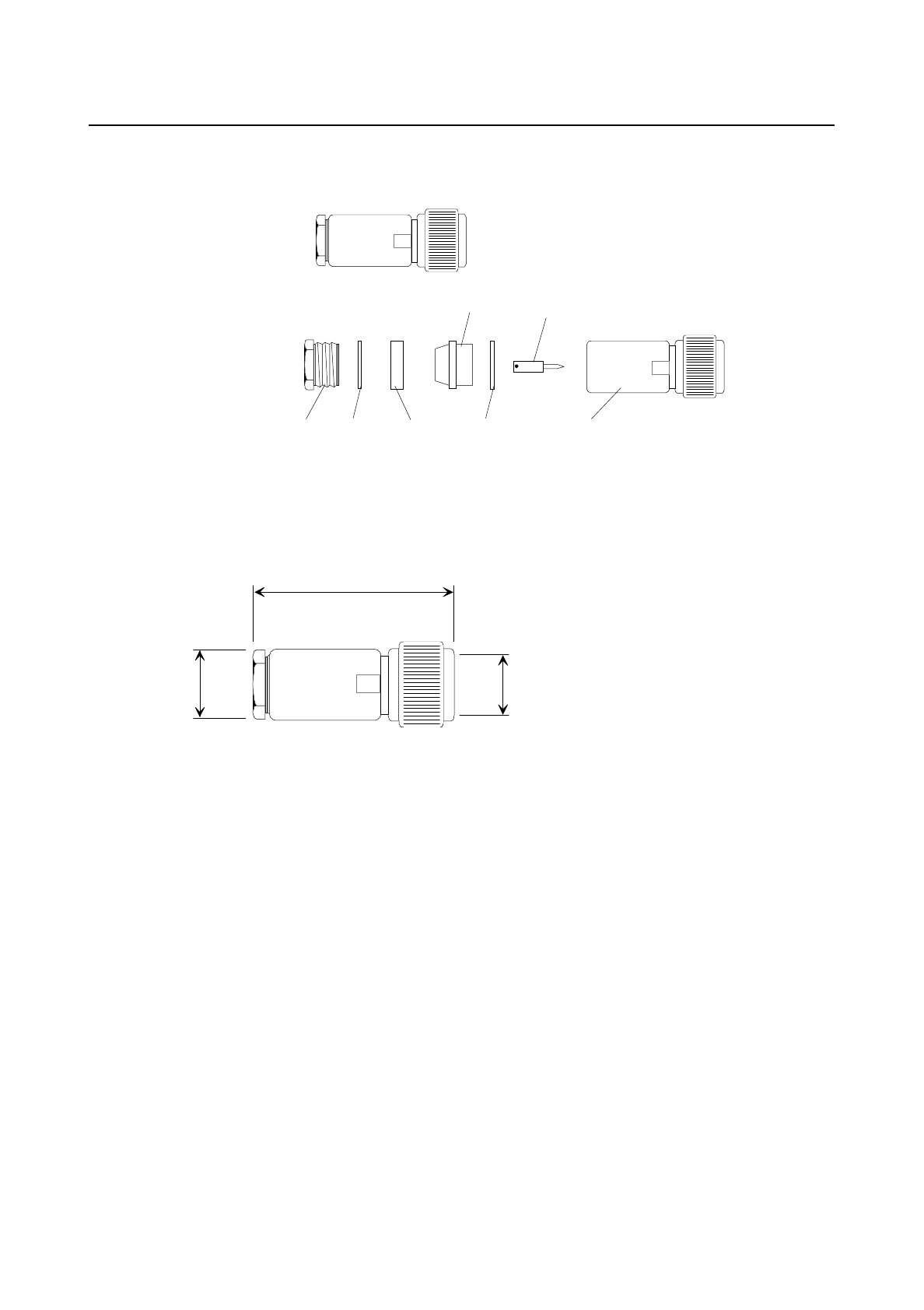
Installation Base Transceiver
IMN:BTSE BS11 Station Equipment
A30808-X3247-B359-2-7631 75
4.3.2. General view
Rear Nut Washer Gasket Washer Connector body
Central
contact
Central
column
4.3.3. Dimensions (mm)
43,9
Ø 19,1
Ø 20,6
4.3.4. Technical characteristics
- Characteristic impedance 50 Ohm
- Frequency range DC÷11 GHz
- Insertion loss <0,15 dB at 10 GHz
- Working voltage 1000 Veff/50 Hz
- Insulation voltage 2500 Veff/50 Hz
- Insulation resistance >5000 MOhm
- Contact resistance 1 Mohm (central contact)
0,25 Mohm (external contact)
- Temperature range -65°C÷+165°C
- Maximum power 1000 W (DC÷100MHz)
300 W (101 MHz÷ 1000 MHz)
150 W (1001 MHz÷3000 MHz)
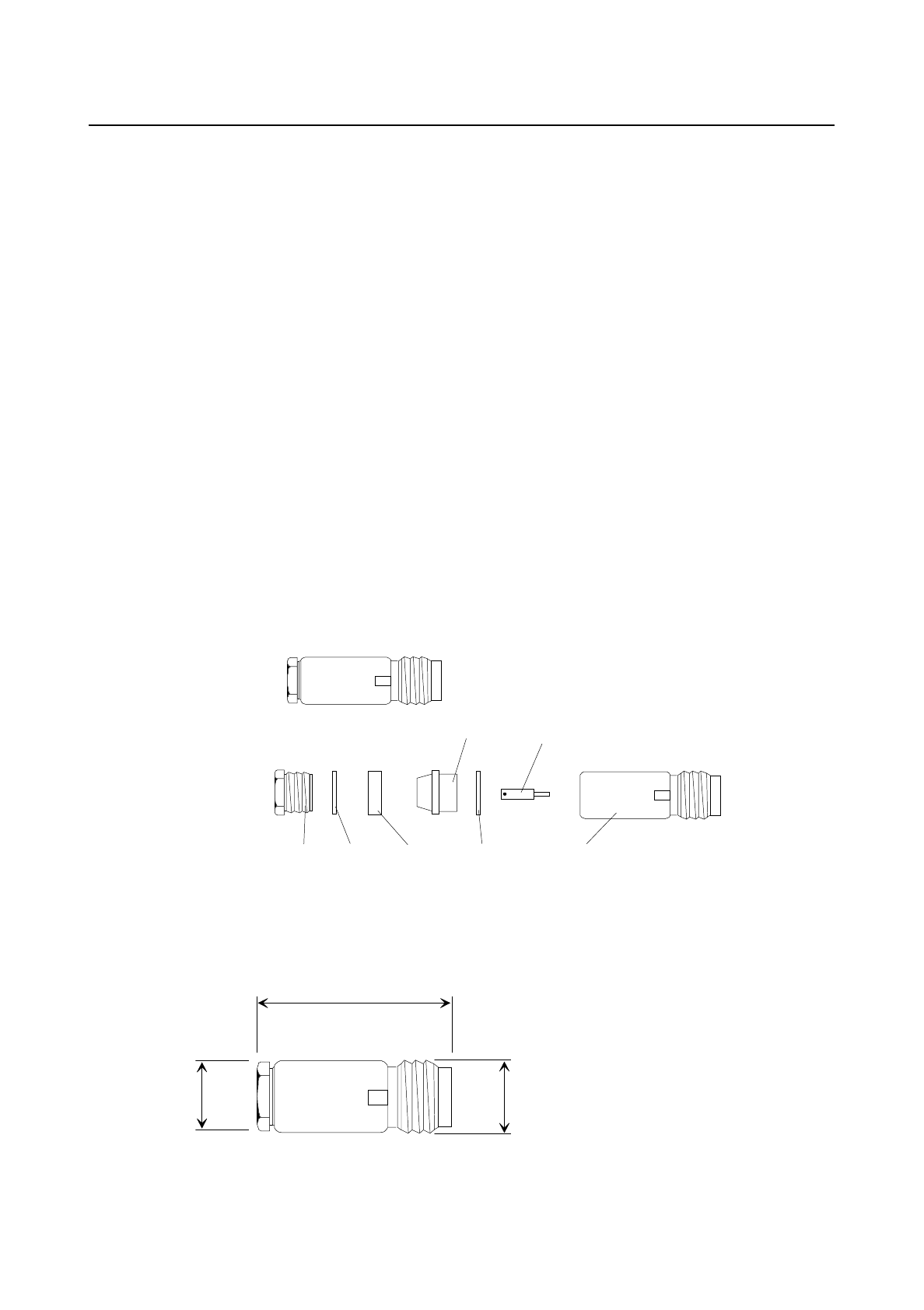
Base Transceiver Installation
Station Equipment IMN:BTSE BS11
76 A30808-X3247-B359-2-7631
4.3.5. Materials
- Contacts and interfaces Beryllium bronze
- Other metallic parts Brass (nickel or silver treated)
- Sealing rings Silicon rubber
- Insulating parts PTFE
- Central contacts Gold plated
4.4. RF Connector Type N N15022 C4 G-1
4.4.1. Connector type
Coaxial Connector Female for cable RT 5020
Type: N N15022 C4 G-1
OTE code: 24504000025
4.4.2. General view
Rear Nut Washer Gasket Washer Connector body
Central
contact
Central
column
4.4.3. Dimensions (mm)
39,7
Ø 19,1
Ø 15,9

Installation Base Transceiver
IMN:BTSE BS11 Station Equipment
A30808-X3247-B359-2-7631 77
4.4.4. Technical characteristics
- Characteristic impedance 50 Ohm
- Frequency range DC÷11 GHz
- Insertion loss <0,15 dB at 10 GHz
- Working voltage 1000 Veff/50 Hz
- Insulation voltage 2500 Veff/50 Hz
- Insulation resistance >5000 MOhm
- Contact resistance 1 Mohm (central contact)
0,25 Mohm (external contact)
- Temperature range -65°C÷+165°C
- Maximum power 1000 W (DC÷100MHz)
300 W (101 MHz÷ 1000 MHz)
150 W (1001 MHz÷3000 MHz)
4.4.5. Materials
- Contacts and interfaces Beryllium bronze
- Other metallic parts Brass (nickel or silver treated)
- Sealing rings Silicon rubber
- Insulating parts PTFE
- Central contacts Gold plated
4.5. RF Connector Type N for ½” cable
4.5.1. Connector type
Coaxial Connector Male
Type: N for ½” cable
OTE code: 24504003077
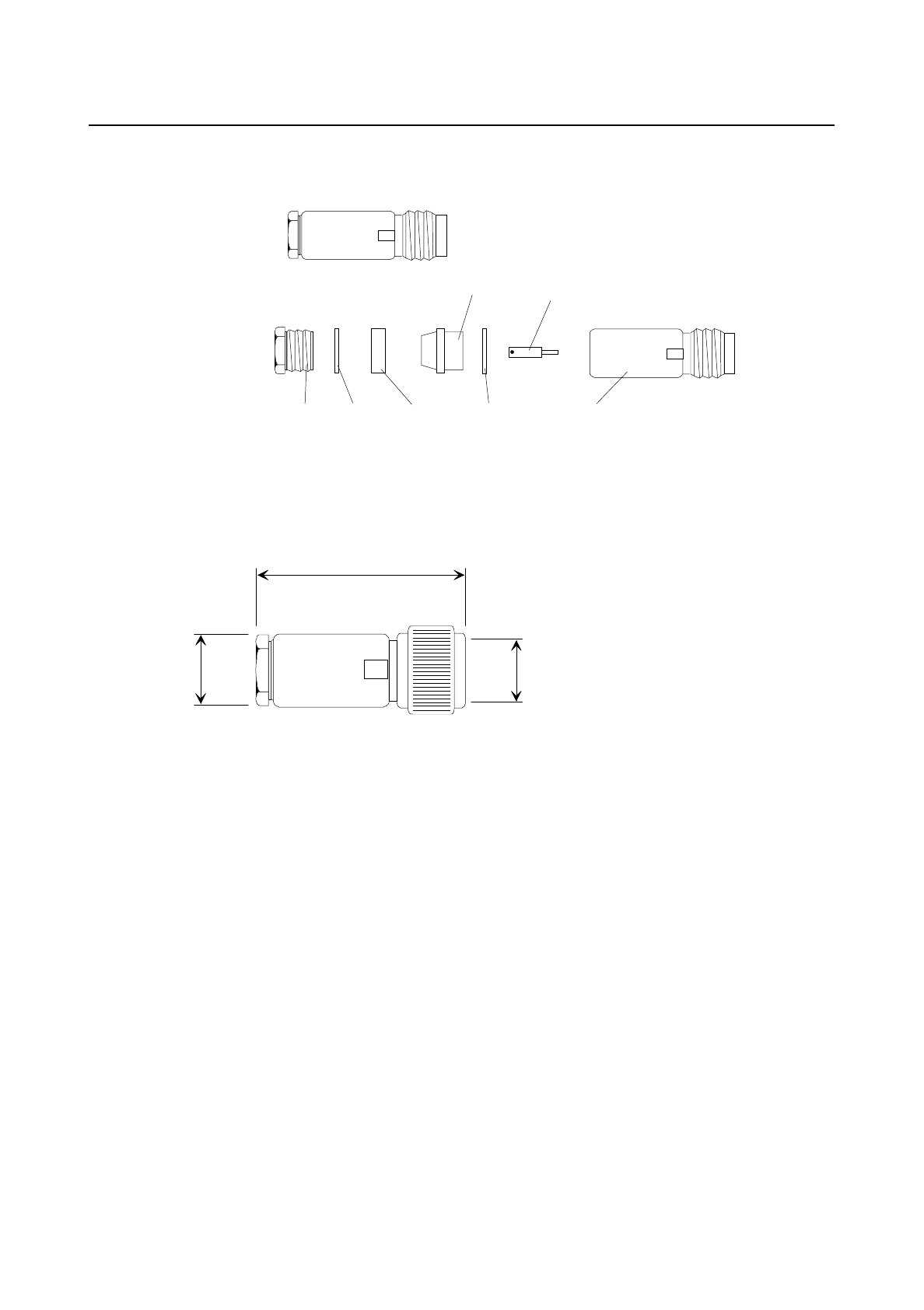
Base Transceiver Installation
Station Equipment IMN:BTSE BS11
78 A30808-X3247-B359-2-7631
4.5.2. General view
Rear Nut Washer Gasket Washer Connector body
Central
contact
Central
column
4.5.3. Dimensions (mm)
72,0
Ø 24,0
Ø 20,6
4.5.4. Technical characteristics
- Characteristic impedance 50 Ohm
- Frequency range DC÷11 GHz
- Insertion loss <0,15 dB at 10 GHz
- Working voltage 1000 Veff/50 Hz
- Insulation voltage 2500 Veff/50 Hz
- Insulation resistance >5000 MOhm
- Contact resistance 1 Mohm (central contact)
0,25 Mohm (external contact)
- Temperature range -65°C÷+165°C
- Maximum power 1000 W (DC÷100MHz)
300 W (101 MHz÷ 1000 MHz)
150 W (1001 MHz÷3000 MHz)
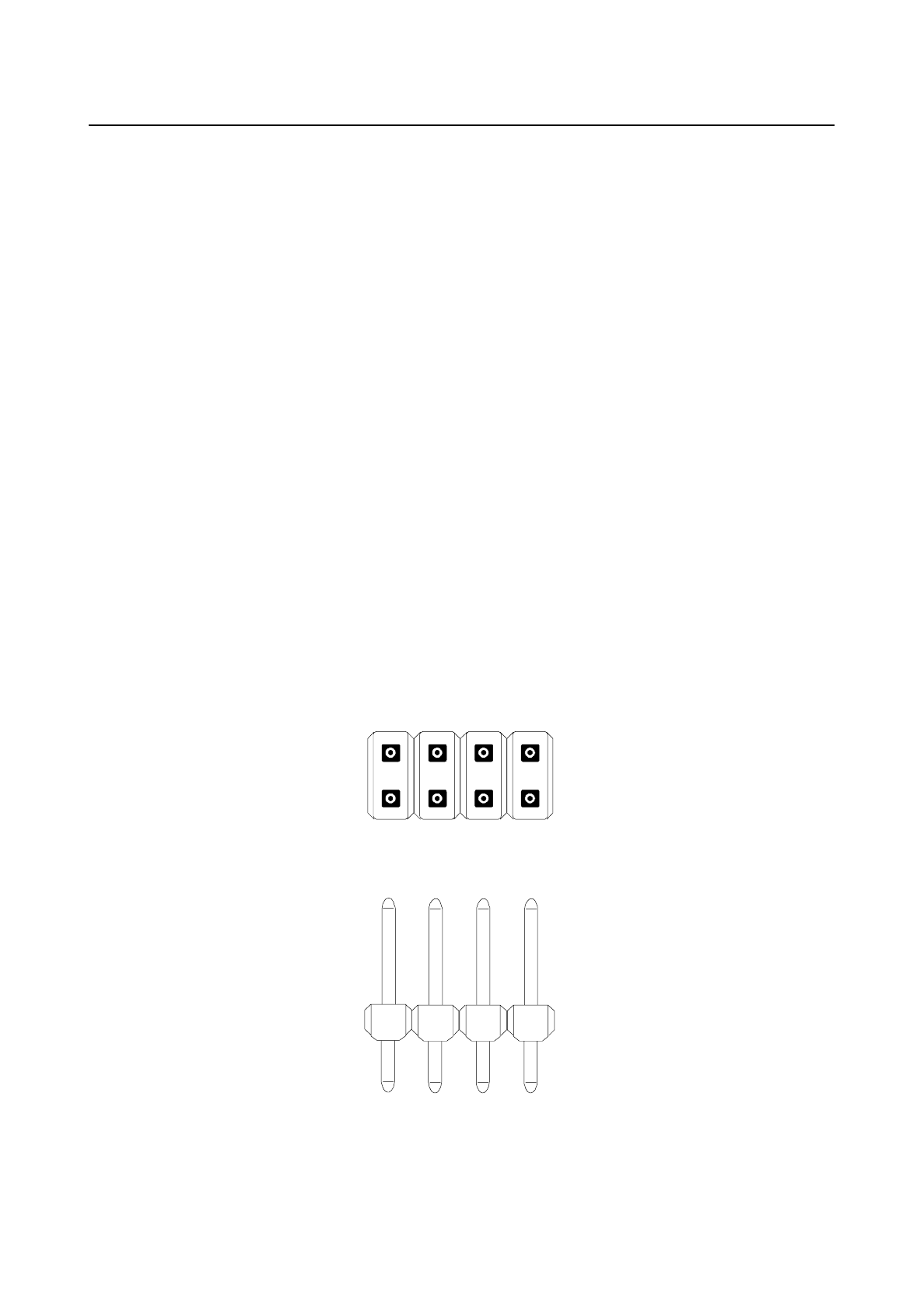
Installation Base Transceiver
IMN:BTSE BS11 Station Equipment
A30808-X3247-B359-2-7631 79
4.5.5. Materials
- Contacts and interfaces Beryllium bronze
- Other metallic parts Brass (nickel or silver treated)
- Sealing rings Silicon rubber
- Insulating parts PTFE
- Central contacts Gold plated
4.6. Alarm Connector
4.6.1. Connector type
Type: AMP MODU II 280365
4x2 in double file
OTE code: 24301000266
You need also 8 contacts for each connector (OTE code: 24320000010).
4.6.2. General view
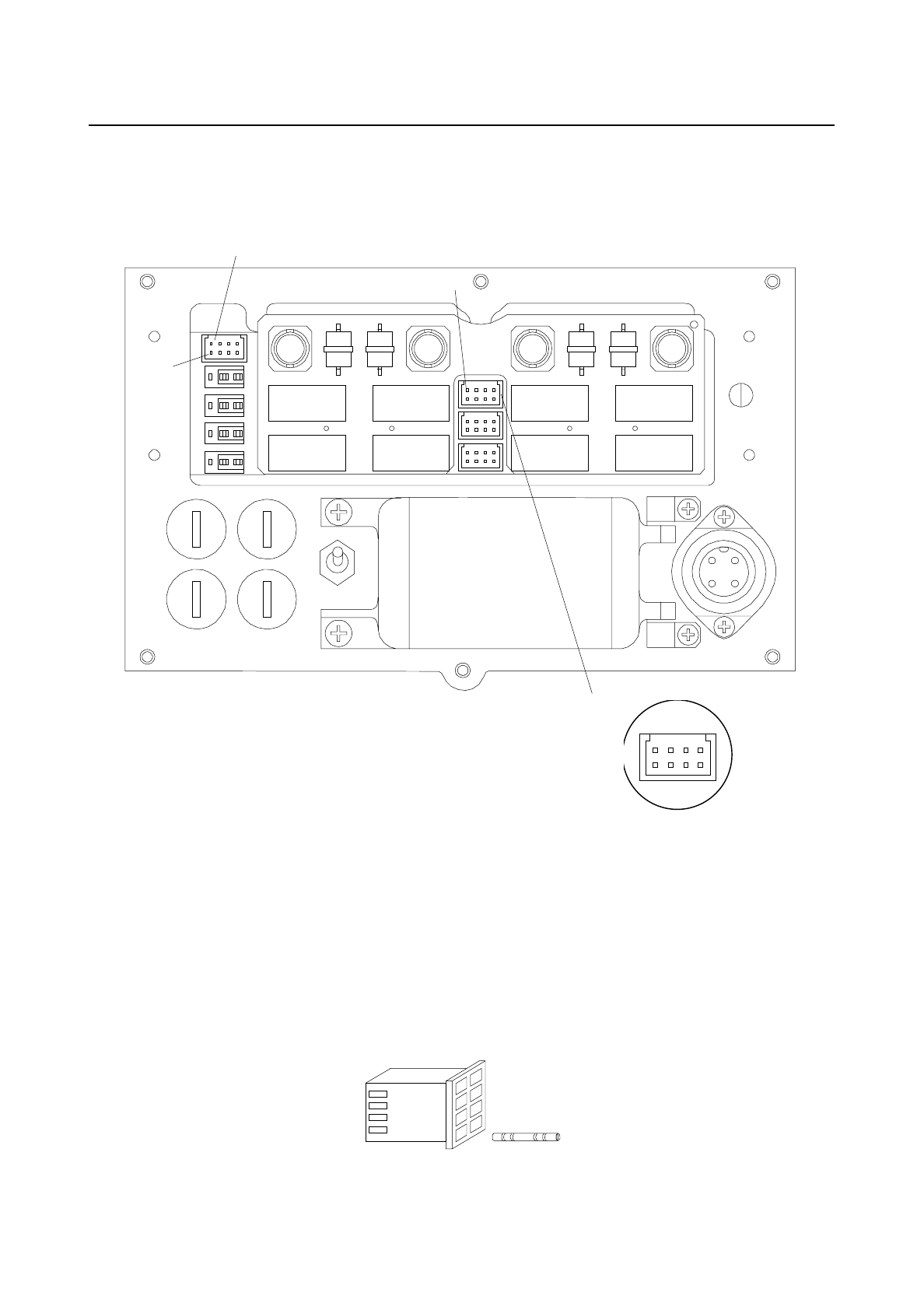
Base Transceiver Installation
Station Equipment IMN:BTSE BS11
80 A30808-X3247-B359-2-7631
4.6.3. Pinning of J01 and J02 connector
JØ1
JØ2
pin1
JØ1
2 TFN1
3 Not connected
4 Allext 1
5 Allext 2
6 Allext 3
7 Allext 4
8 GND
JØ2
2 Not connected
3 Tx to PC
4 Rx from PC
5 Not connected
6 Not connected
7 Not connected
8 GND
pin1
1 TFNØ 1 Not connected2
1
4
3
6
5
8
7
2
1
4
3
6
5
8
7
4.6.4. Mounting of the straight cable socket
- Strip the cable conductors (for J01 and J02) approx. 3 mm.
- Crimp the contacts to the conductors (8 for each cable).
- Insert the contact of the contactor until locked in place.
- Insert a thermo-tightening sheath between the connector and the cable.
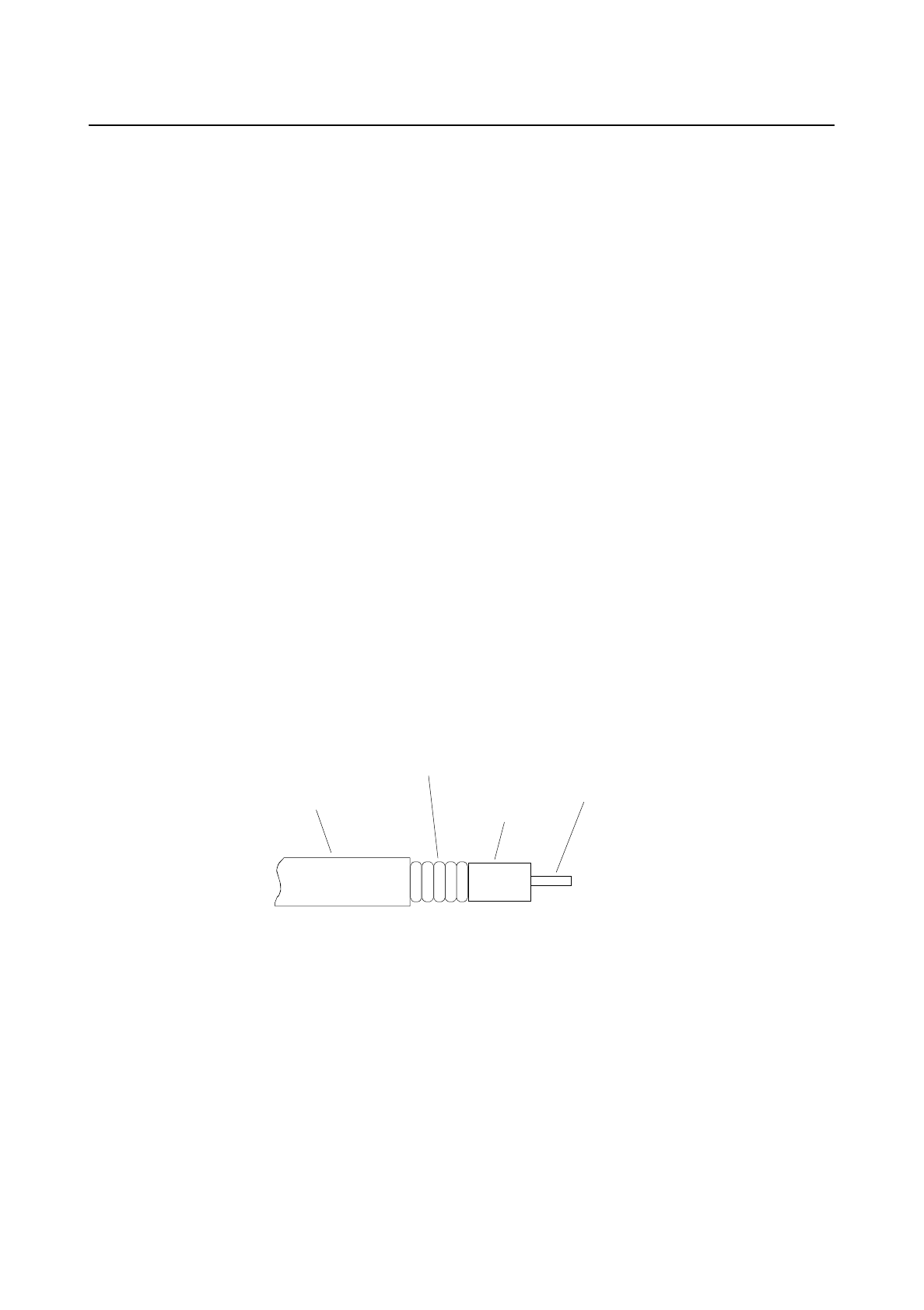
Installation Base Transceiver
IMN:BTSE BS11 Station Equipment
A30808-X3247-B359-2-7631 81
4.7. Coaxial Cables
4.7.1. ½” cable (OTE code: 22580000175)
Technical characteristics
- Impedance 50 Ohm
- Maximum work voltage 1590 V
- Attenuation at 0,5 GHz 5 dB / 100 mt
Dimensions
- Care conductor Ø 4,9 mm
- Dielectric Ø 11,6 mm
- Outer tubular conductor Ø 13,7 mm
- Outer sheath Ø 16 mm
Materials
- Care conductor Copper
- Dielectric Foam PE
- Outer tubular conductor Copper
- Outer sheath Polyethylene (black)
Care
conductor
Dielectric
Outer
contact
Outer
sheath
4.7.2. Cable RT 5020
Technical characteristics
- Impedance 50 Ohm ± 2
- Attenuation at 900 MHz 9 dB / 100 mt
Dimensions
- Care conductor Ø 26 mm
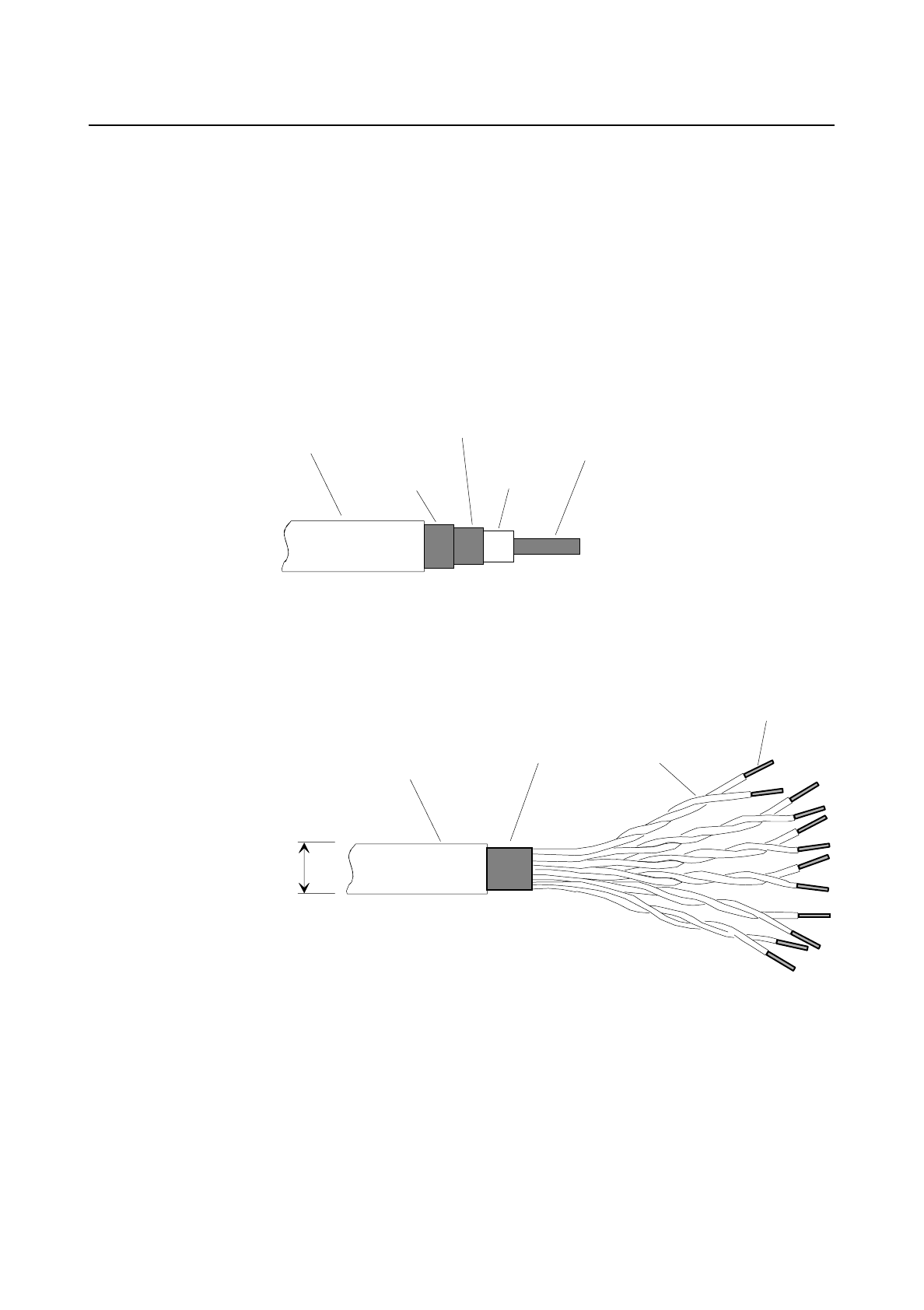
Base Transceiver Installation
Station Equipment IMN:BTSE BS11
82 A30808-X3247-B359-2-7631
- Dielectric Ø 7,1 mm
- Outer sheath Ø 10,3 mm
Materials
- Care conductor Copper
- Dielectric Cellular polyethylene (PES)
- Outer conductor Copper (n° 2 shields)
- Outer sheath Polyethylene (PE)
Care
conductor
Dielectric
Outer
sheath
Scield 1
Scield 2
4.8. Alarm Cable (OTE Code 22401200528)
1
2
3
4
Ø A
1. Flexible wire 18x0,1 (normal section = 0,14 mm² AWG26), material tinning
copper insulated PVC (gage of the insulated = 0,3), major diameter wire =
1,15 mm.
2. Couple wires to helix lacing, lead 30÷40 mm with distribution colours of the
wire are listed us follows:
Colours of the couple wires:
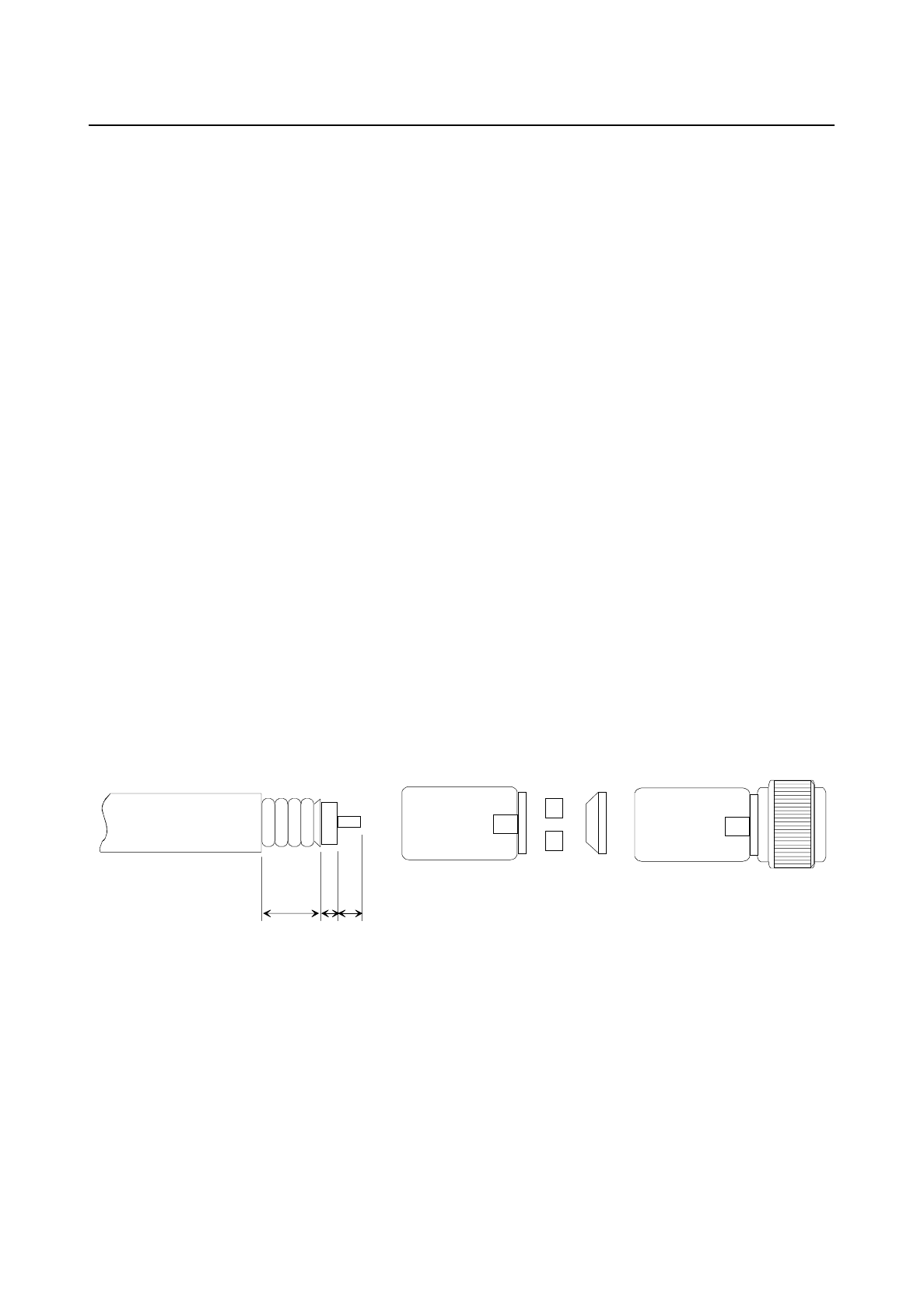
Installation Base Transceiver
IMN:BTSE BS11 Station Equipment
A30808-X3247-B359-2-7631 83
Violet - orange
Grey - brown
Pink - black
White - red
3. Braited wire to cotton or rayon
4. Blanket insulation to PVC (colour grey) gage 0,7 mm.
Conductor number : 8 (4 couple)
Diameter : 6 : 6,5
Voltage rating : 250 Vcc
Voltage test : 1000 Vrms
Minimum bend radius : 2x major diameter
4.9. Radio Frequency Cables Assembly
4.9.1 ½” Cable Assembly to type “N” connectors (dimensions in
mm)
22,5 7 11
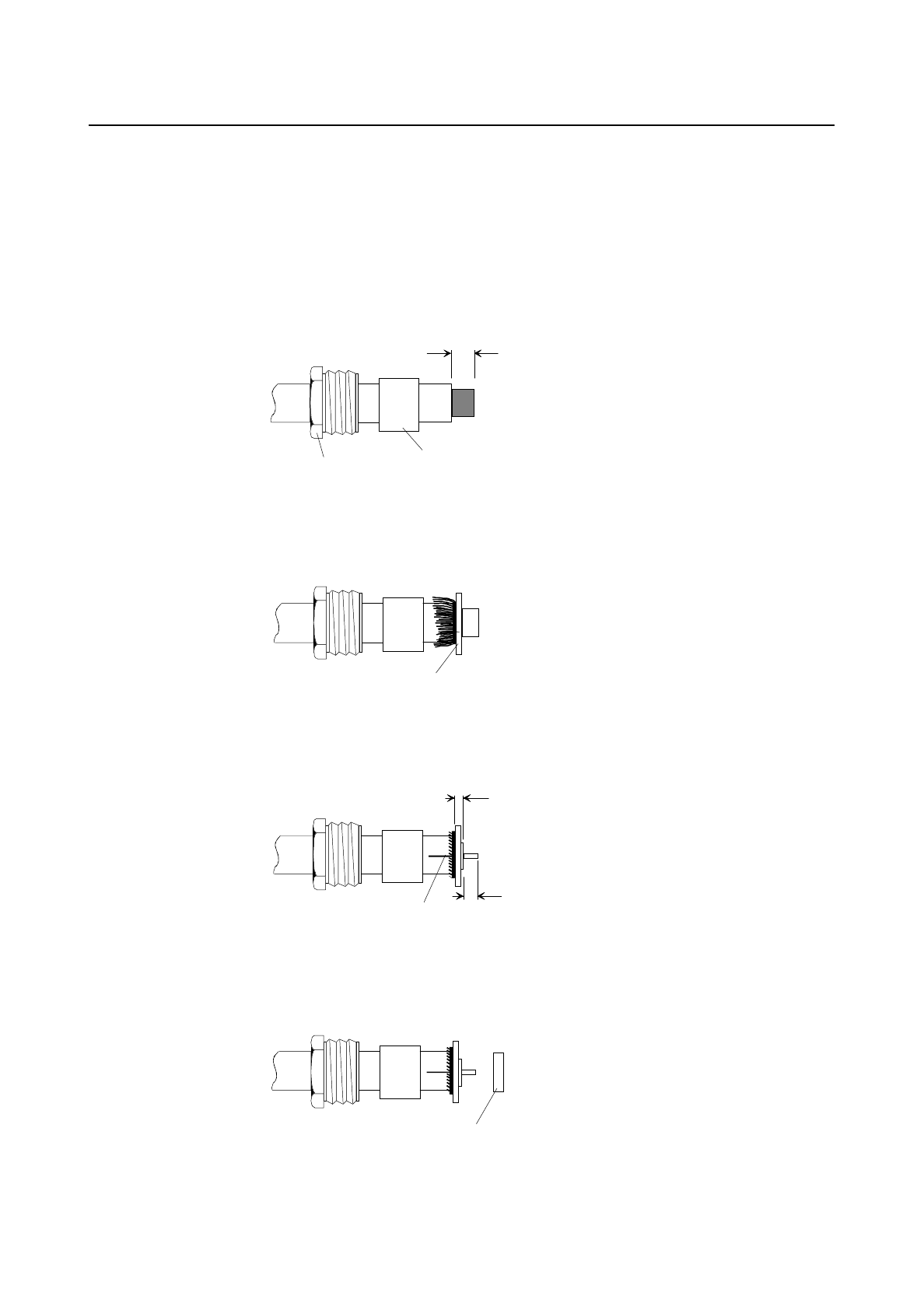
Base Transceiver Installation
Station Equipment IMN:BTSE BS11
84 A30808-X3247-B359-2-7631
4.9.2 RT 5020 Cable Assembly
Instructions
1. Glide clamp nut and plain gasket over cable and trim outer sheath from cable
as shown.
7,0
plain
g
asket
clamp nut
2. Fold back braid and push ferrule over dielectric to trap braid between outer
sheath and ferrule. Trim off surplus braid.
ferrule
3. Trim back dielectric and check the length of the centre conductor.
0,5
5,5
cut outer sheat
4. Tin centre conductor, thenslide rear insulator over dielectric to bull against
ferrule.
rear insulator
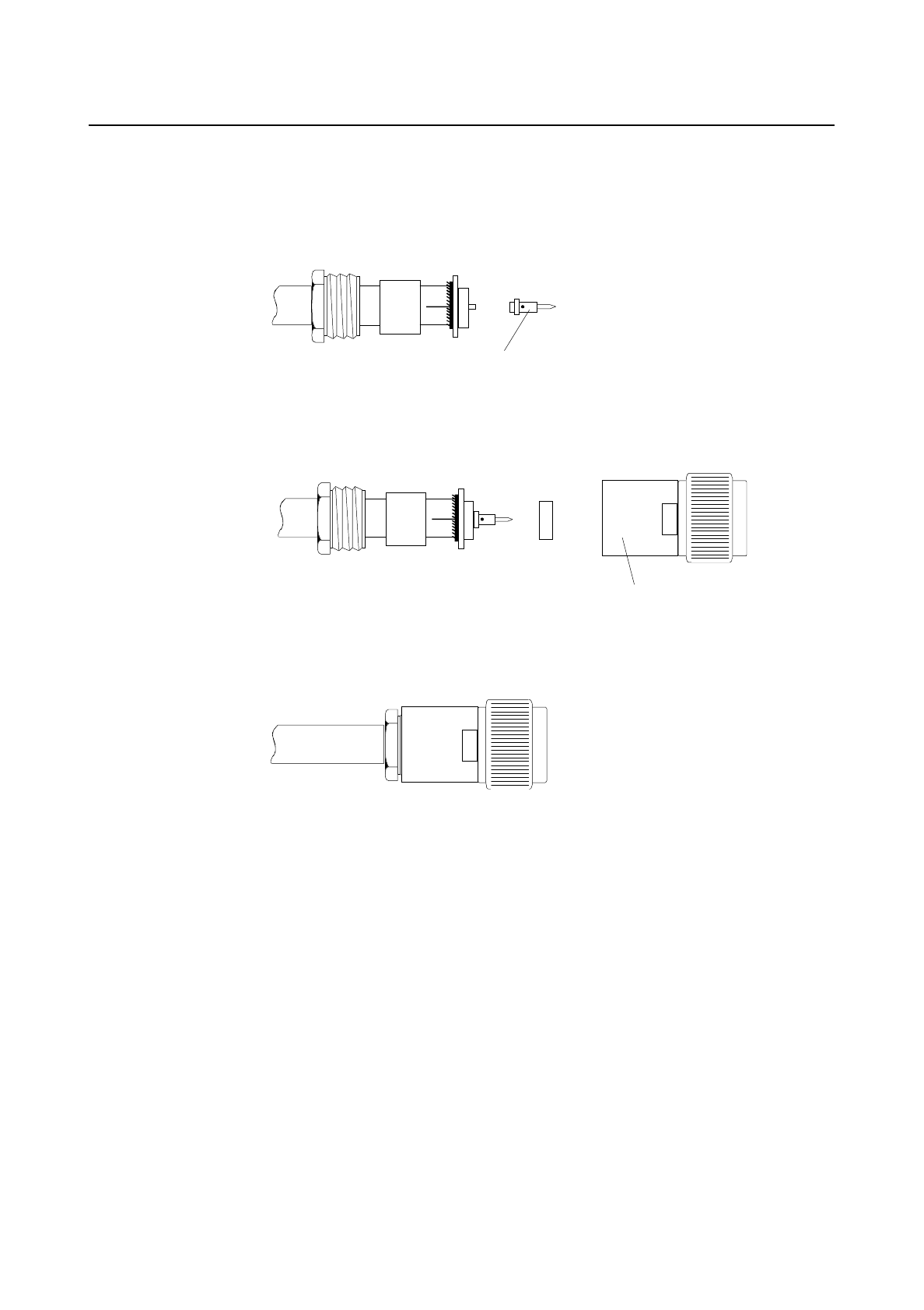
Installation Base Transceiver
IMN:BTSE BS11 Station Equipment
A30808-X3247-B359-2-7631 85
5. Fit contact (male for plugs, female for jack) onto centre conductor. Hold cable
and contact tightly together and solder
male contact
6. Slide plain gasket and clamp nut up to ferrule trapping braid. Fit front insulator
over contact to bull against rear isolator and press sub-assembly into body as
for as possible.
front insulator
bod
y
7. Engage and tighten clamp nut.
NOTE: a plug body is shown, but these instructions are relevant to both plugs
and jack. The characteristics of the contacts and insulator may vary
from the drawings shown.
4.10. LMT Cable for BTSE
4.10.1. Composition of LMT Cable
- Connector AMP MODU II type female for crimp
contacts (quantity 1,code MSPA 67263-10/044)
- Female crimp contacts AMP (quantity 3,code
MSPA 67263-10/101)
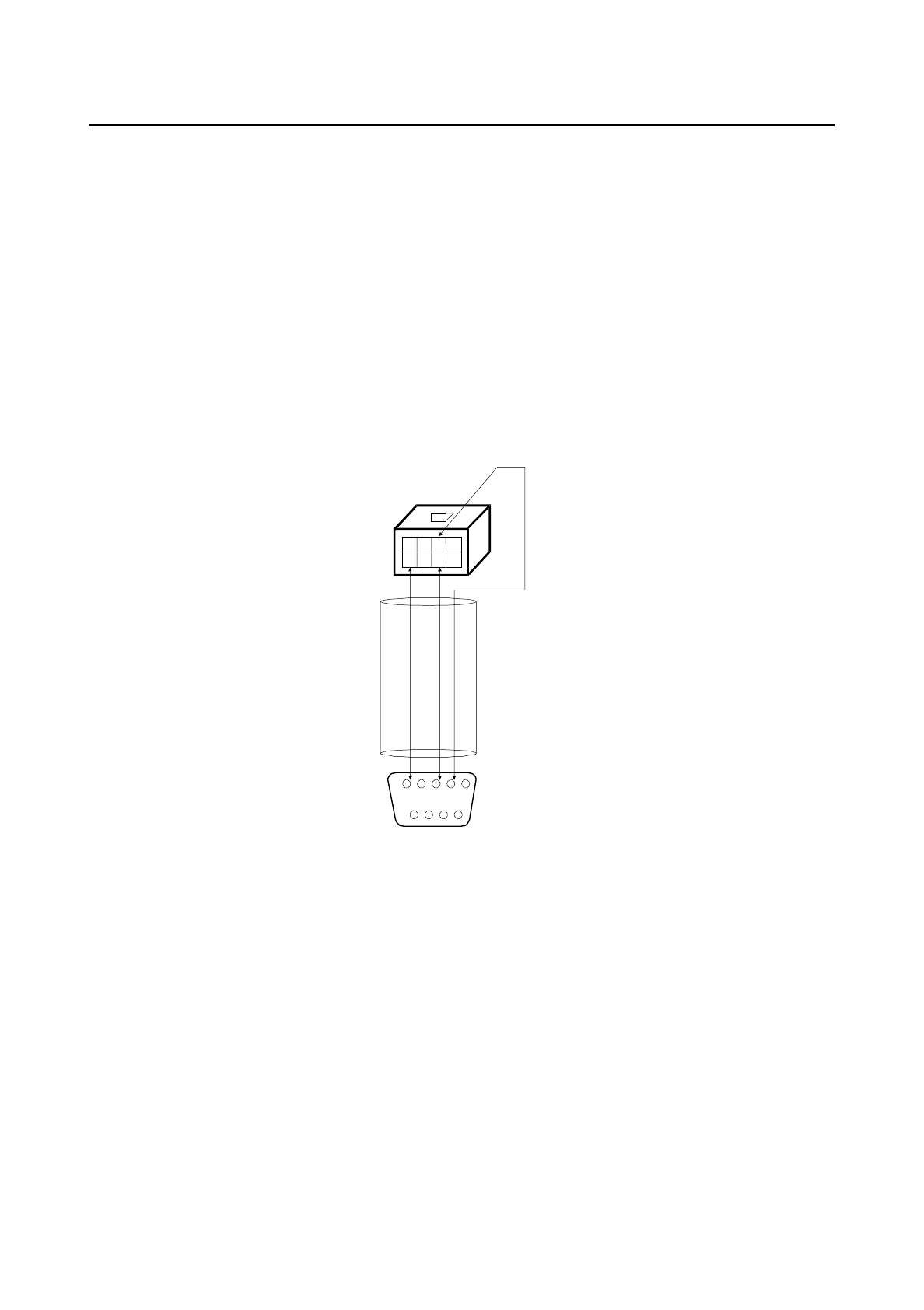
Base Transceiver Installation
Station Equipment IMN:BTSE BS11
86 A30808-X3247-B359-2-7631
- Female connectors 9 wais without conctacts
(quantity 1,code MSPA 67316-12/002)
- Female conctact AWG 24/28 (quantity 3,code
MSPA 67316-12/053)
- Plastic cap for connector (quantity 1,code MSPA
67316-60/019)
- 4 Pairs not shielded cable (quantity 2.5m,code
MSPA 55650-11/002)
4.10.2. General view
7
AMP MODU Connector
Not schielding cable
Connector Pin 2 UART_TX 2
Pin 3 UART_RX 2
Pin 5 GND
Pin 3 UART_TX 2
Pin 4 UART_RX 2
Pin 8 GND
Rear view
Front view 7
8
89
5
5
6
6
3
3
4
4
1
1
2
2

Installation IMN/ITMN:Micro-BTS-IS BR3.1
Installation/Installation and Test Manual Abbreviations
A30808-X3247-B359-2-7631 87
5. Abbreviations
BS-11e/900.1 BTSE with external antenna and single TRX
BS-11i/900.1 BTSE with integrated antenna and single TRX
BSC Base Station Controller
BSS Base Station System
D900 Siemens BSS 900 MHz
GSM Global System for Mobile communications
IMN Installation Manual
IMN Installation Manual
LMT Local Maintenance Terminal
LNA Low Noise Amplifier
MBBCU MultiBand Base Central Unit
BTSE Base Transceiver Station Equipment
MS Mobile Station
OMC Operation and Maintenance Center
PA Power Amplifier
PCM Pulse Code Modulation
PSU Power Supply Unit
RX Receiver
SVR System Version Release
SW Software
TCH Traffic Channel
TRAU Transcading and Rate Adaptation Unit
TX Transmitter
UMN User’s Manual